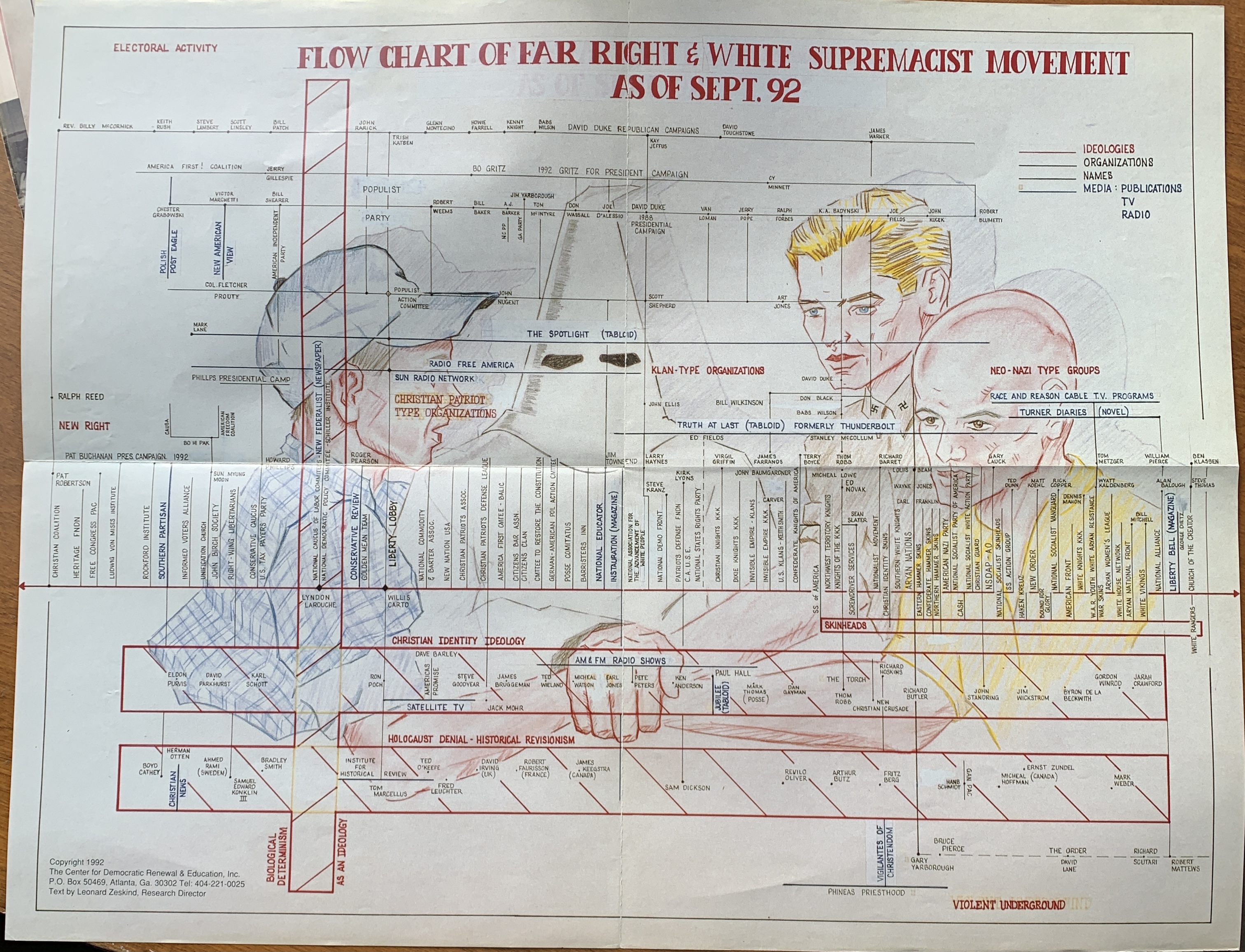
Flow Chart of Far Right and White Supremacist Organizing–Center for Democratic Renewal 1992. What does 2022 look like? Compare and Contrast.

Flow Chart of Far Right and White Supremacist Organizing–Center for Democratic Renewal 1992. What does 2022 look like? Compare and Contrast.
Tags
Aryan Nations, Aryan Youth Congress, Chris Lord, coalition for human dignity, Dean Kitzmiller, Derek Stenzel, Dylan Wheeler, Intimidation One, Jason Stevens, Joe Witt, National Socialist Front, Northwest Concern, Portland Oregon, Randall Krager, Salem Oregon, Troy Harlow, Volksfront, Zachary Taylor
From the Coalition for Human Dignity’s Northwest Update, November 1, 1997.

From the Coalition for Human Dignity’s Dignity Report (“Dig Rep”).
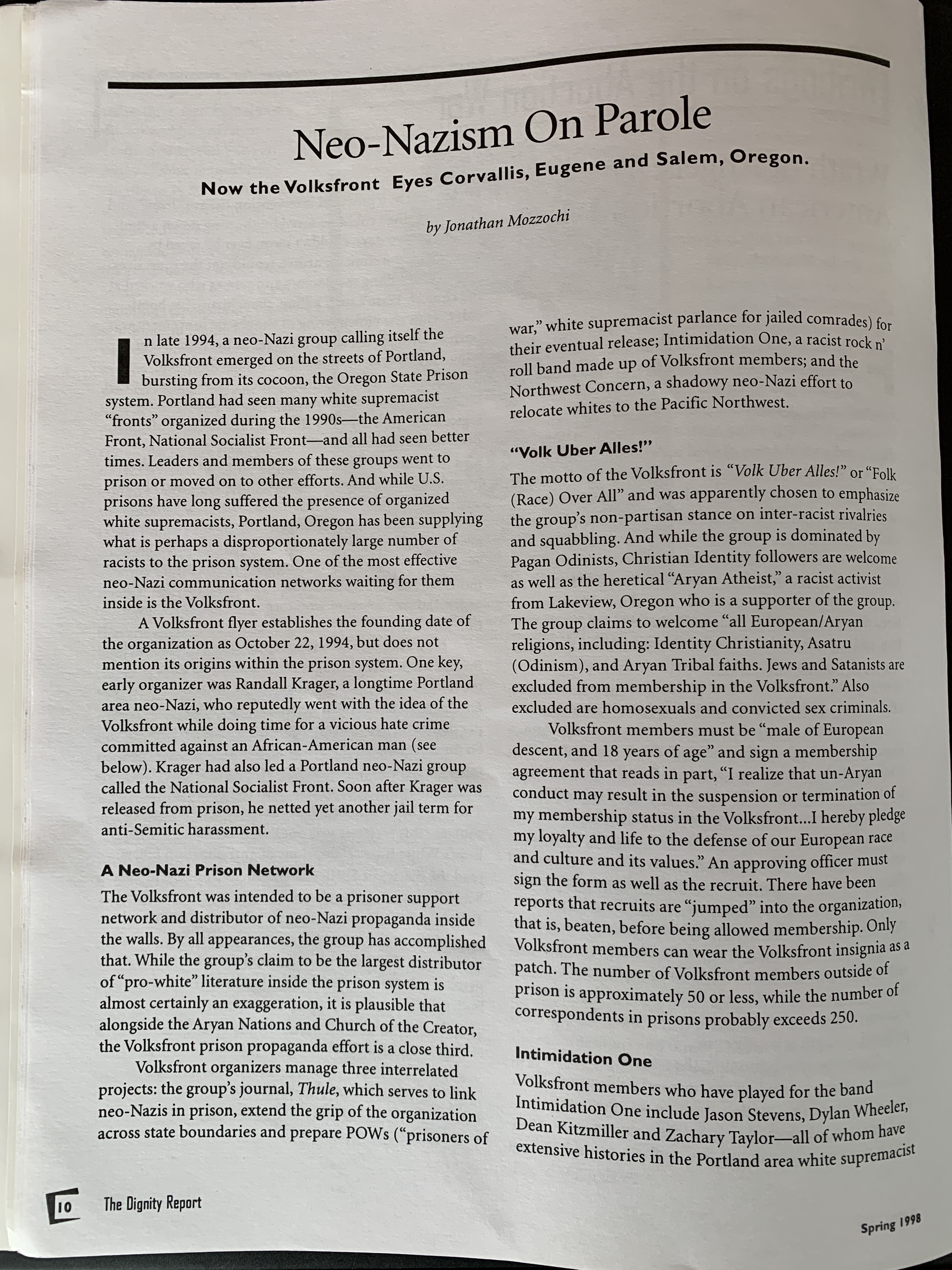
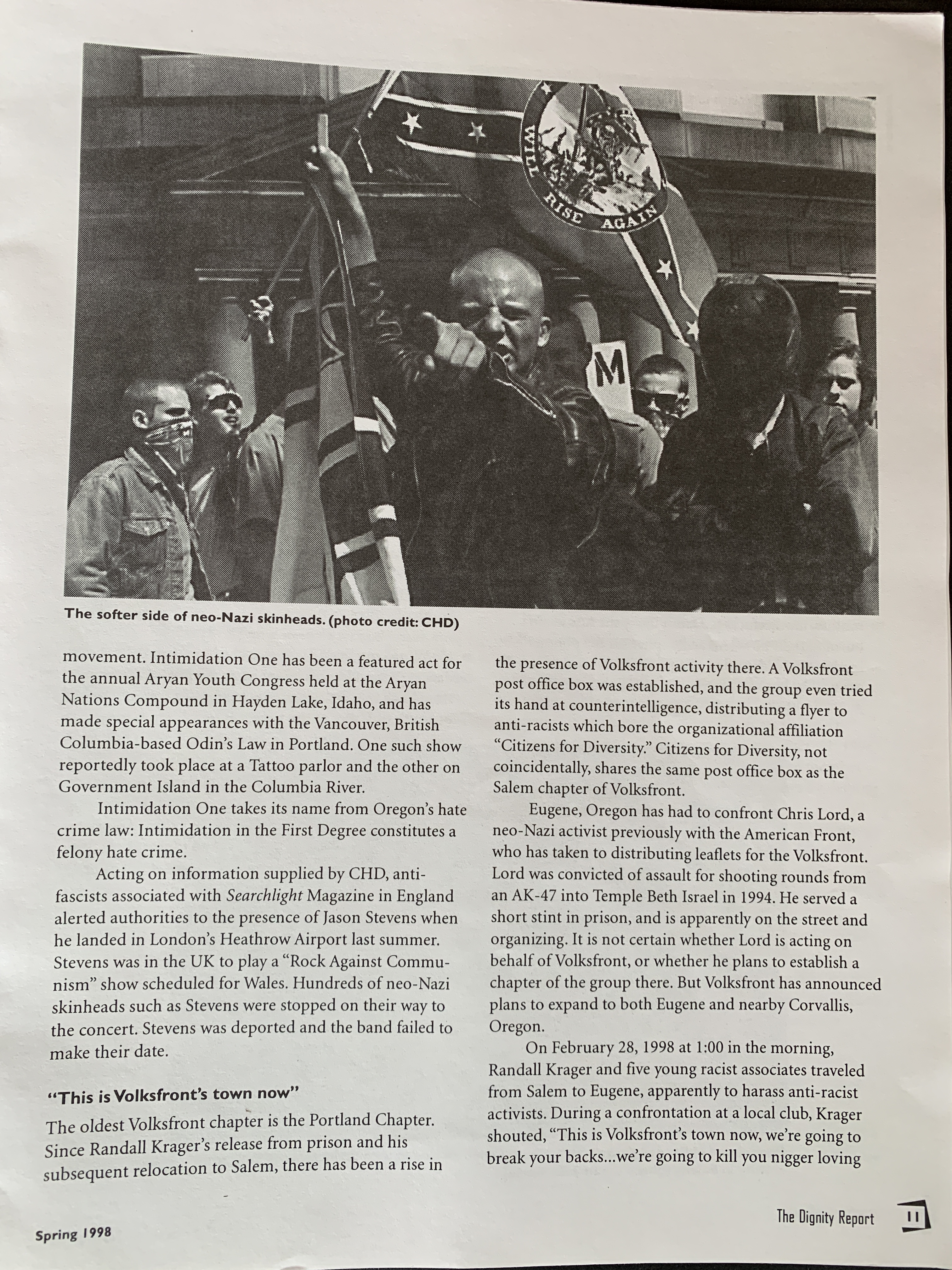
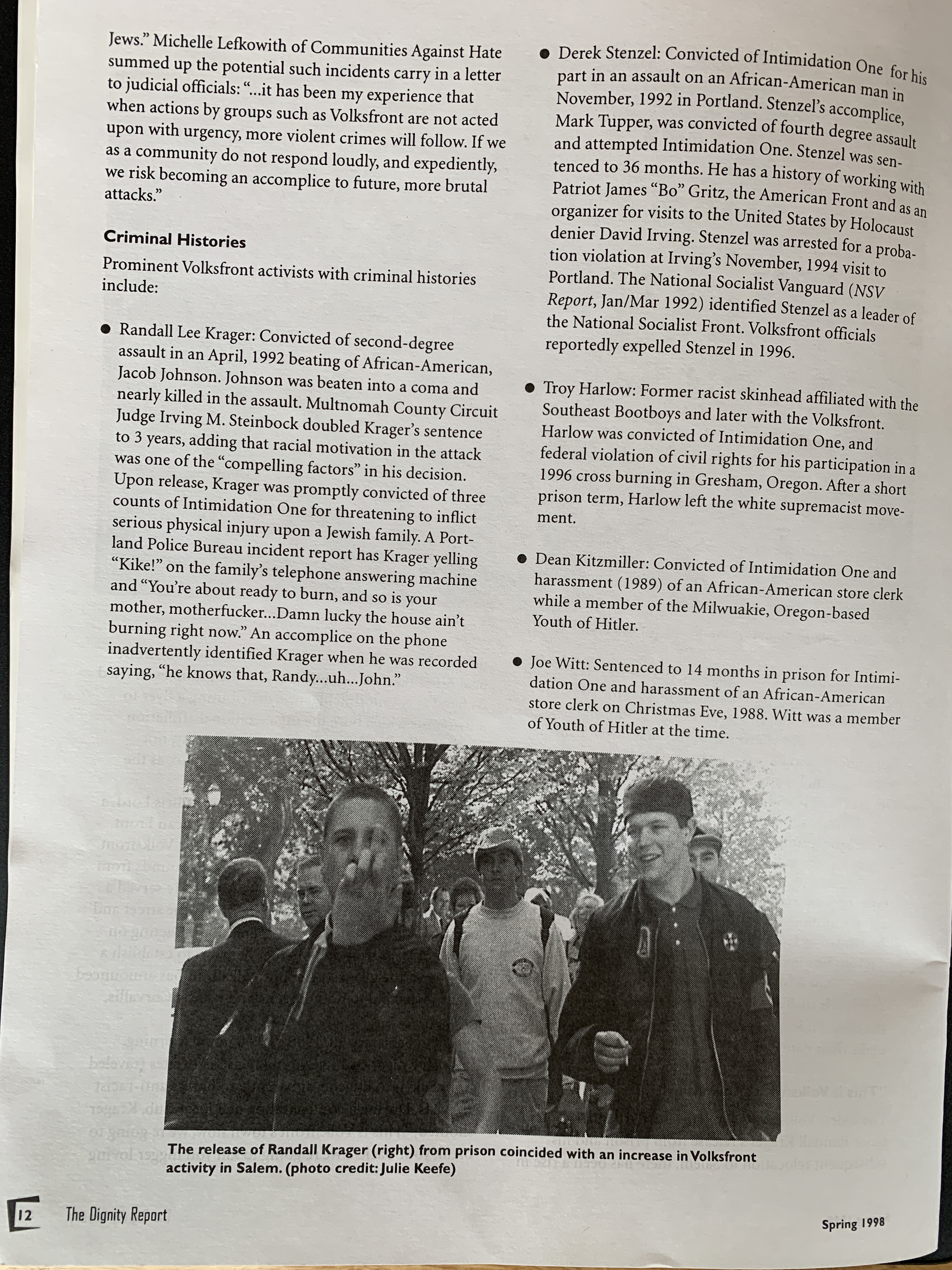
END
Tags
Anthropology, anti-fascism, coalition for human dignity, David Irving, Kennewick man, Michael t. Clinton, skinheads
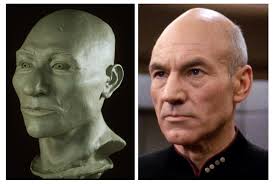
The “Caucasoid“ reconstruction made by Dr. Chatters and it’s obvious inspiration.
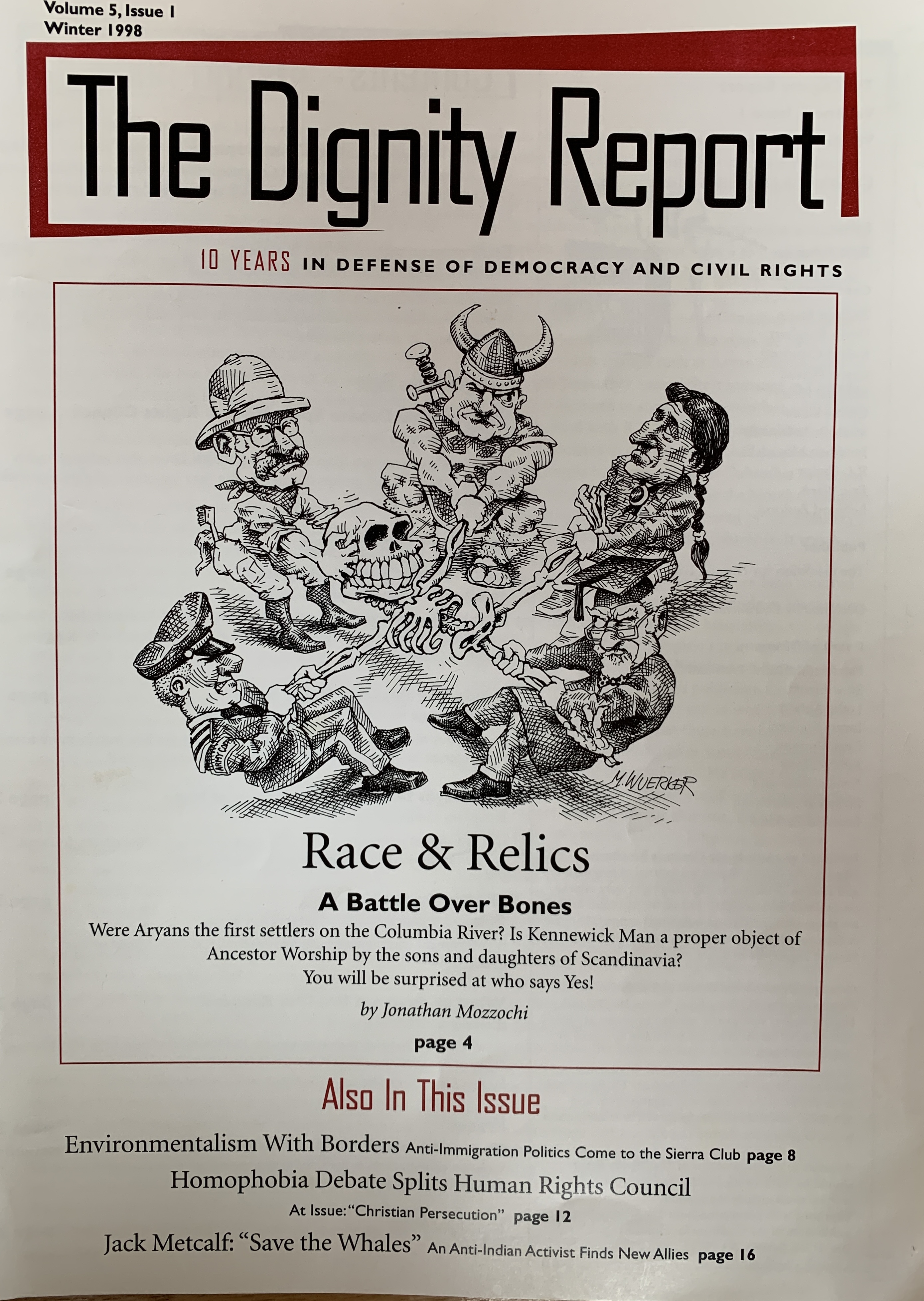
The “Dig Rep” 1998.
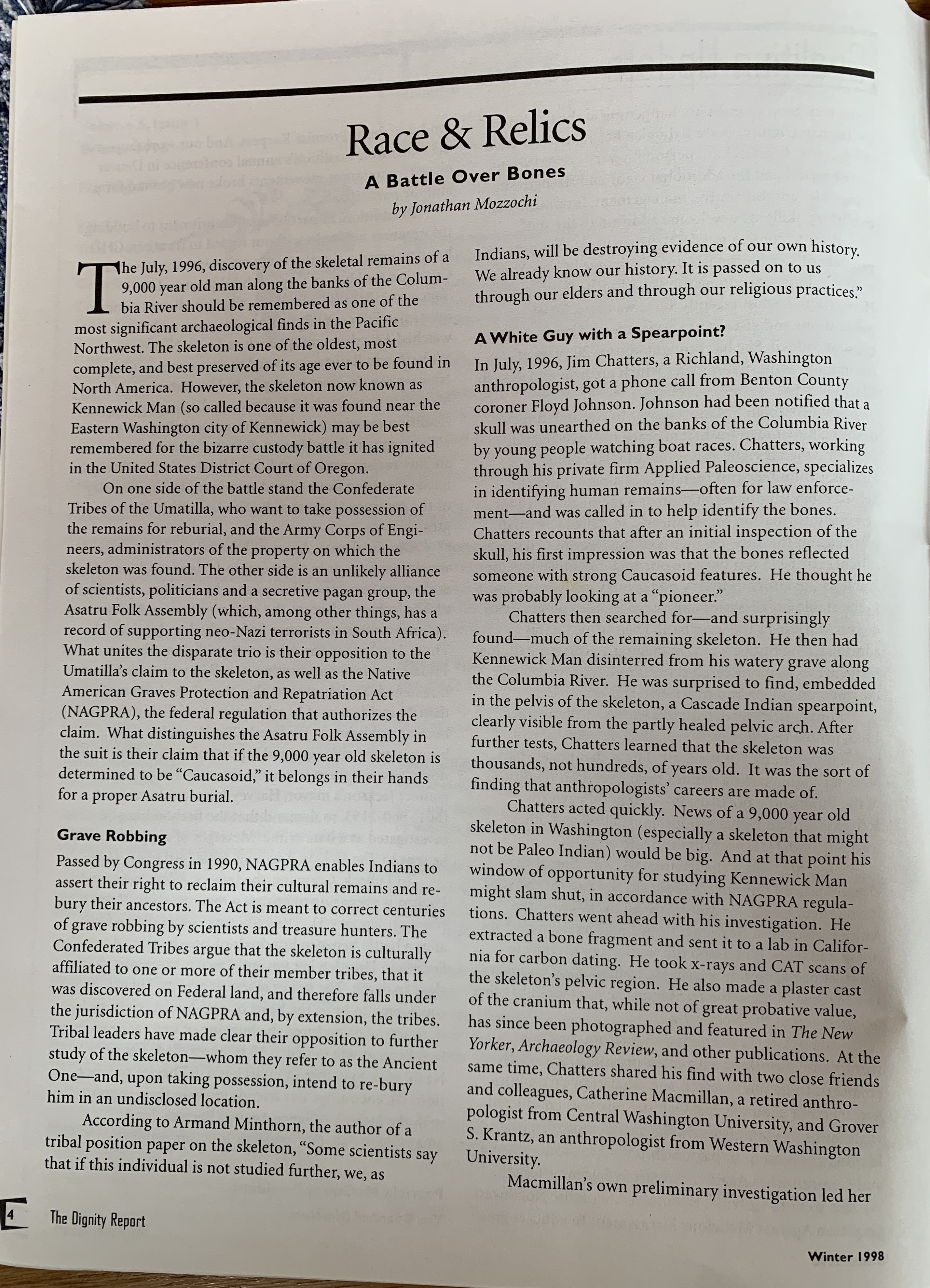
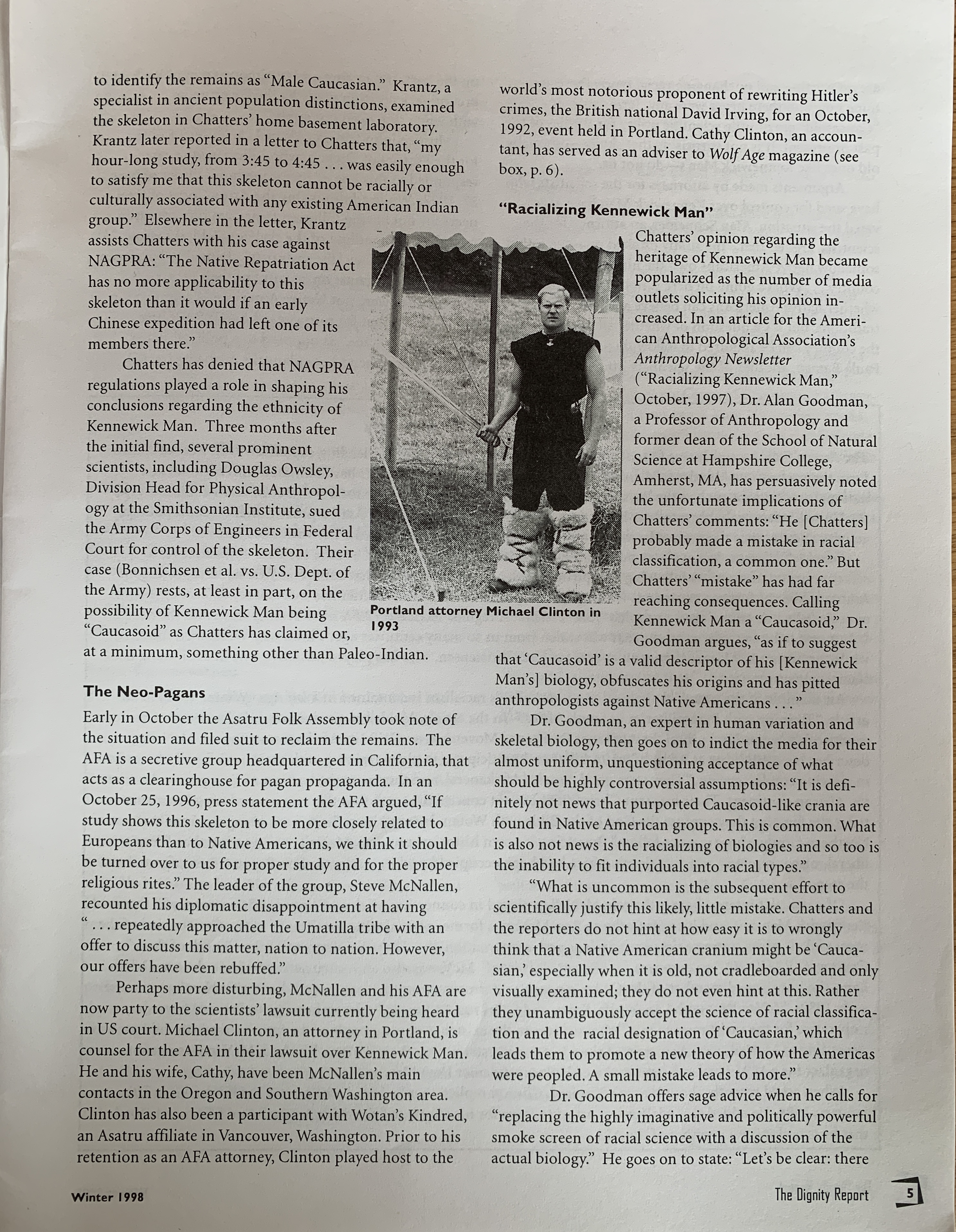
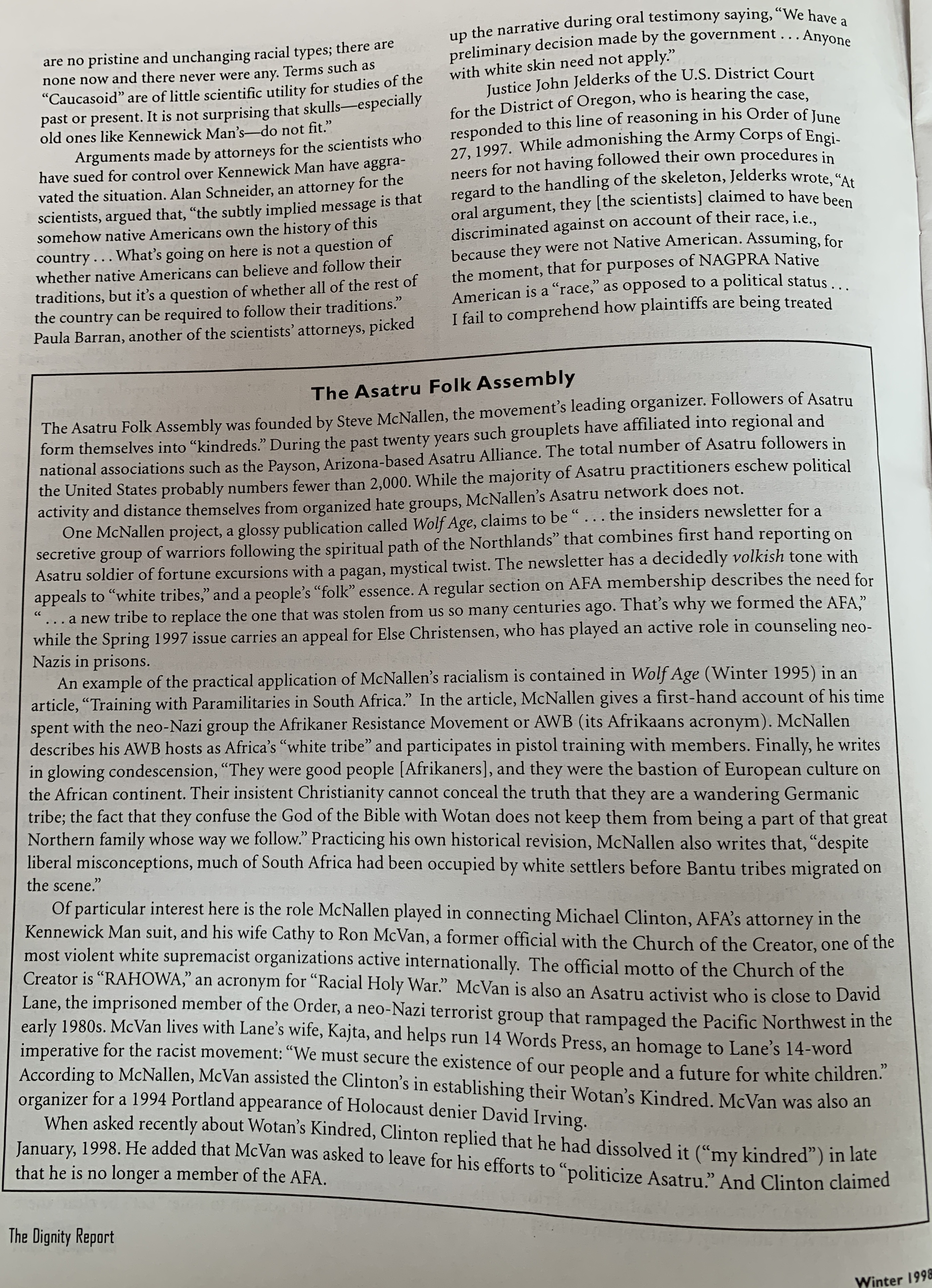
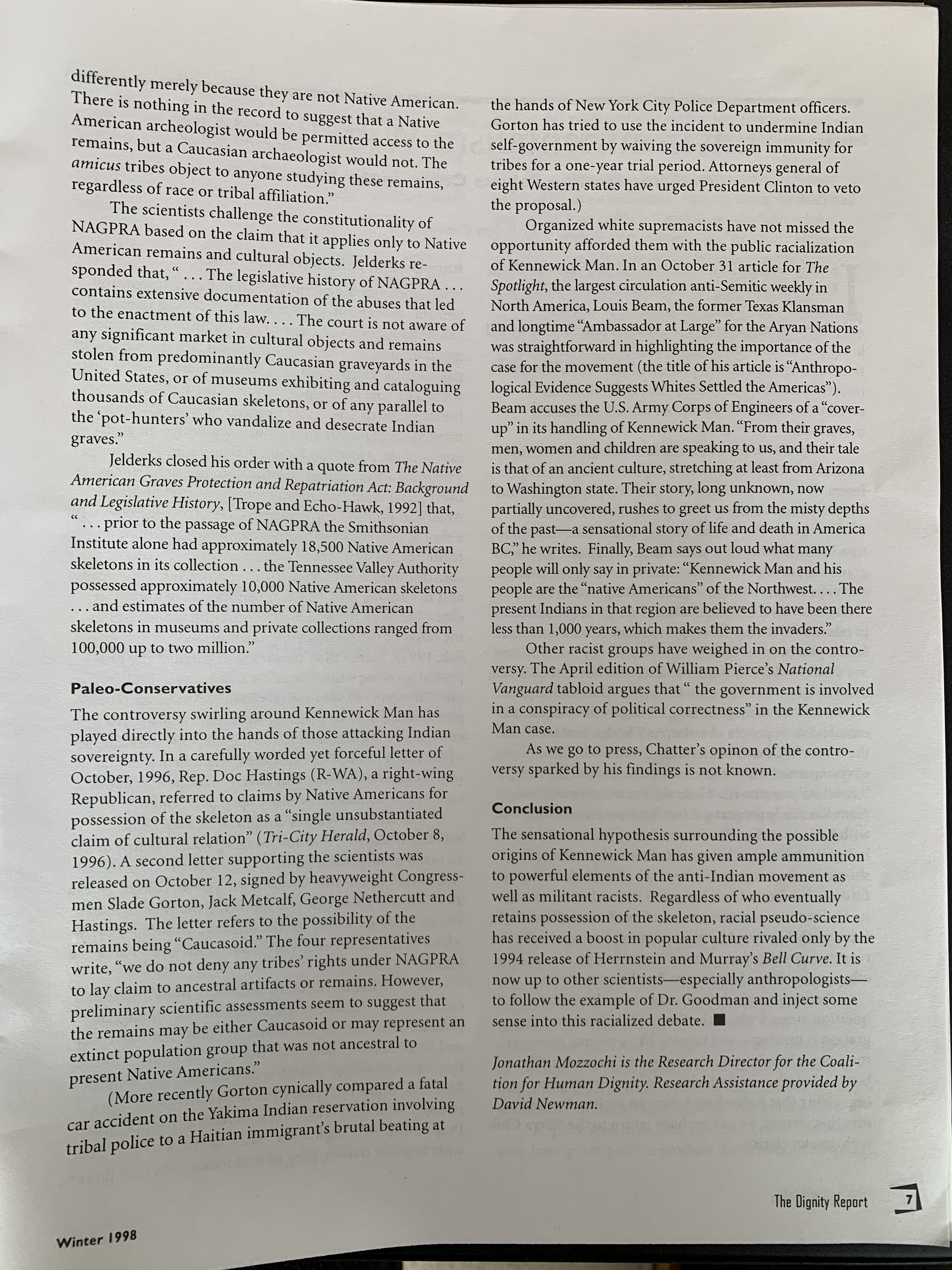
END
Posted in Essay, Portland Anti-Fascist Archives Project
More snippets from my personal archives.
January 1991–Anti-war mobilizing (Gulf War).
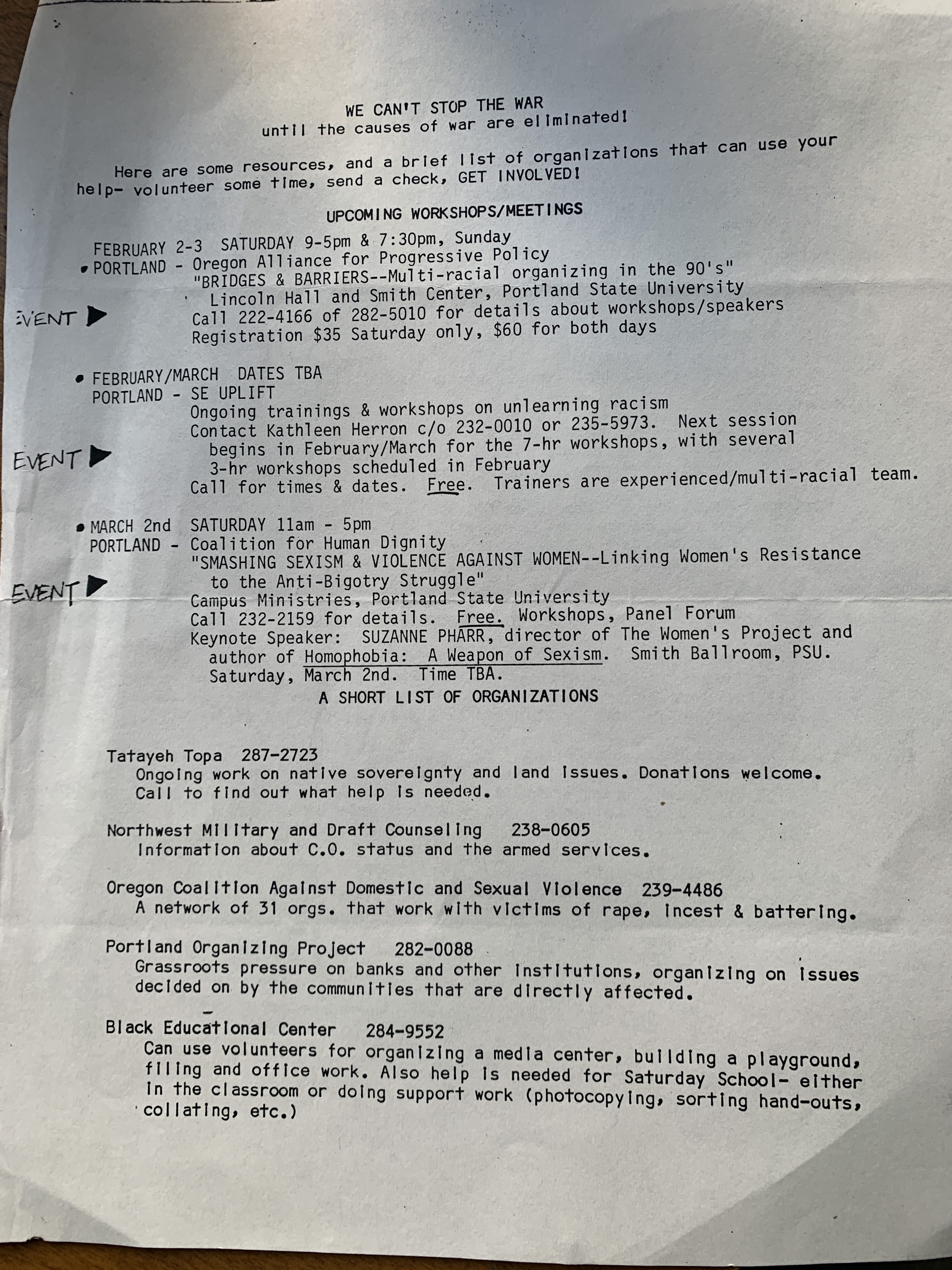
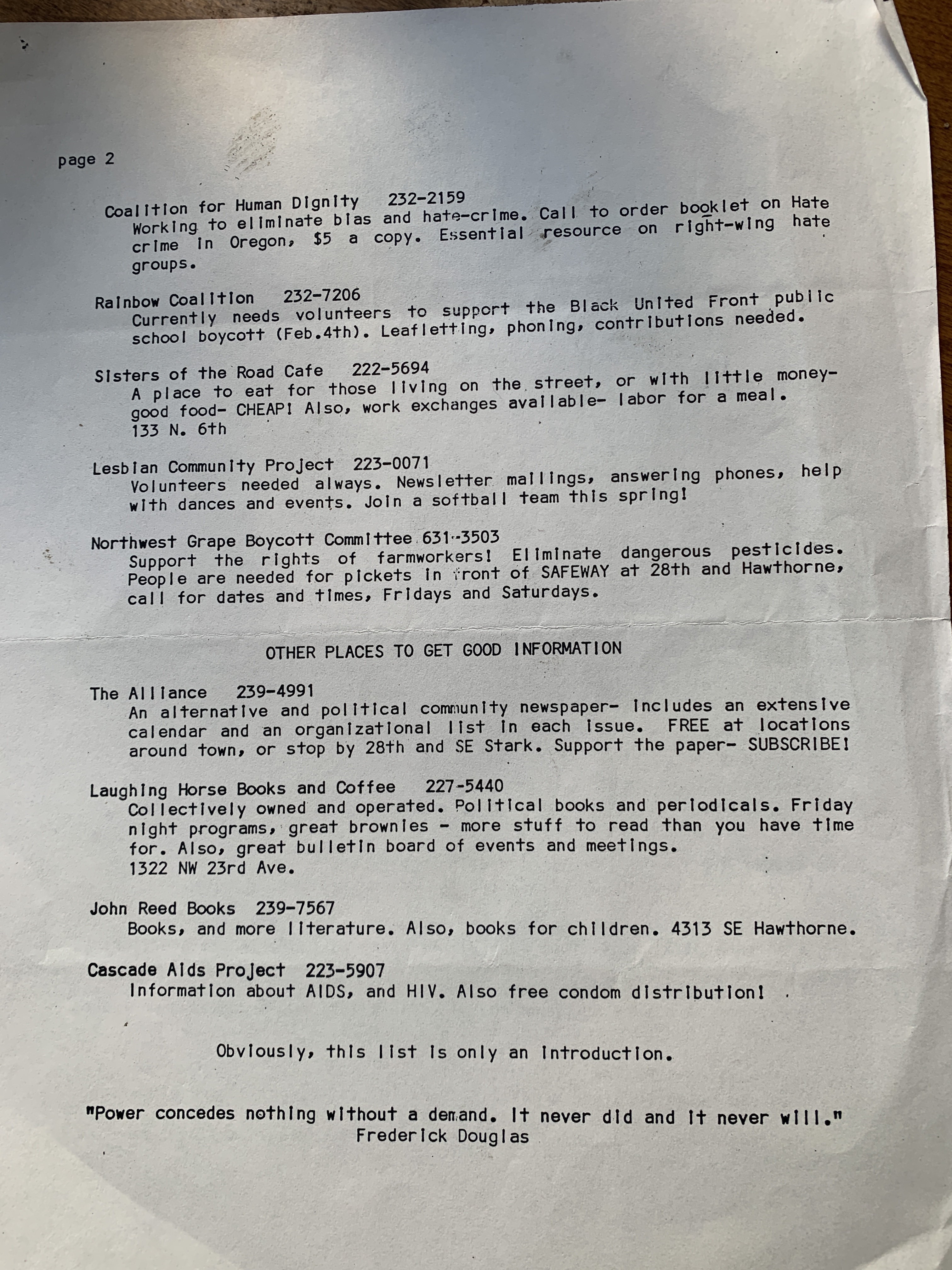
February, 1991–Coalition for Human Dignity produces first issue of The Oregon Witness, Vol. 1, Nos. 2 and 3. (Still looking for # 1+).
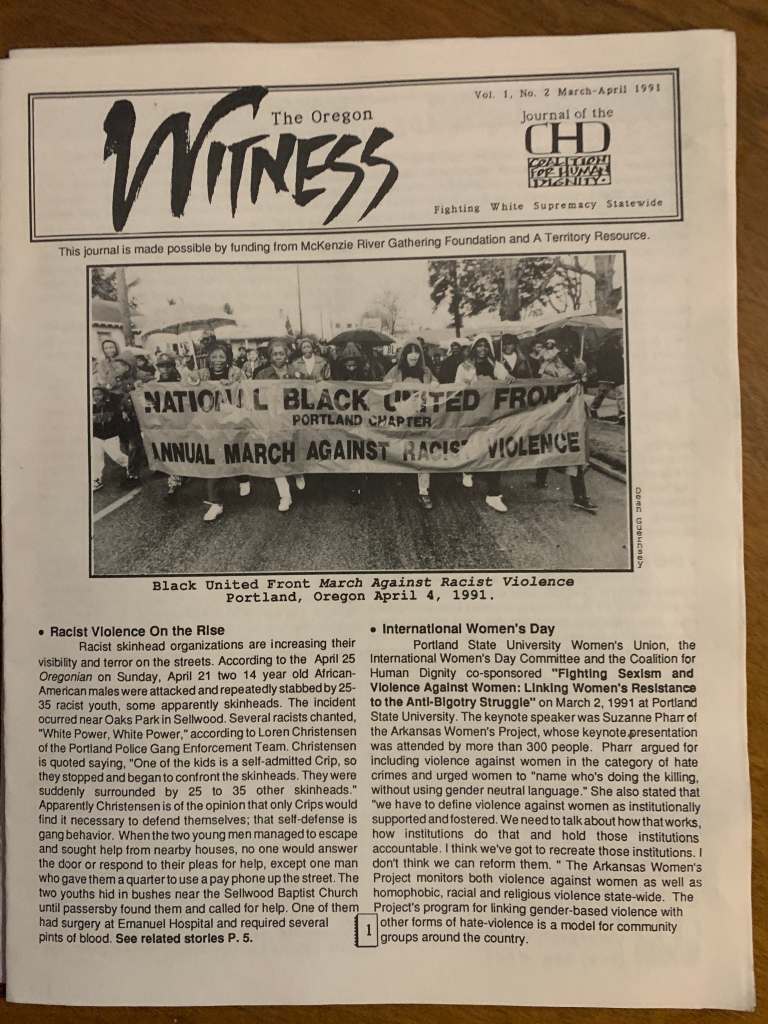
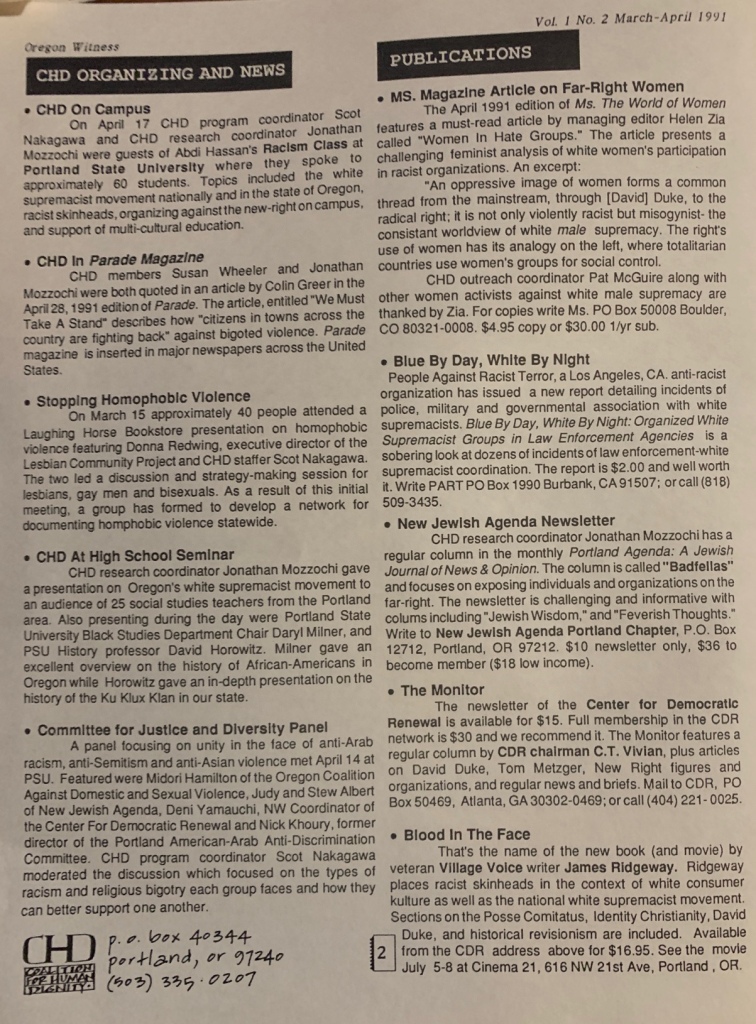


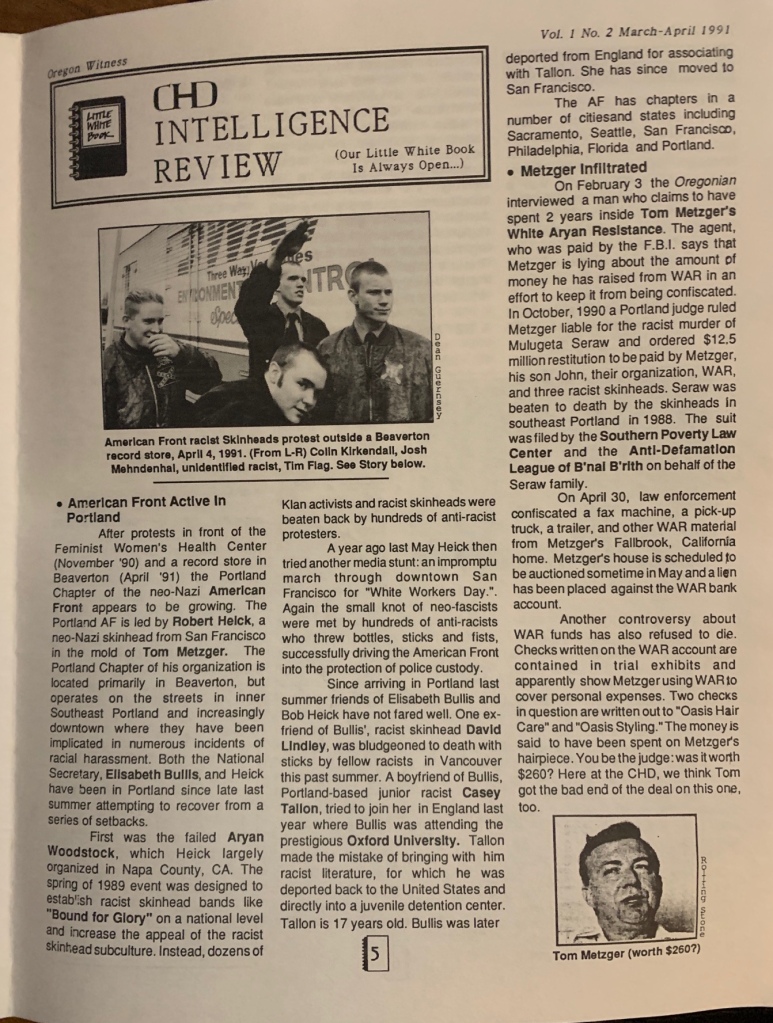
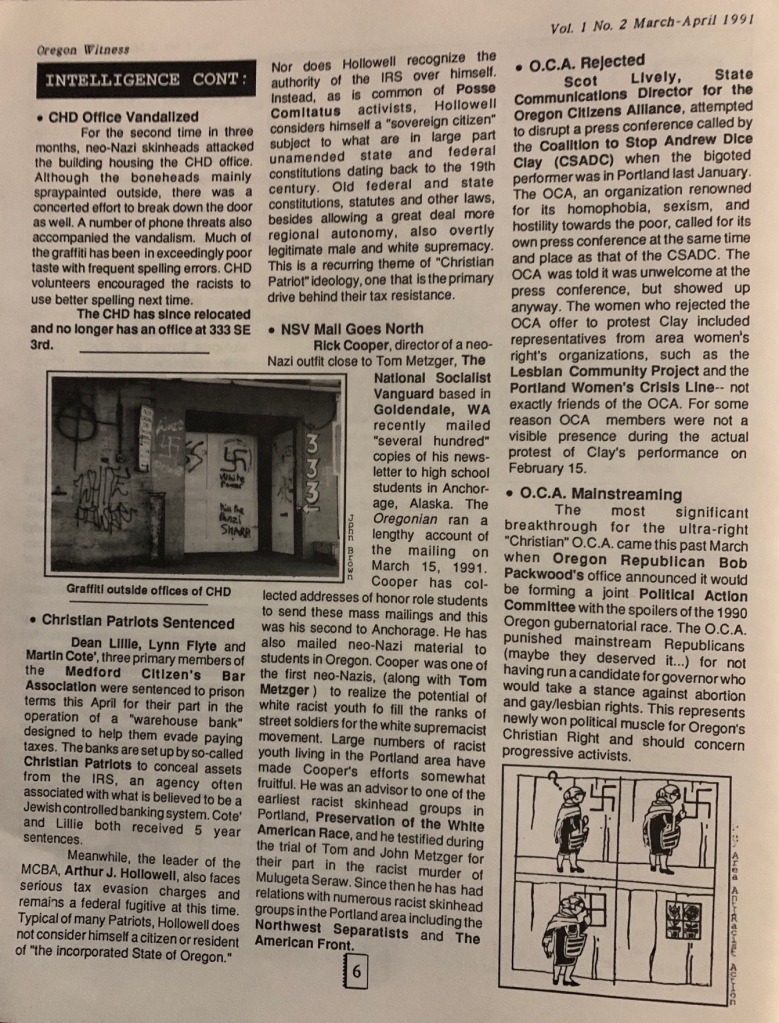


June 1991–Coalition for Human Dignity The Oregon Witness, Vol. 1, No. 3 May-June, 1991.
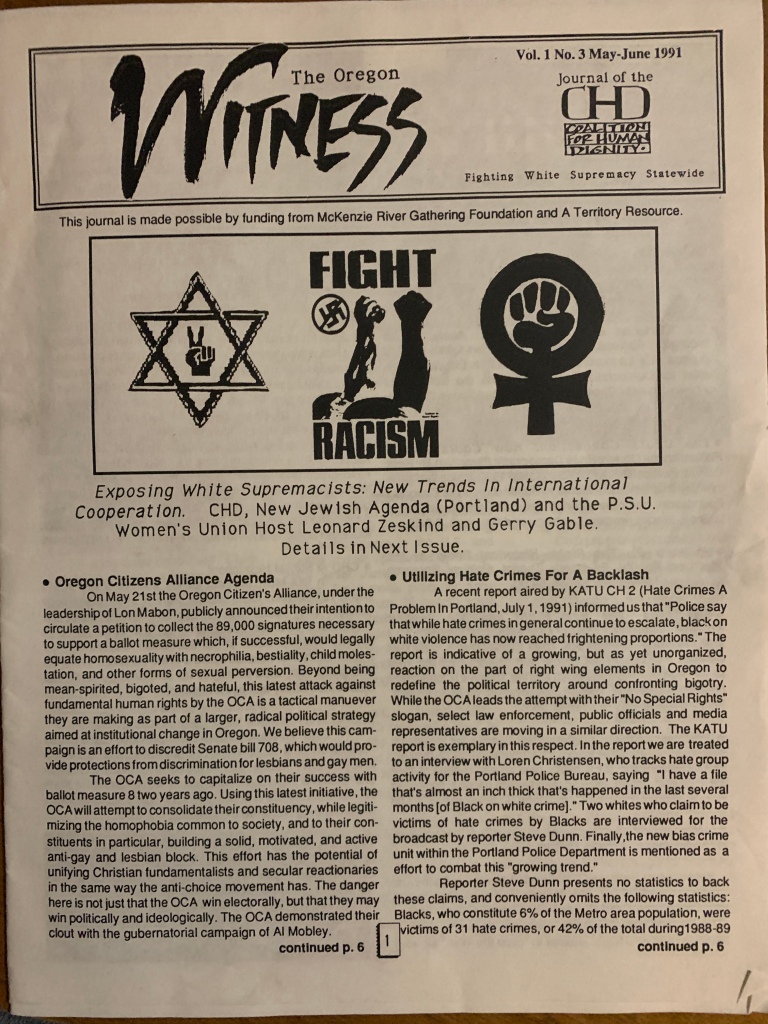
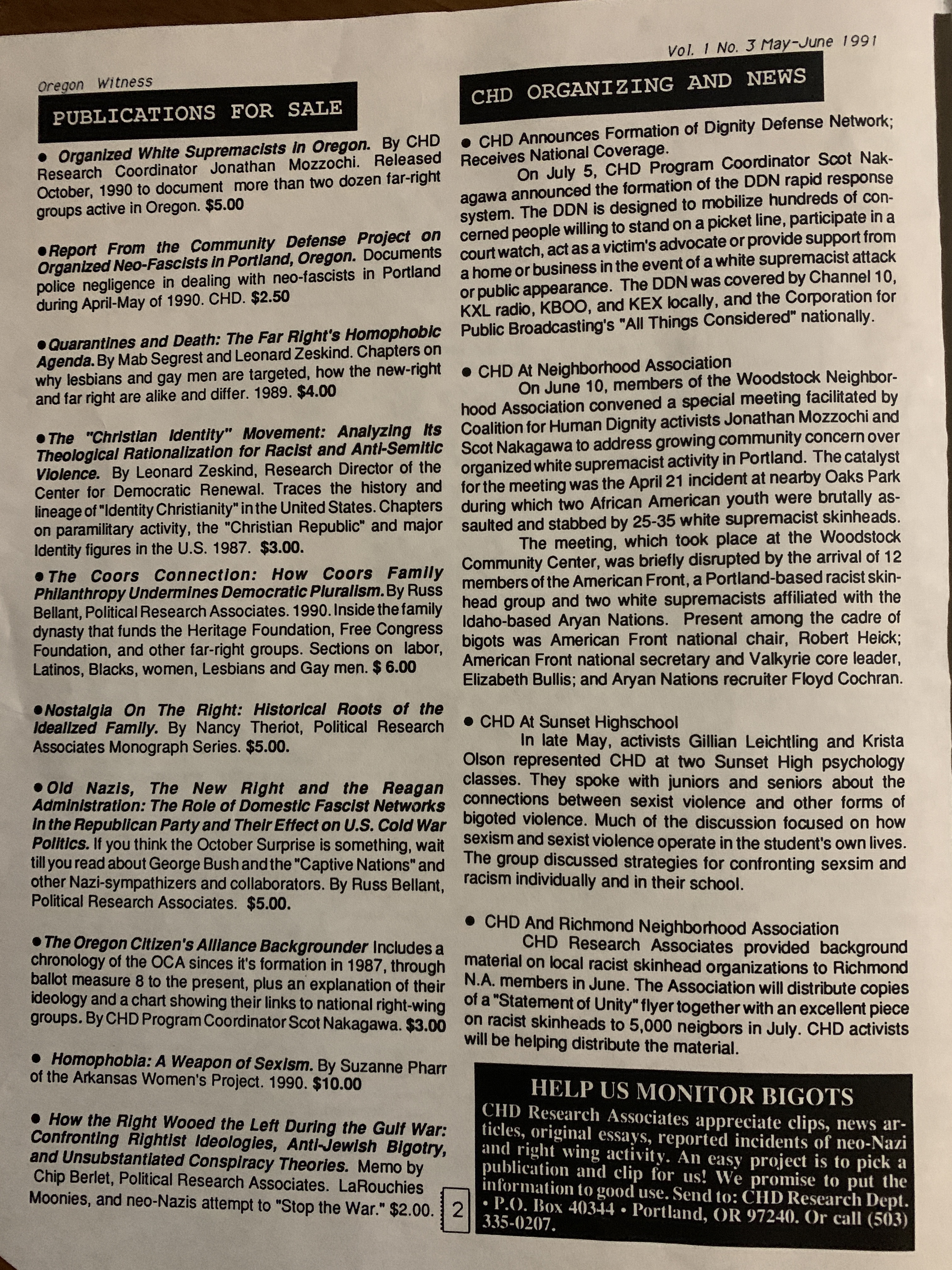
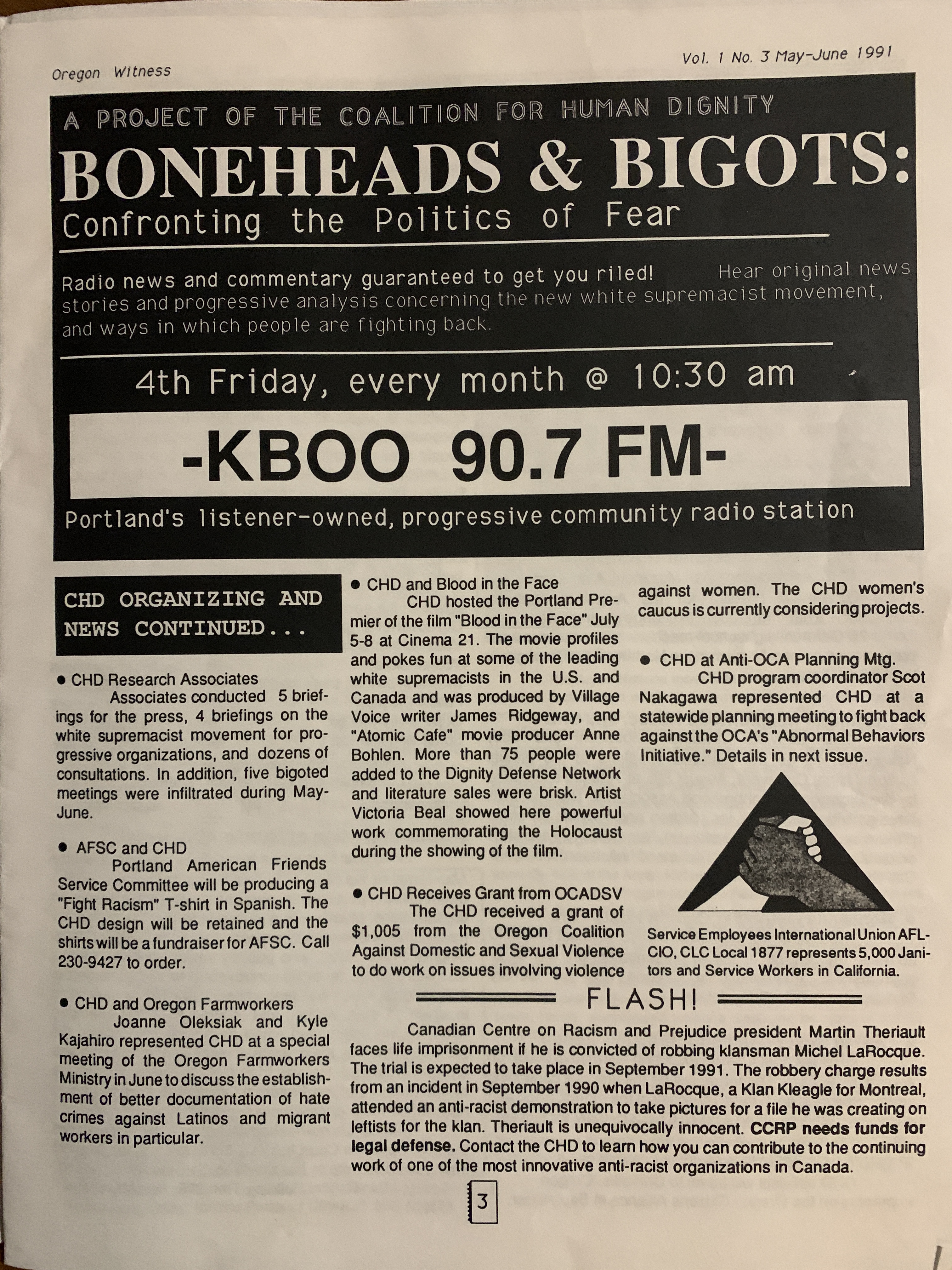

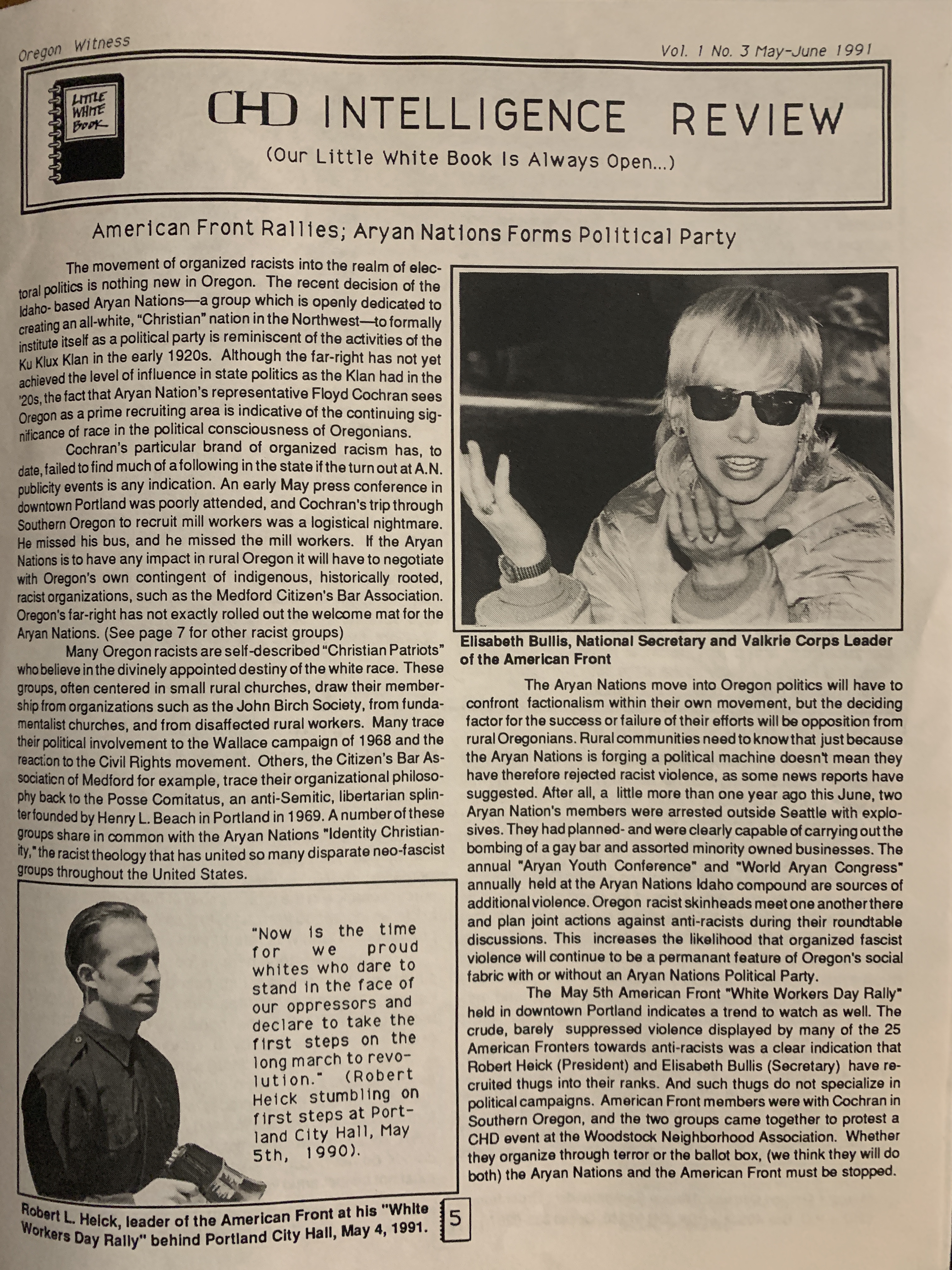
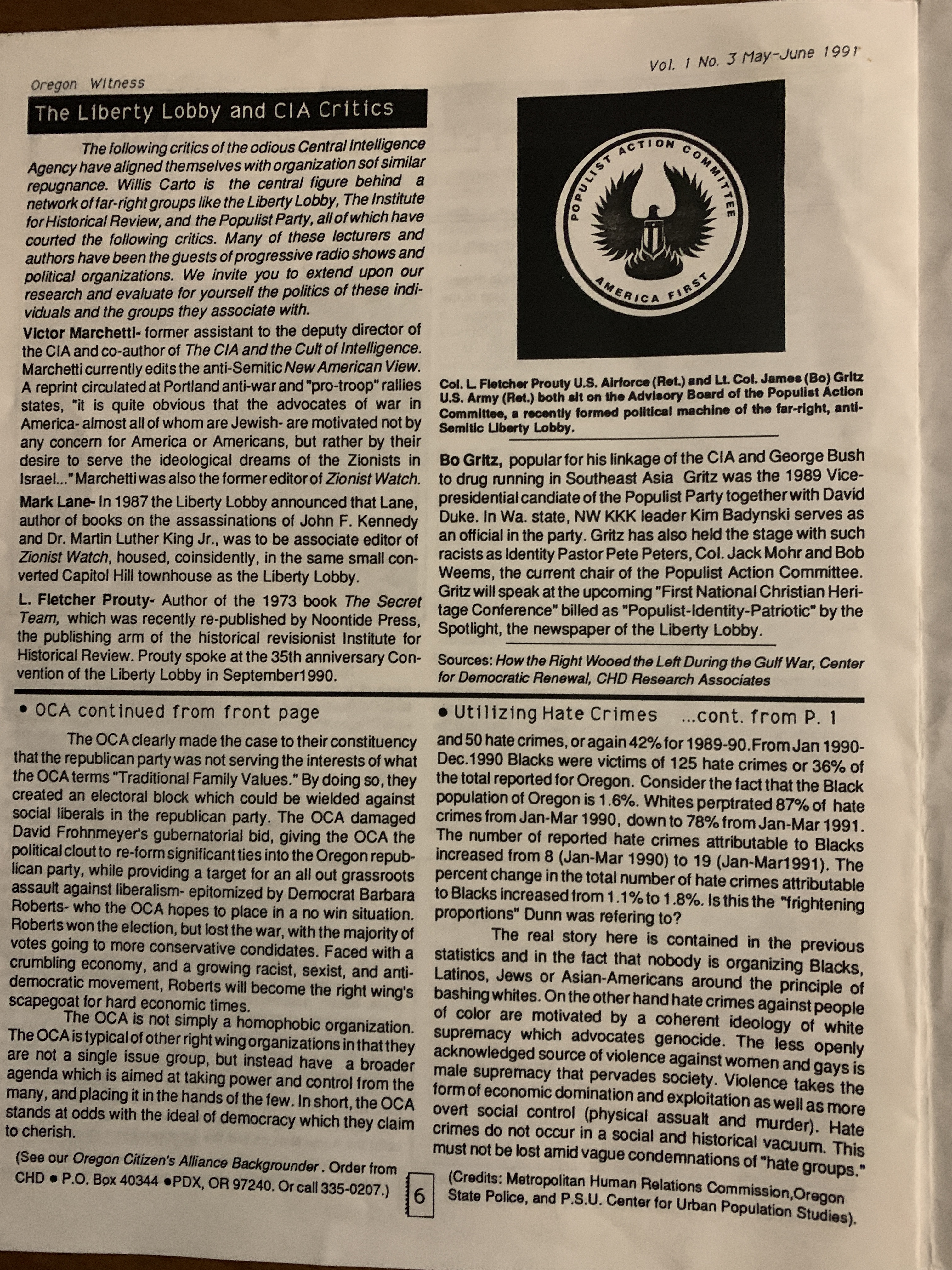
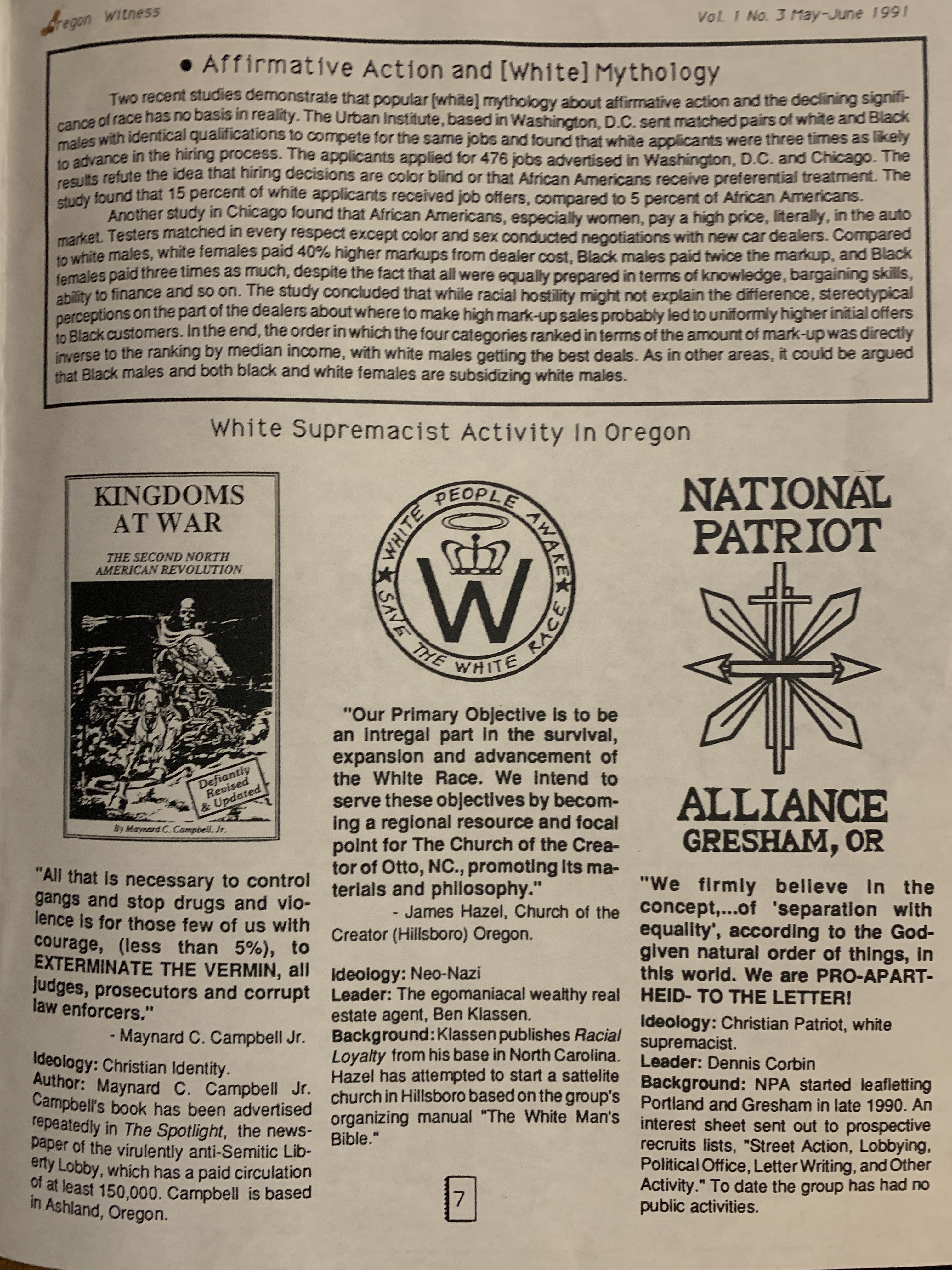
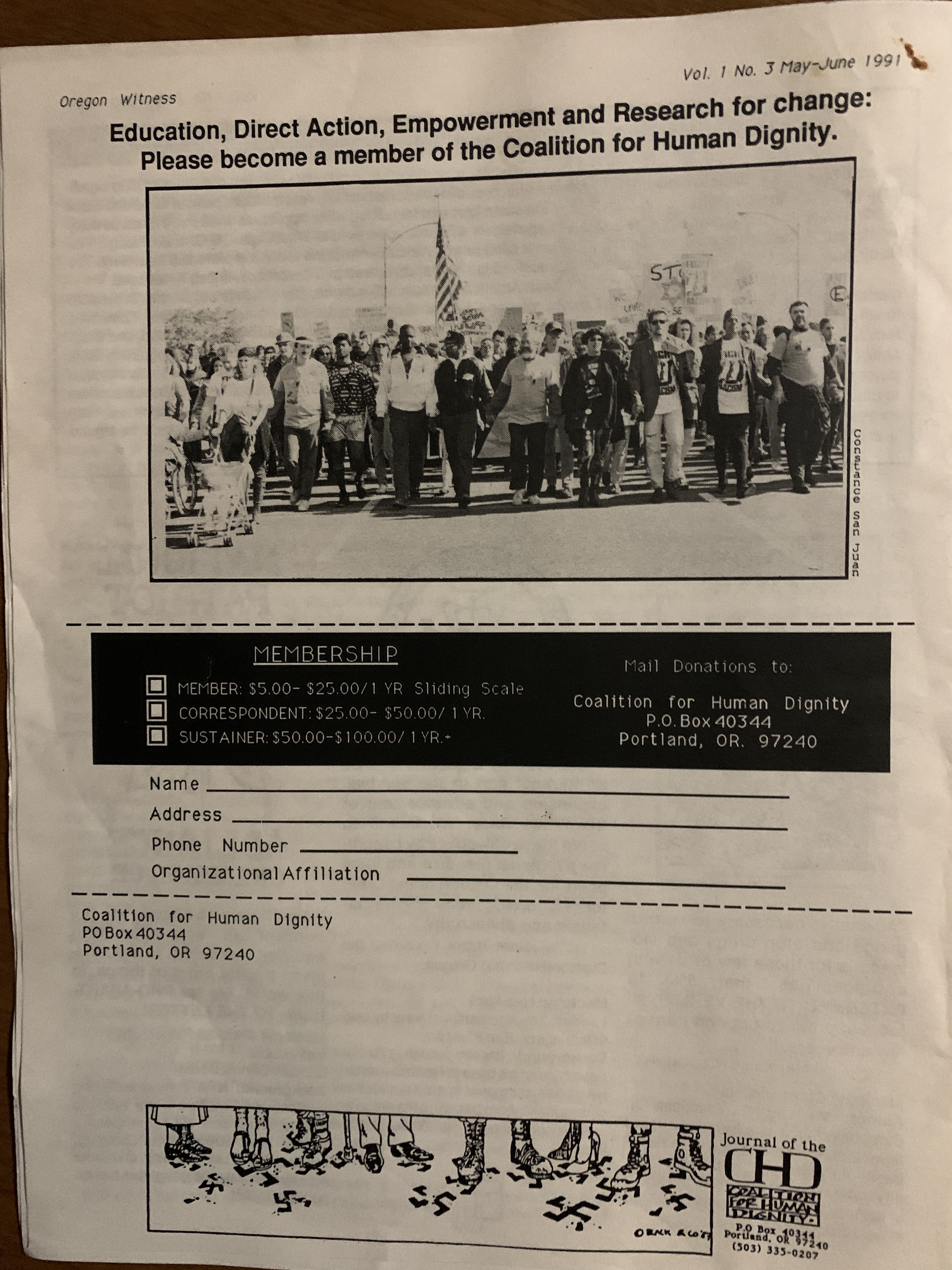
Posted in Essay, Memoir, Portland Anti-Fascist Archives Project
Tags
ACT-UP Portland, Center for Democratic Renewal, coalition for human dignity, Lesbian Community Project, Little Beirut, Portland Free Press, skinheads
5.11.21
June, 1989. “The New Skinhead Assault” by Christopher Phelps published in the Portland Alliance . See also his article in Against The Current, https://againstthecurrent.org/atc032/white-supremacy-on-trial/. Pretty good socialist analysis of the far-right.
July, 1989–I write “Fascist Skinheads: An Update and Analysis” for CHD. This was an early effort to get a handle on both the number of hate crimes and types of groups active in the Portland Metro area. Statistics on bias violence and intimidation were a hit-or-miss proposition; where there was even a law to collect such data there was insufficient awareness on the part of cops to collect it. As usual, community groups had to do it for ourselves. A similar project was carried out by the Lesbian Community Project, called the Homophobic Documentation Line, which took reports of homophobic violence from the community.
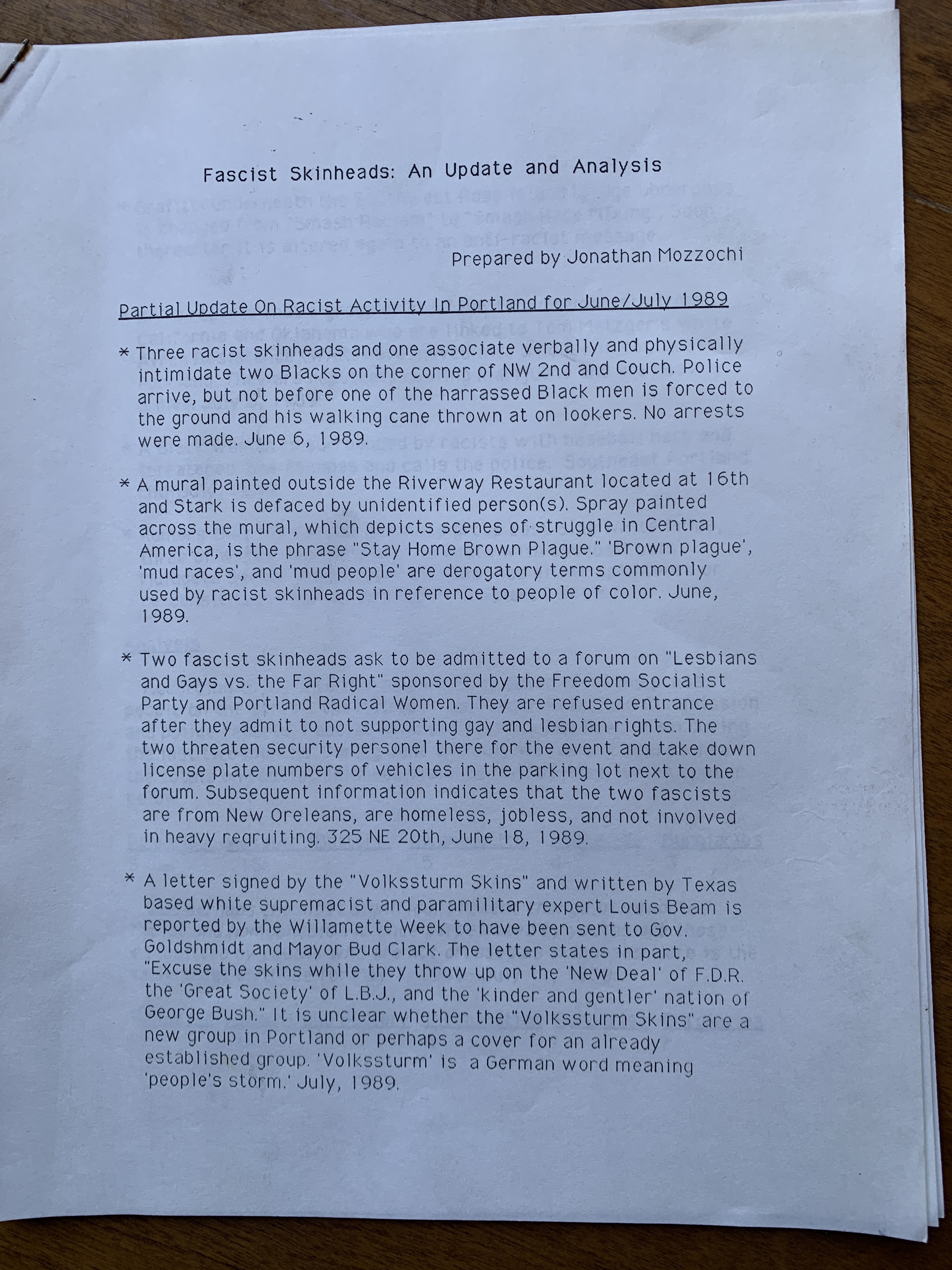
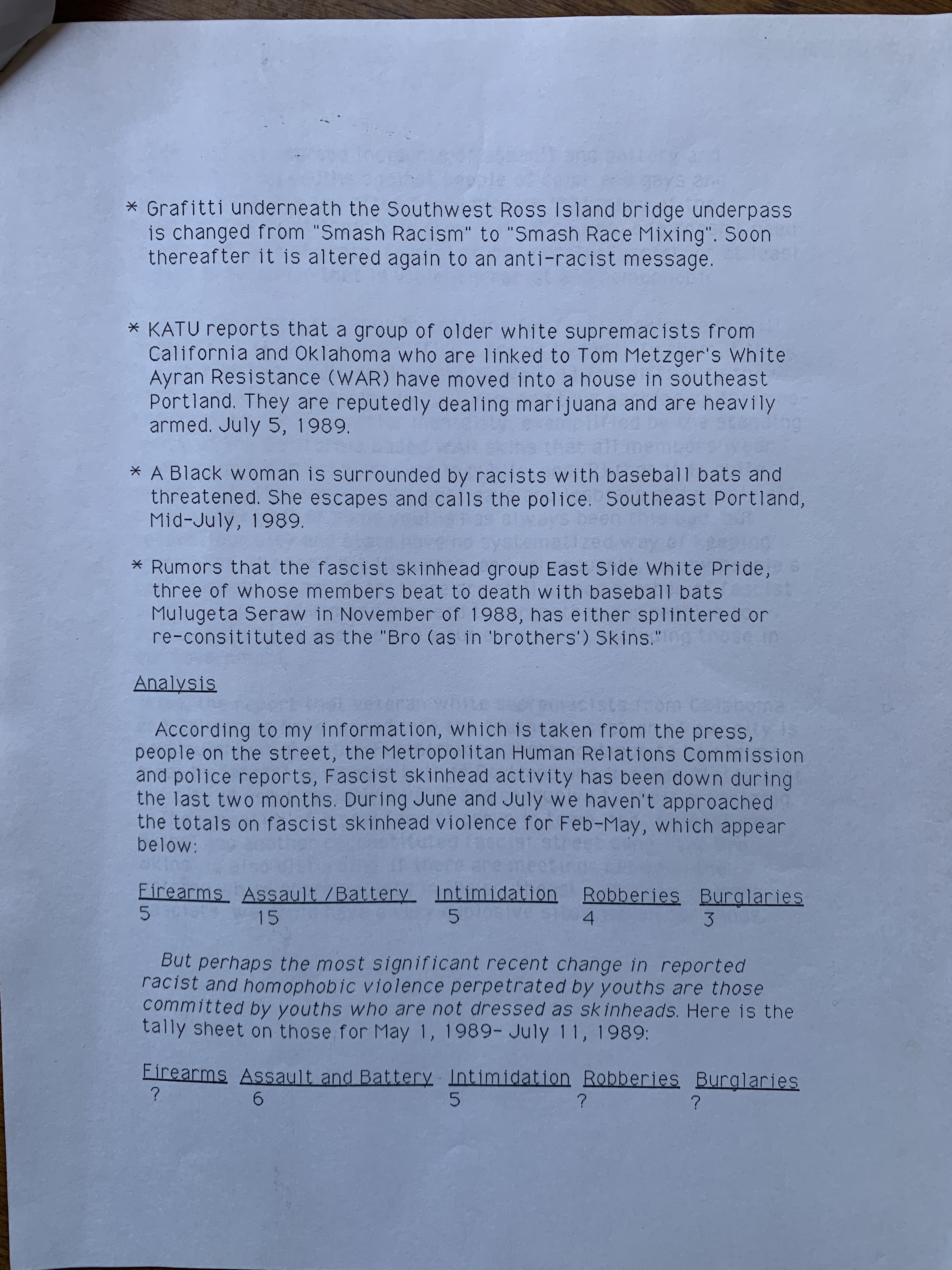
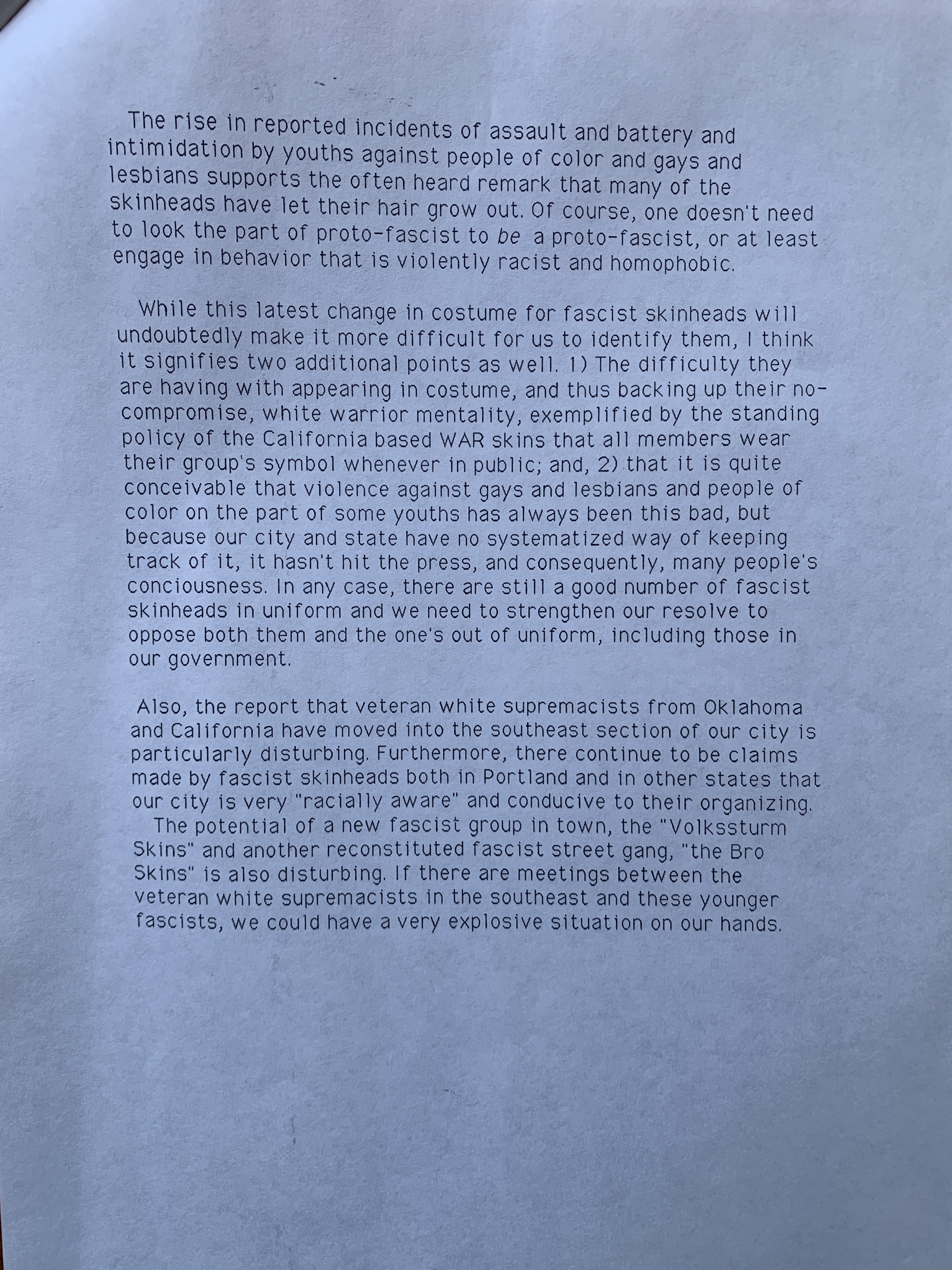
July 1989–the Matrix at 333 see 3rd Street becomes a base for anti-racists. The first Hon 8 x 1/2 by 14 filing cabinets are used to store info on racists and the repressive state apparatus.
August 1989–I write “Fascist Violence: Establishment Program and Response” for The Portland Free Press, a critique of weak efforts by authorities to understand, document and confront the far-right. Examples include no subpoena power for the Metropolitan Human Rights Commission and very limited funding.
August 24, 1989–Letter to my Mom after I drop out of college.
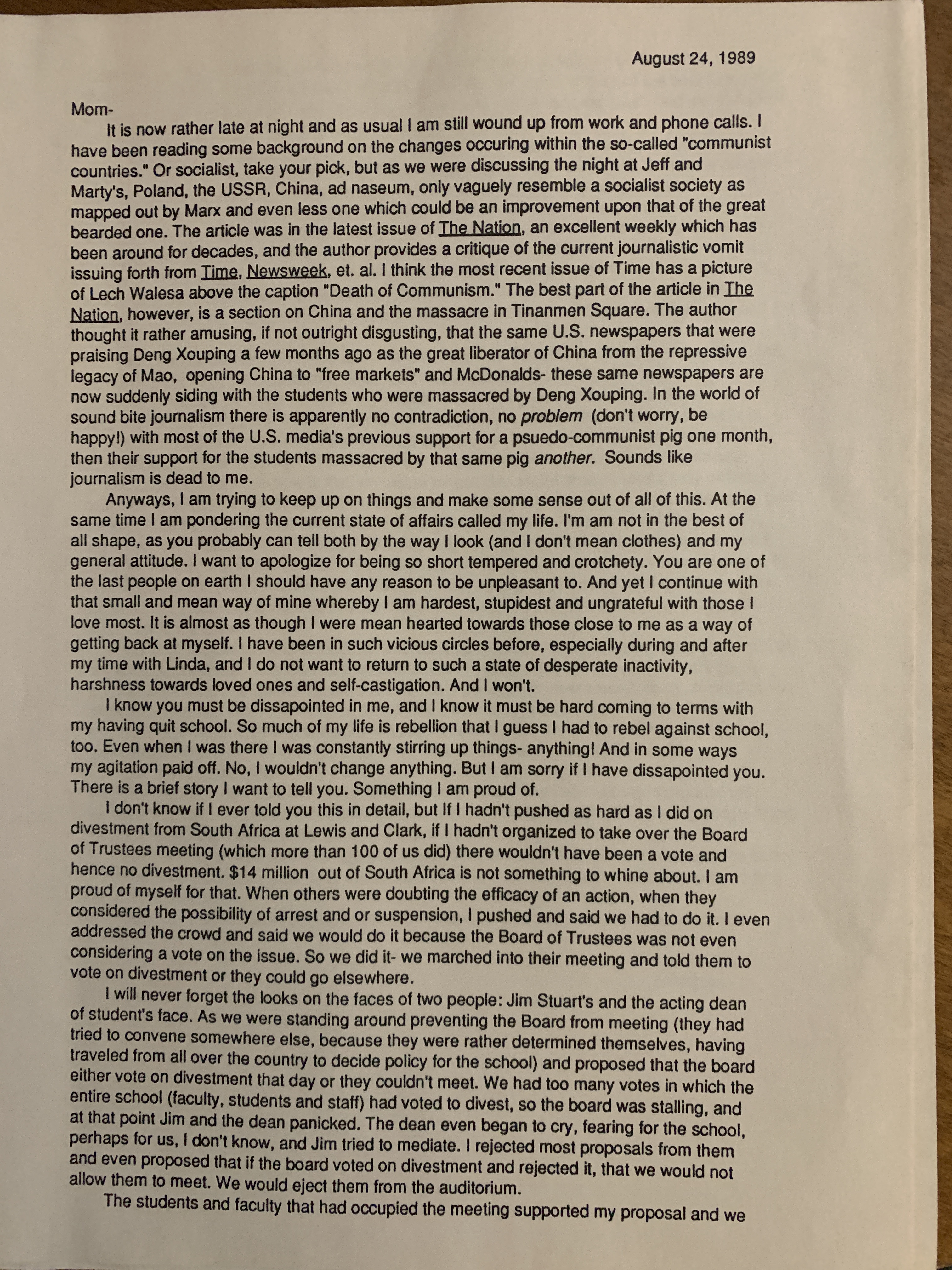
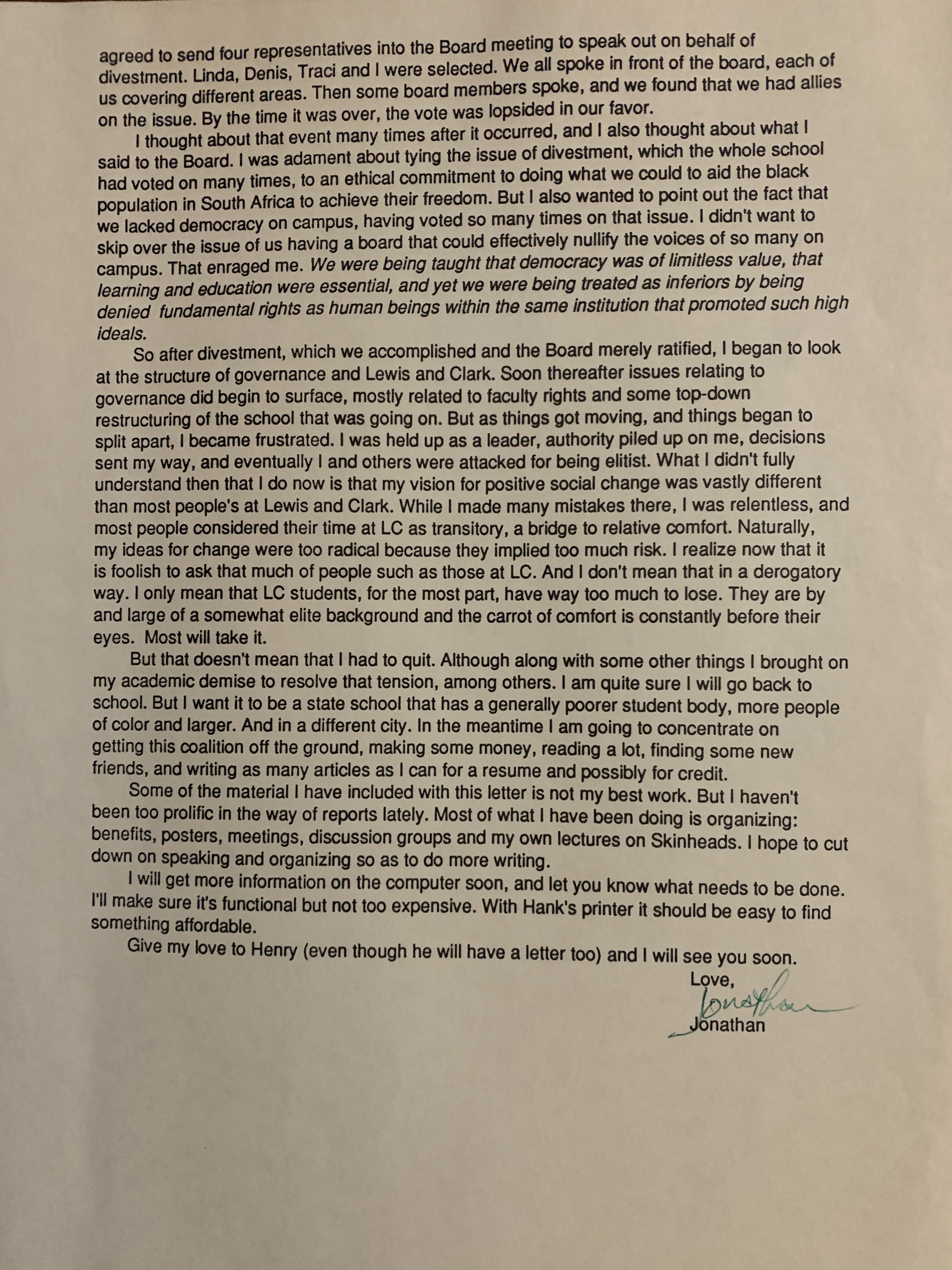
September 11, 1989–Tarso Ramos writes “Hate Crime in Portland” for the Reed College Quest wherein he manages to work in a reference to the Dukes of Hazard in an anti-racist manner. Quite the peculiar feat!
September 22-23, 1989. CHD organizes a Rock Against Racism benefit held at Pine Street Theater. “Fight Racism” posters are going up in neighborhoods. We cribbed from the great anti-fascist artist John Heartfield — Excavating the past so as to reveal the future.
This poster and t-shirt created by comrades in the Coalition for Human Dignity in Summer 1989 in Portland, Oregon is being produced and distributed there again, for obvious reasons. The original design was cribbed from the great anti-fascist artist John Heartfield. The translation from German: “Whether black or white – united in battle. We only know one race. We all know only one enemy – the exploiting class.” Please forgive us for compressing those outstretched arms and fists! All solidarity to comrades in Little Beirut!

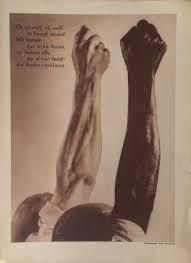
October 2, 1989–Black student Robbie Robinson becomes first in the nation victim of a school board injunction against his enrollment at Eugene High School for gang affiliations in Portland. …
Principal Don Jackson suspended Robinson. A week later, in the first such action in the nation, the school board sought an injunction in Lane County Circuit Court to bar the student permanently from the city’s schools, not on the basis of any specific actions, but because “his mere presence at the school in clothing associated with gang membership constitutes a danger to the health and safety of students” (Jeff Wright 1989). On November 8, the injunction was granted.
Some citizens expressed concern about the constitutionality of the ruling, but members of the local chapter of the NAACP and of the Community Coalition for the Prevention of Gangs applauded the action.
All this while racist skinhead groups are flourishing.
CHD Flyer, “Past and Current Activities”
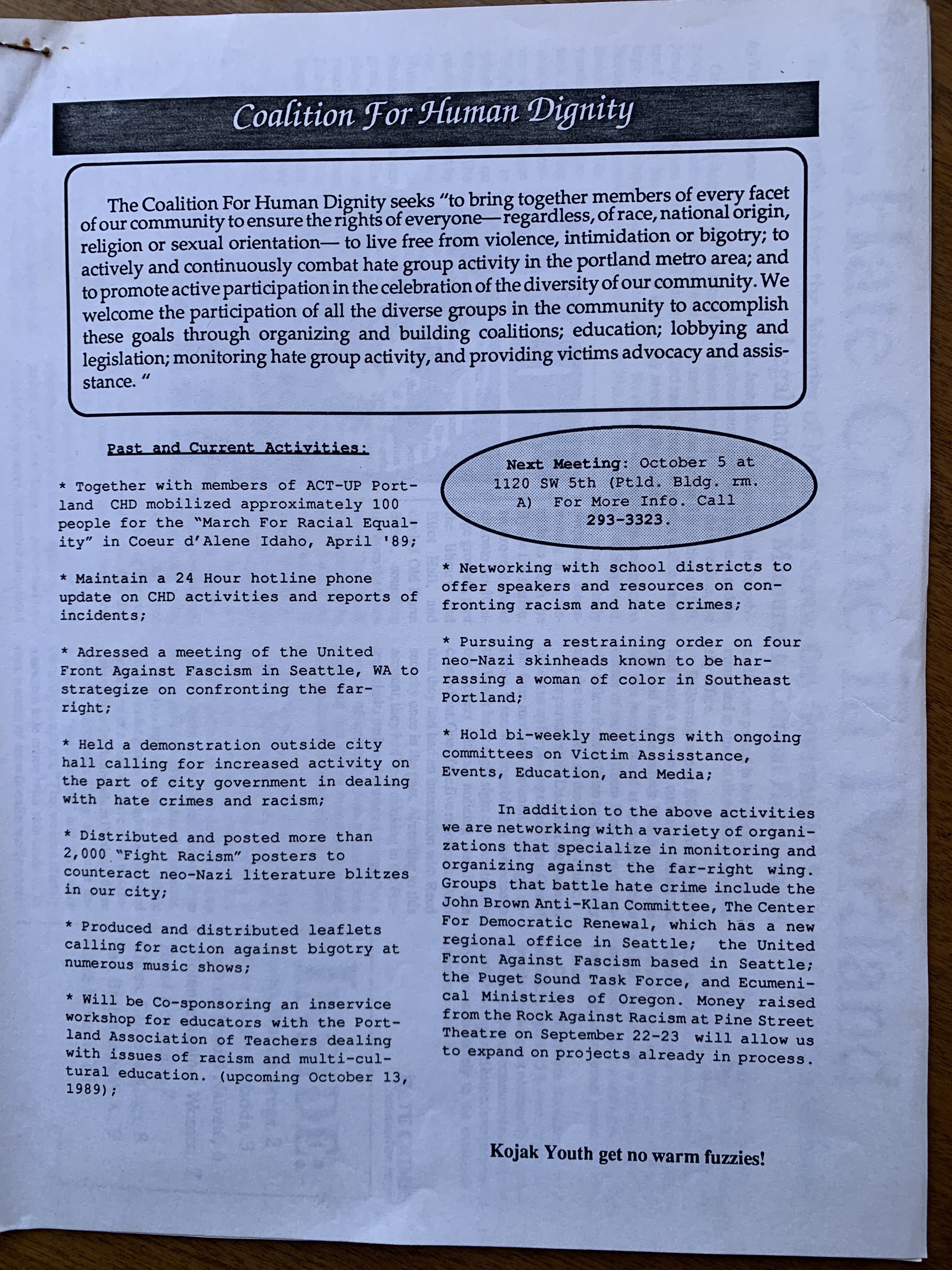
October 16, 1989–Little Beirut I
“The first Little Beirut protest took place when Vice President Quayle came to Portland to defend the Bush administration’s inaction during a failed Panamanian coup and to make it harder for victims of statutory rape to access federal funding for rape victims. Unsurprisingly, he was greeted by 150 protesters.
“Out of respect for the office of vice president, there should have been at least 500,” Quayle reportedly joked.
Where other protests had a singular goal, these protests were over a grab bag of issues ranging from the U.S. government’s despicable policy in Latin America to abortion to the government’s despicable handling of the AIDS crisis. The crowds were a healthy mix of political protesters and good, old-fashioned anarchists.
It was the largest protest Quayle had encountered during his first nine months in office, and the only one to disrupt his schedule as protesters blocked his way to the Hilton downtown. Over 20 protesters were arrested and a police van transporting several protesters crashed into a pickup truck on its way to the precinct—this appears to have been an honest error and not a rough ride.” —Willamette Week “Big Trouble in Little Beirut” May 4, 2016.
October 1989–PFP publishes “Behind the Scenes”. I interview the Portland FBI SAC, Danny Coulson. I focus on FBI surveillance and disruption of solidarity movements. I can’t write for shit. I won’t even include the article here.
CHD address is 333 SE 3rd, “The Matrix.”
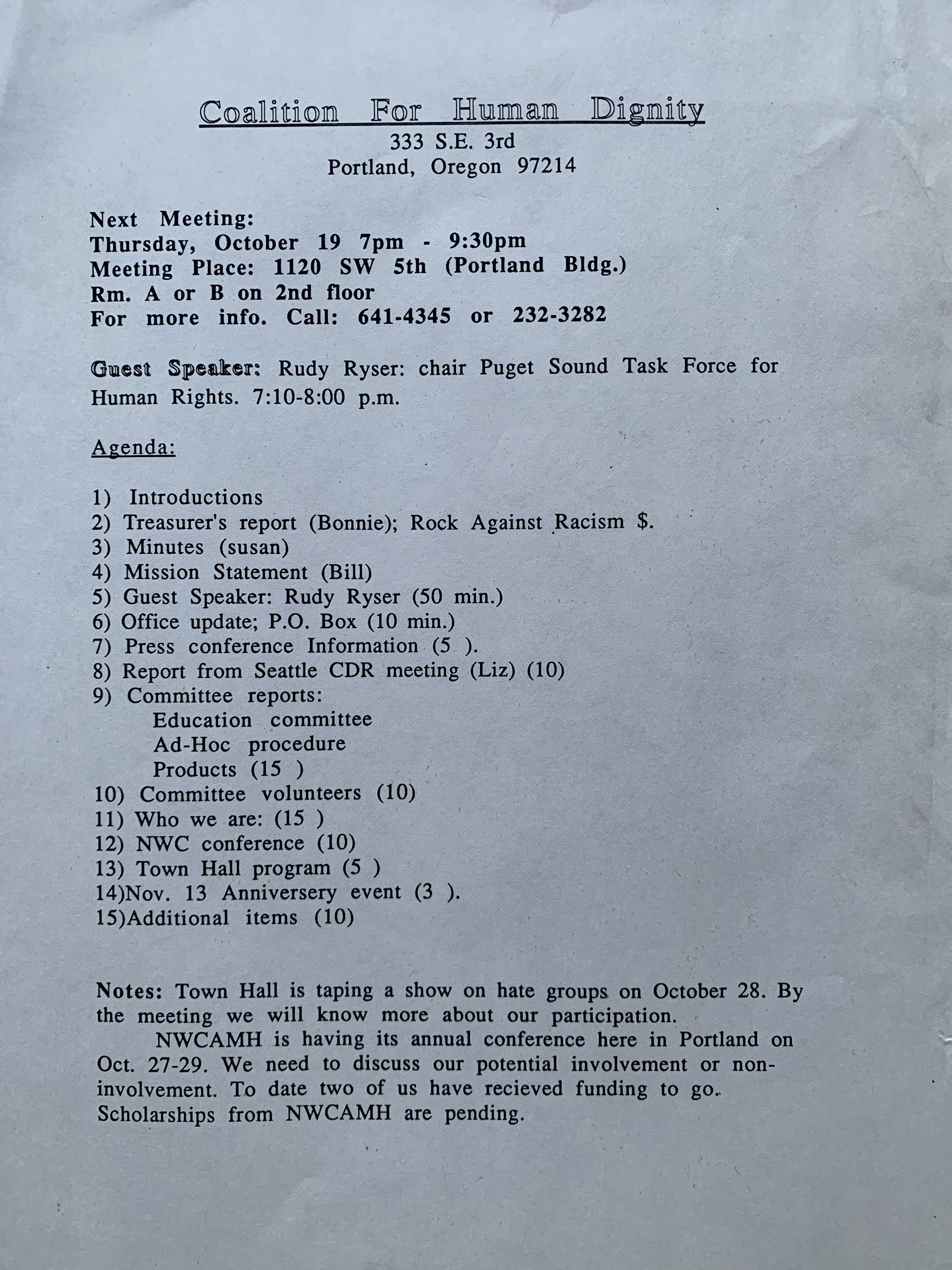
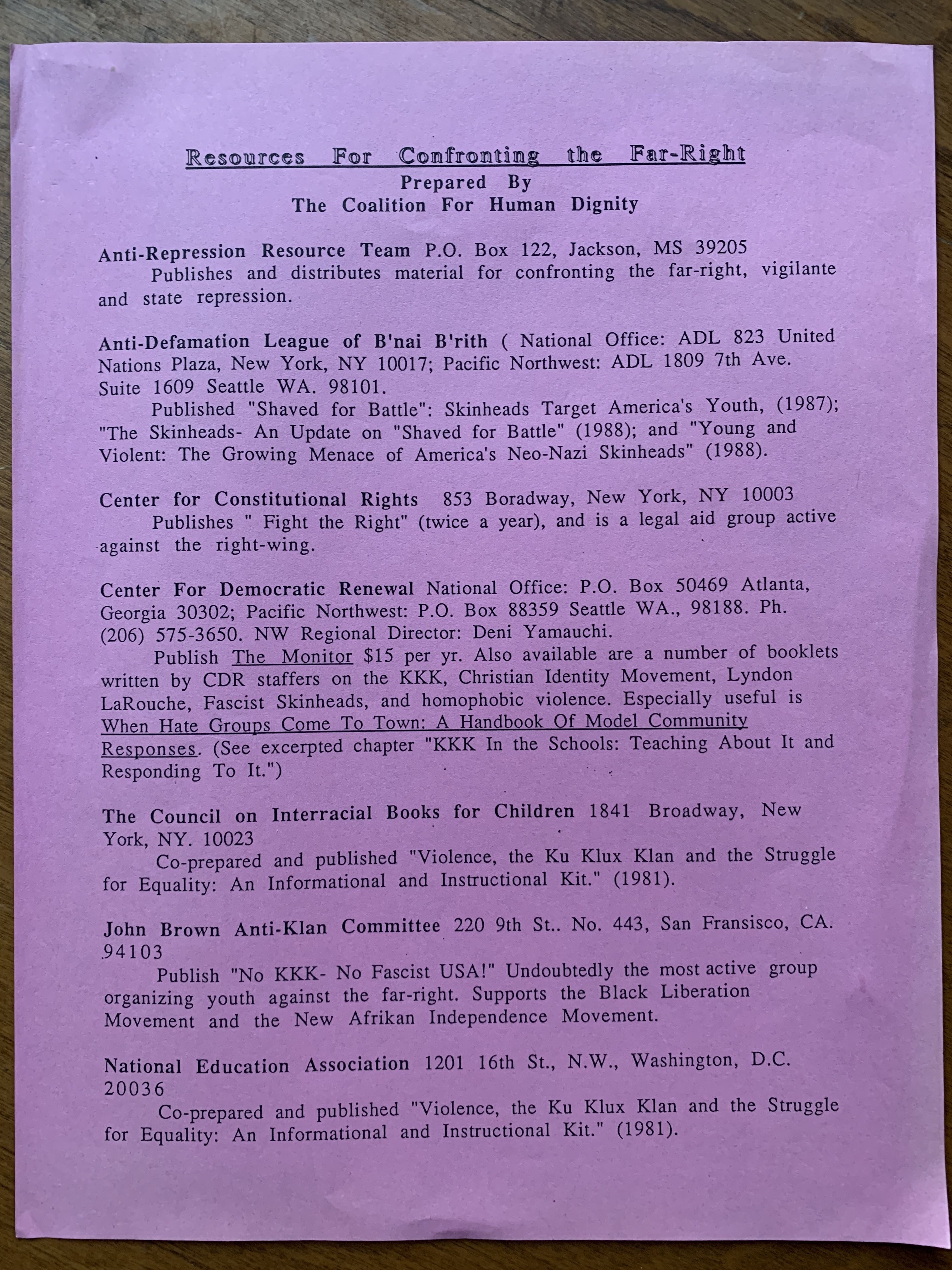
October 25, 1989–M Treloar’s “Rock Against Racism” article in the Guardian. “The coalition, which was originally sponsored by the city of Portland, has developed into a community-based alternative to the ineffectual Metropolitan Human Relations Commission and the Coors/Honeywell-funded Northwest Coalition Against Malicious Harrassment.”
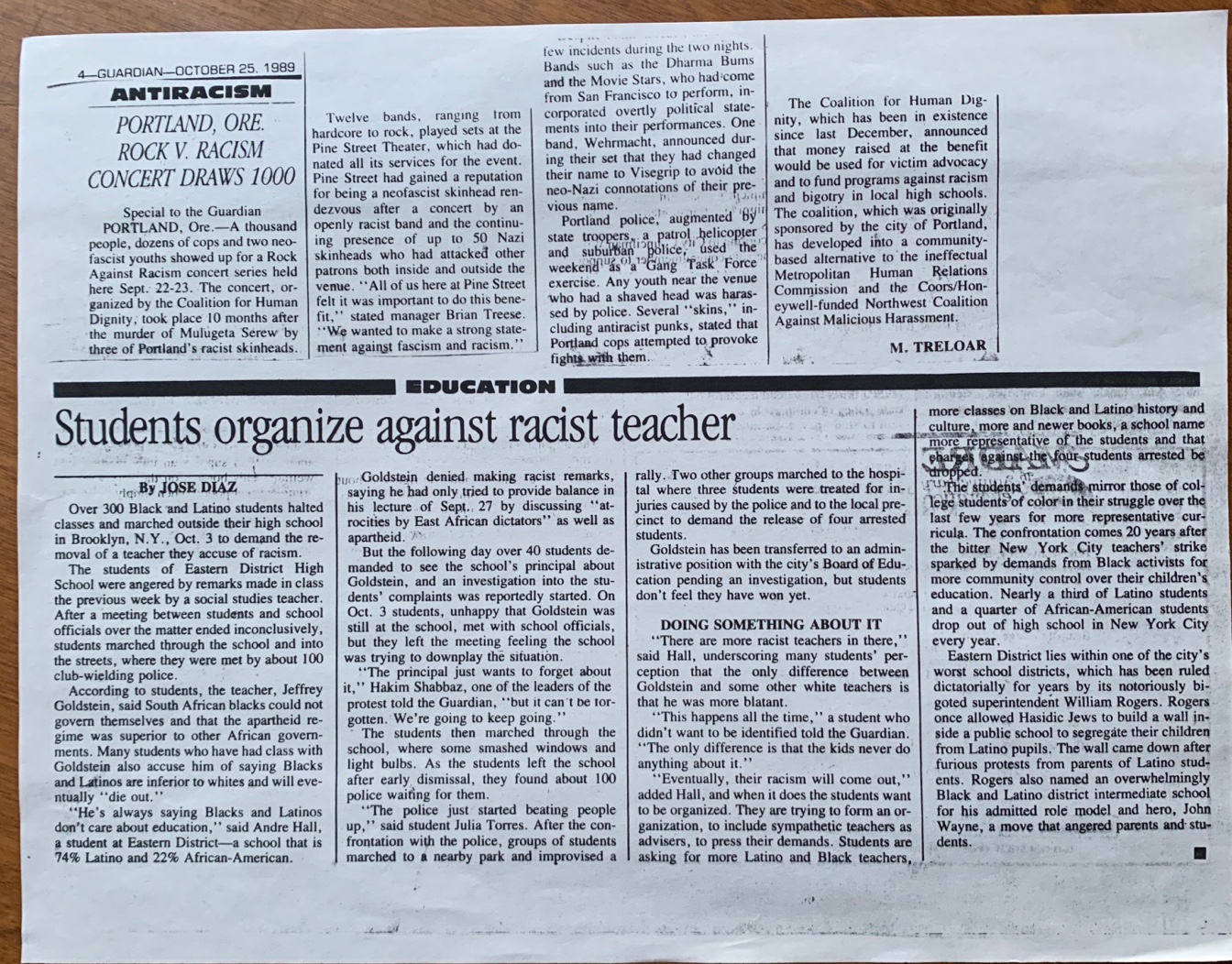
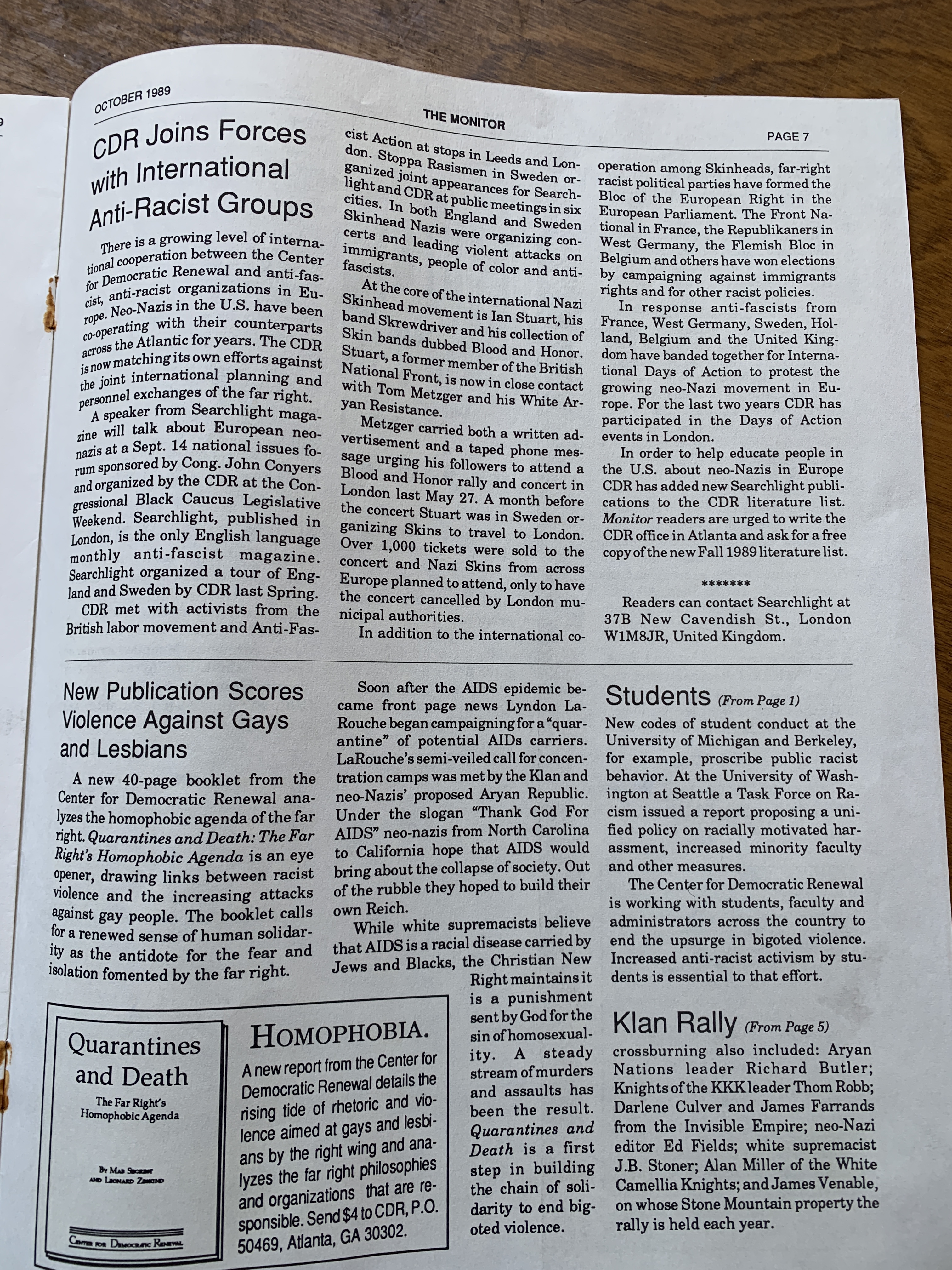
Above: CDR Monitor October 1989 announces joining forces with international anti-racist groups, especially Searchlight.
November 6, 1989–CHD applies to MRG for a grant.
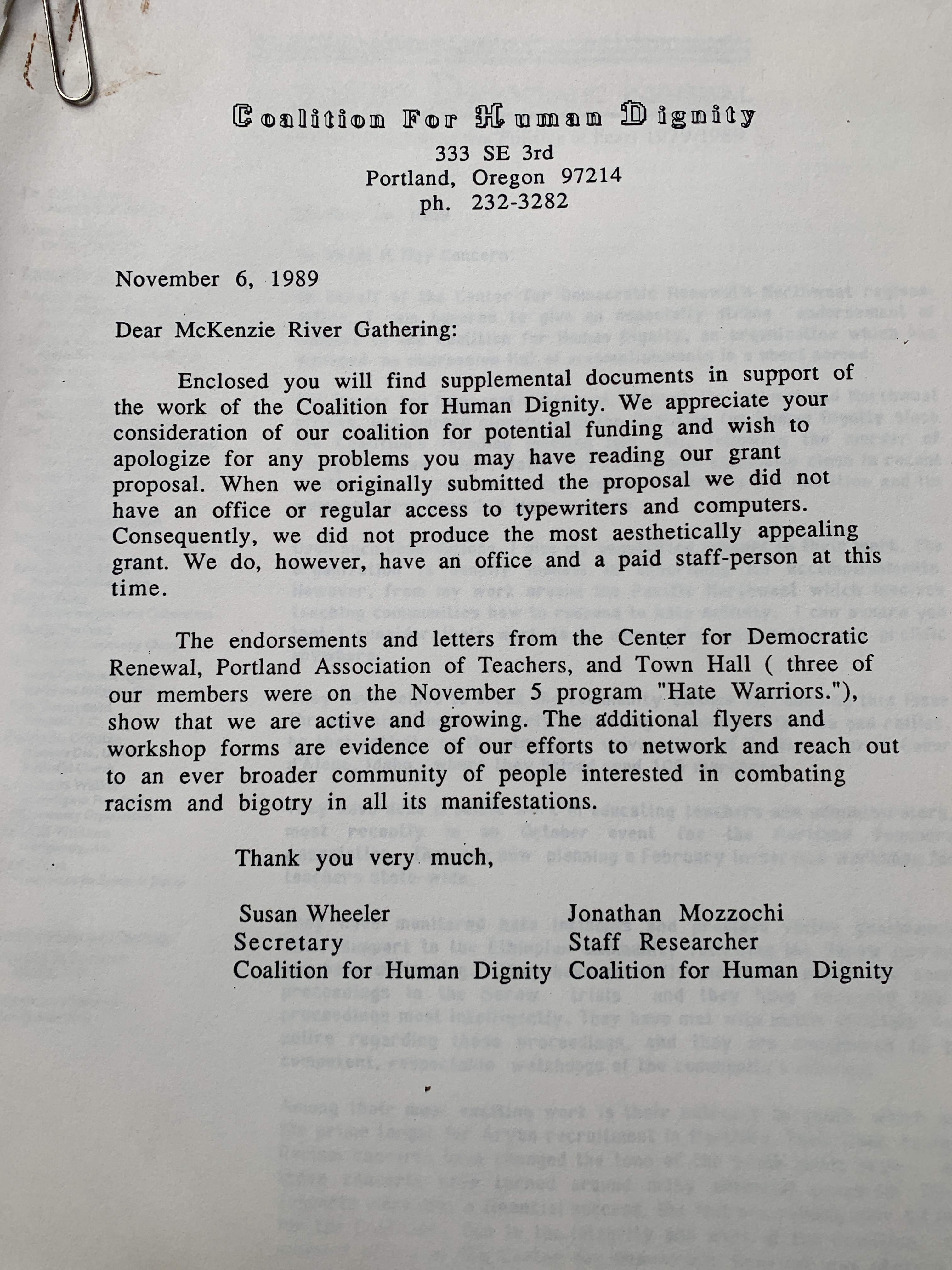

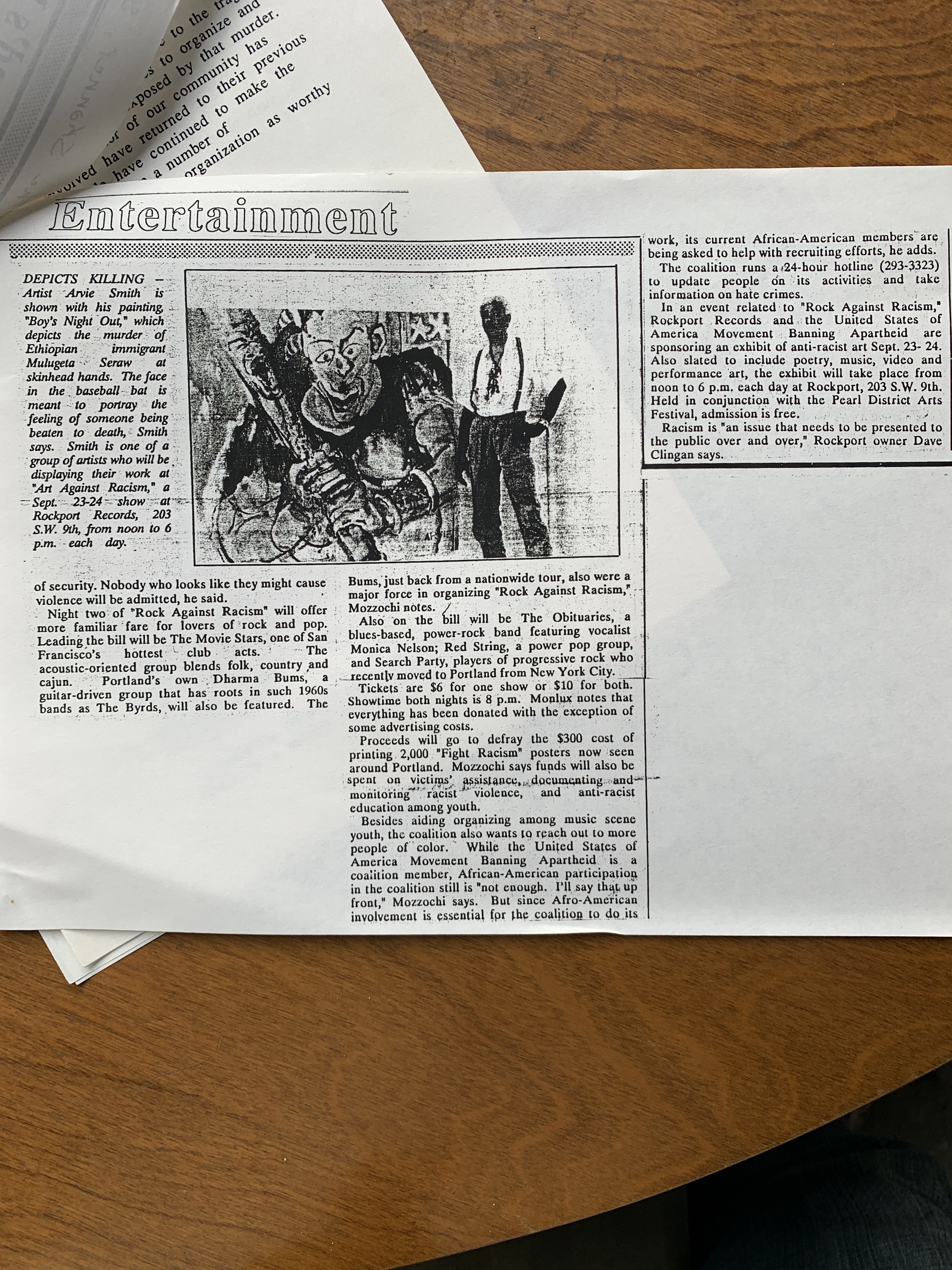
Above: Journalist Patrick Mazza teases out principles first articulated by Anti-Racist Action and Baldies members I met in Minneapolis, Minnesota. Mazza was a keen observer of the Portland scene and his writing was unique. He’s also writing for Portland’s only Black newspaper at the time. I’m trying to apply what I learned from comrades in Minnesota and elsewhere to the situation in Portland.
November 8, 1989–Letter to my mom.
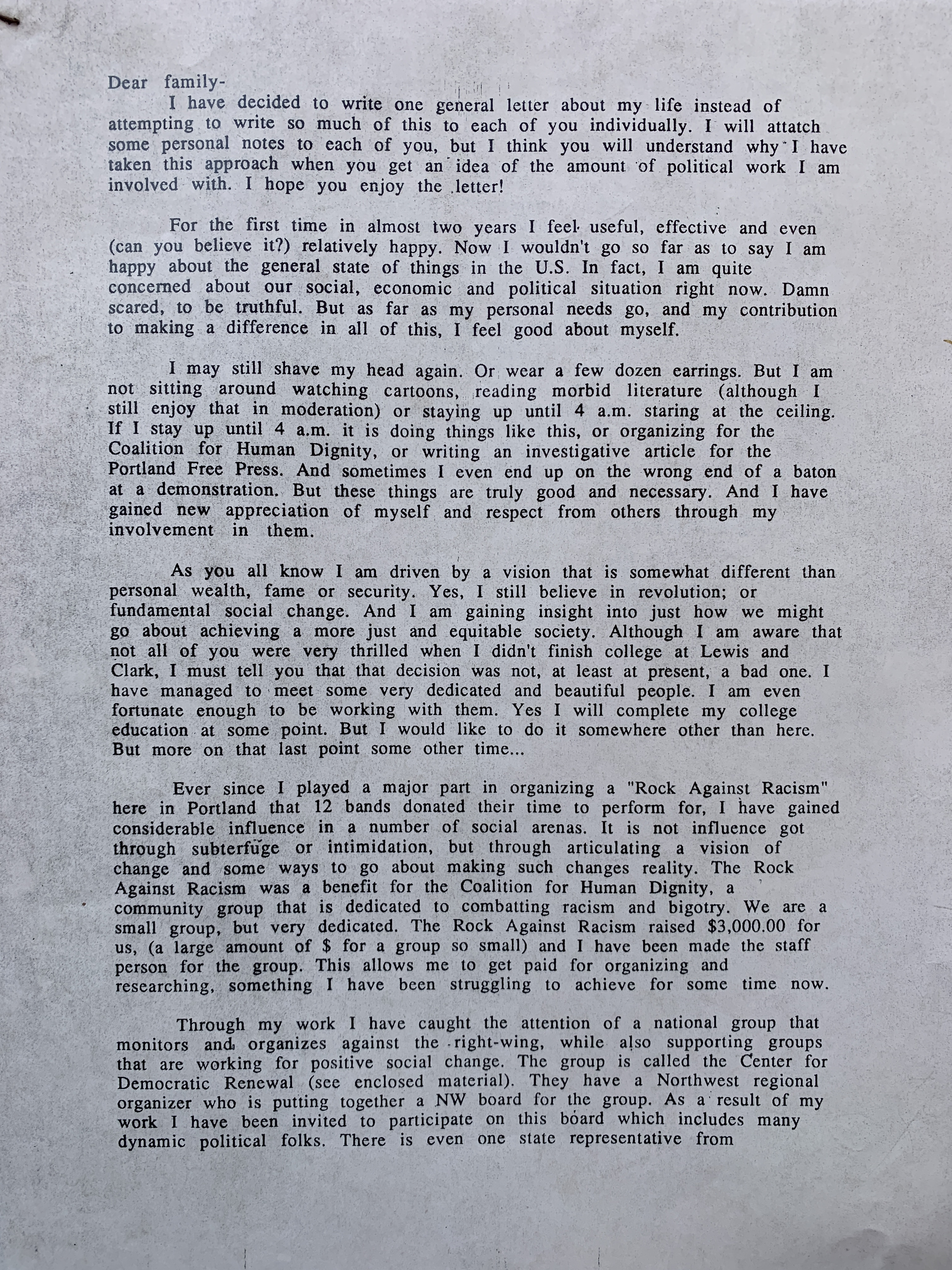
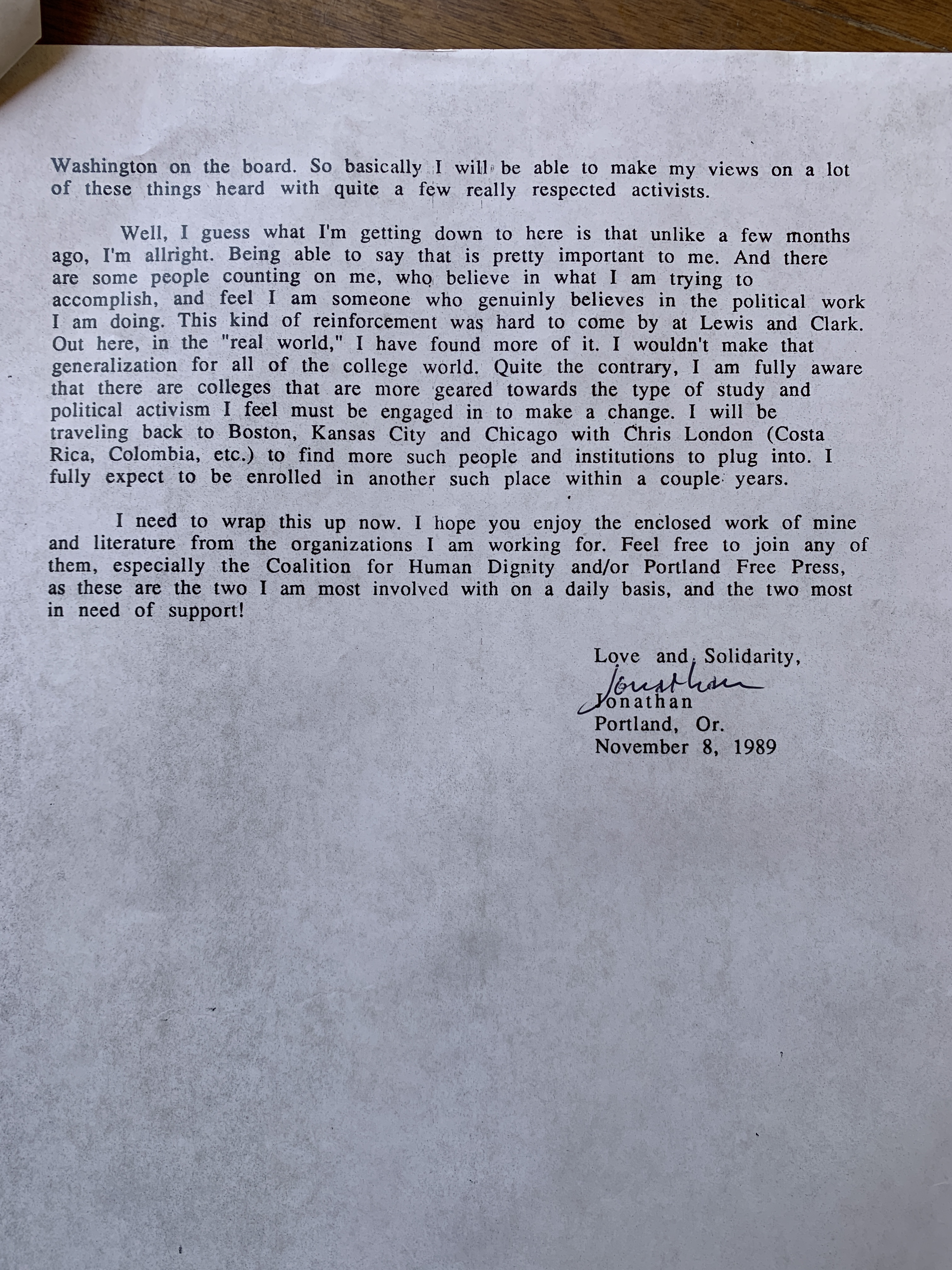
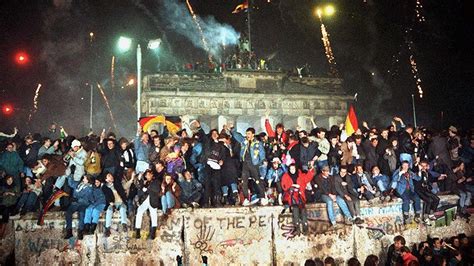
November 9, 1989–Fall of the Berlin Wall. The Cold War anti-communist consensus will increasingly include neo-fascists within it.
January 4, 1990–Partial Mass Direct Action discussion document circulated in Portland, Oregon.
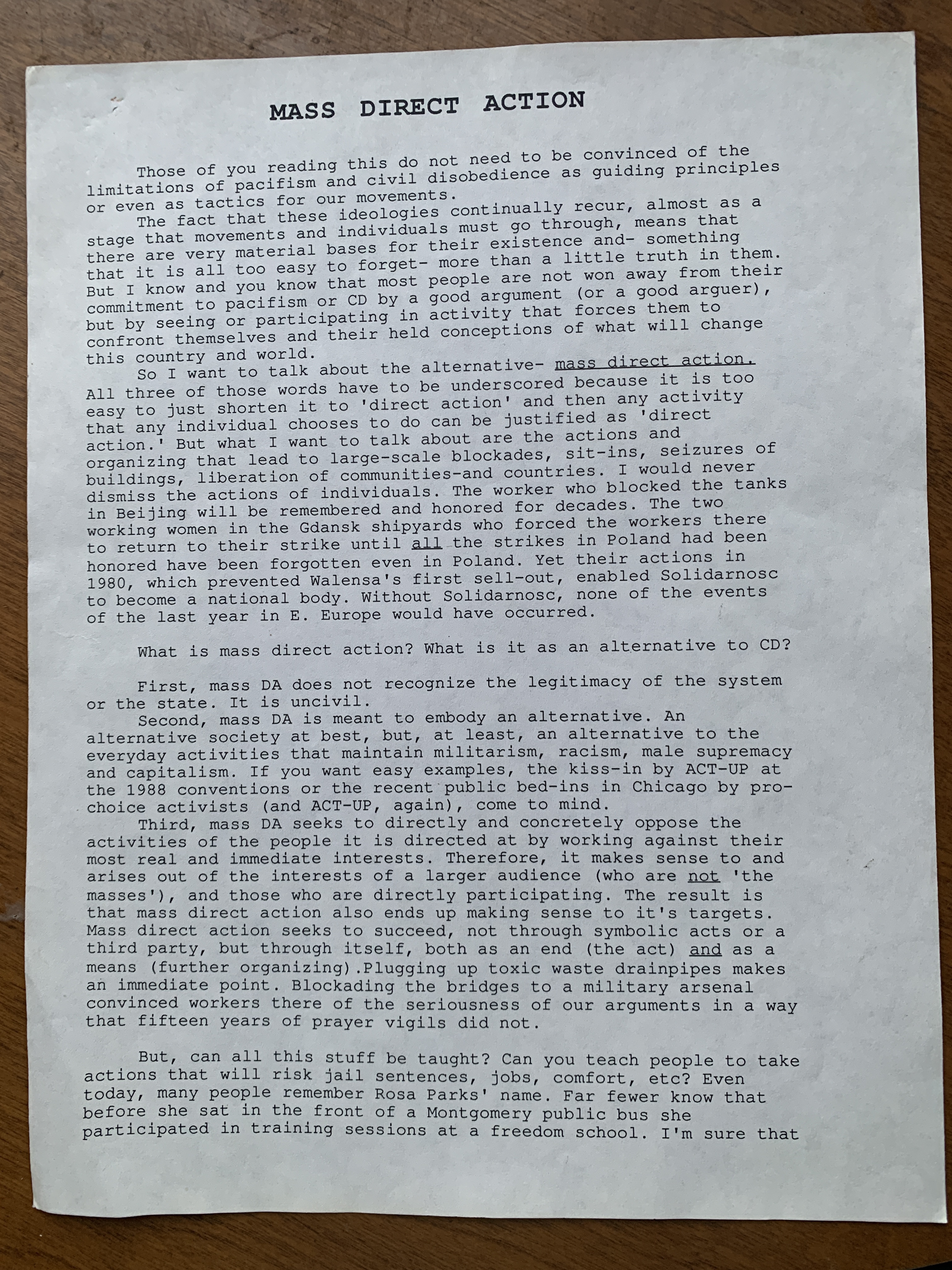
March 3, 1990–the ATF raid homes of activists (including mine) searching for “evidence to commit arson and arson.” Agent John Comey heads up the investigation. No charges filed. I received an anonymous warning of the raid by phone. Portland Free Press article.
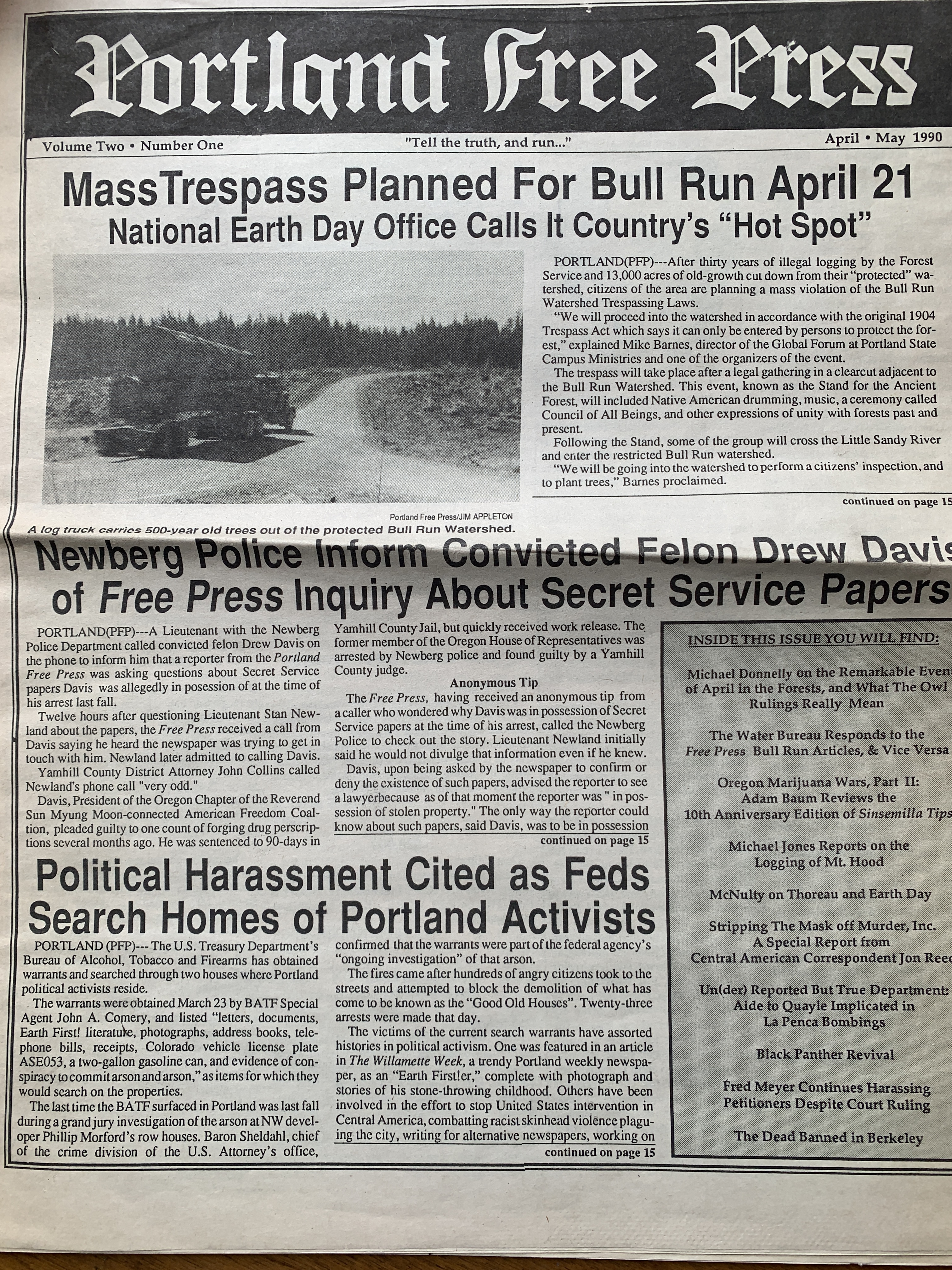
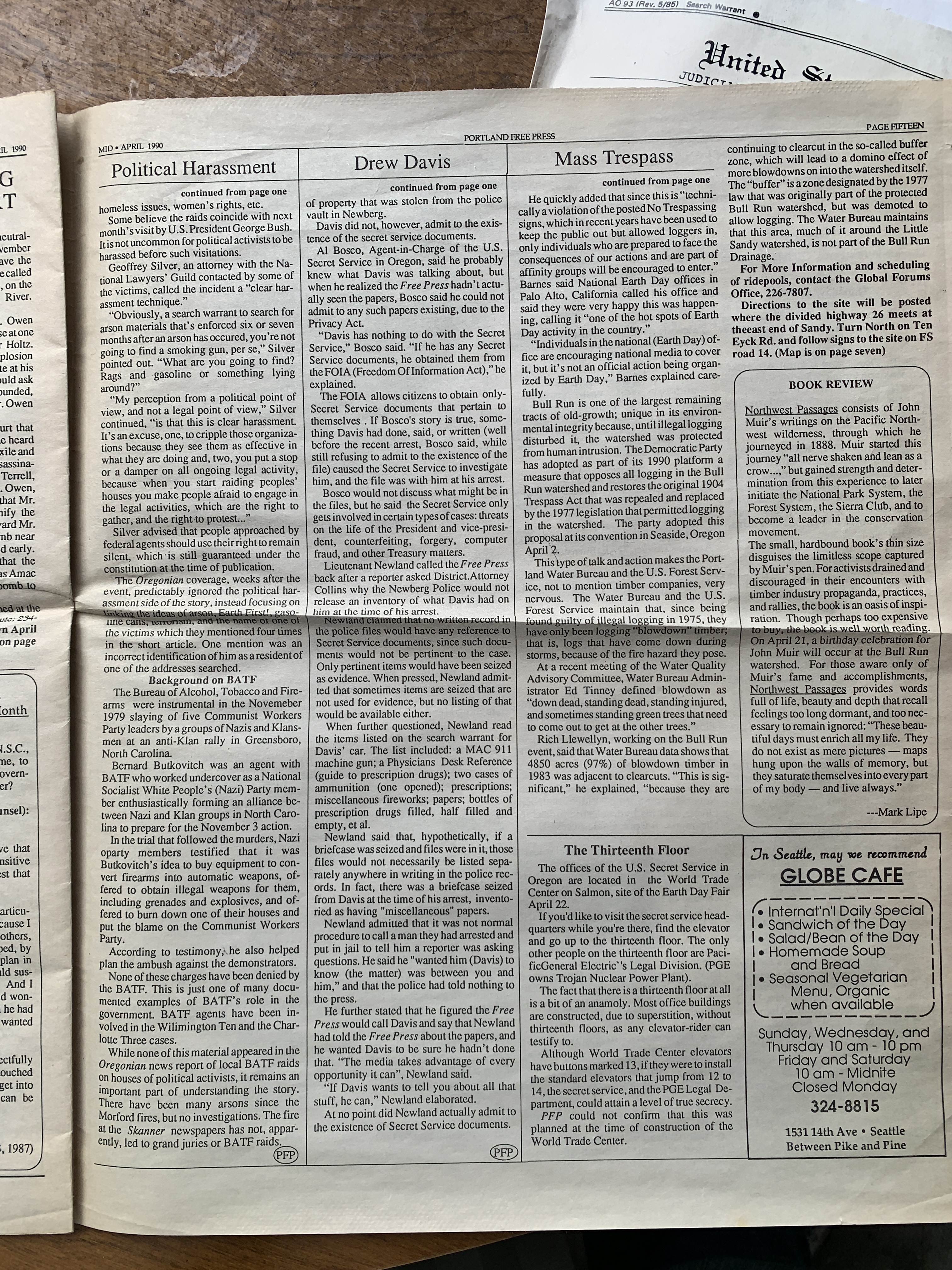

From Portland Free Press event listings:
April 23, 1990–Bell Hooks at Lewis and Clark College.
April 28, 1990–Roxanne Dunbar-Ortiz at L&C.
April 23-28, 1990–Ben Linder Memorial Week in Portland ; construction brigade meetings.
——
May 9, 1990–arson attempt at Lovejoy Surgicenter.
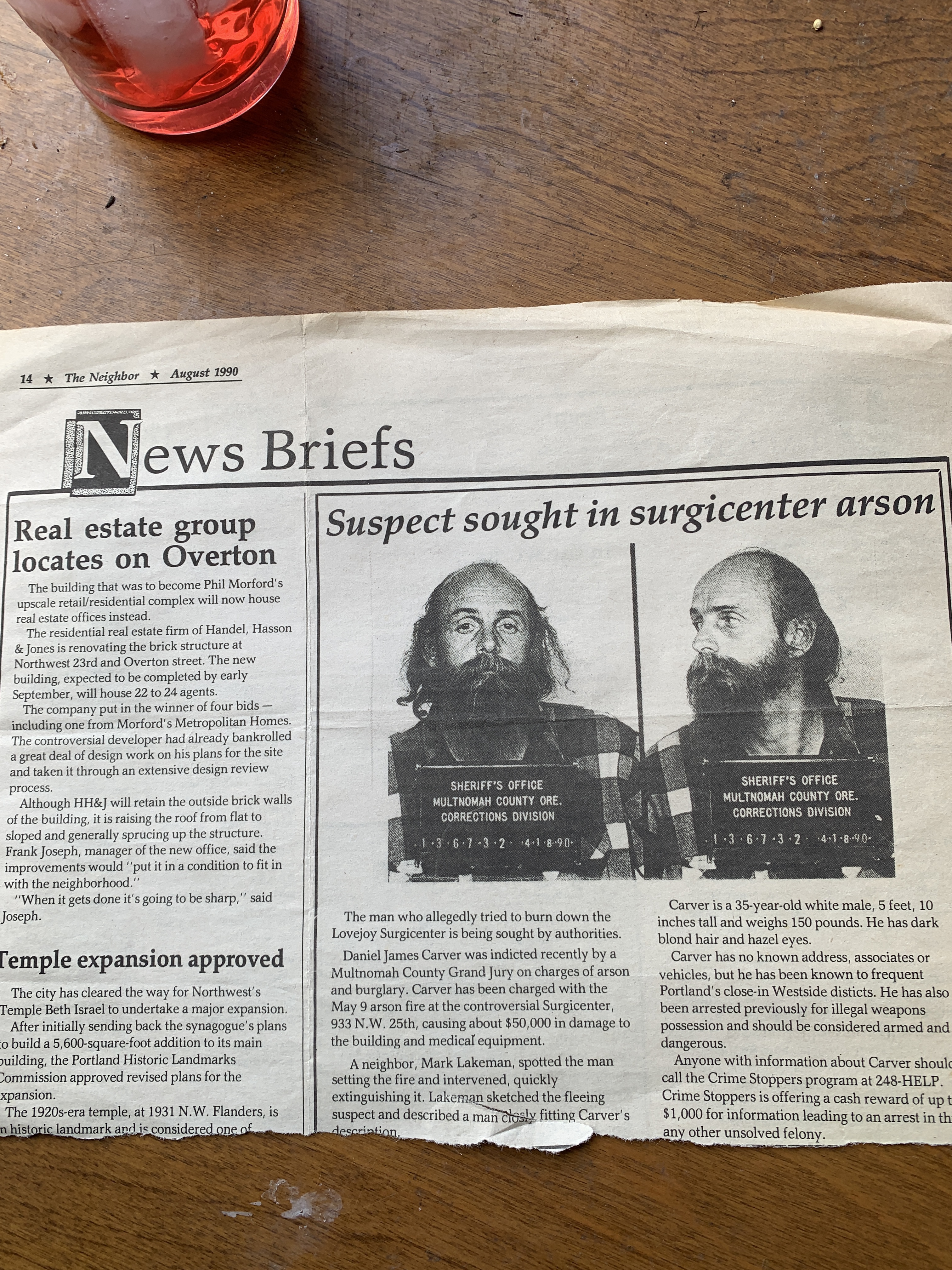
May 16, 1990–Alan Rausch’s “Police distorted incident at park; media added to it” a must read example of activist journalism from that era. Pulitzer Prize in letters to the editor should have been awarded here. Sly dig at journalists who “when in doubt call the sheriff ” and dead possums, from when Portland cops dropped them at a Black business, are devastating. We would get back at the cops only days later at Little Beirut II.
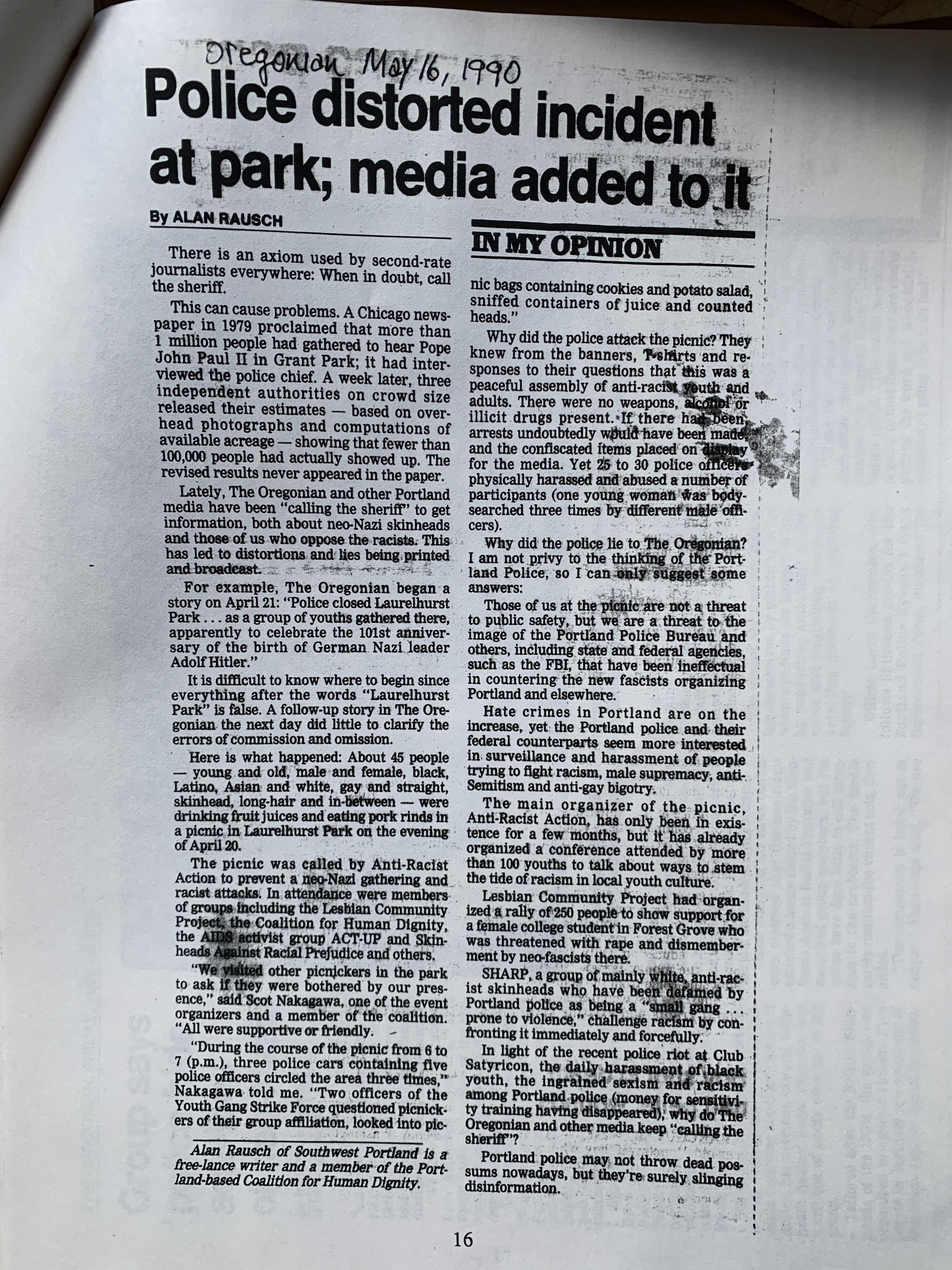
Portland Free Press article, “Newberg police Inform Convicted Felon Drew Davis of Free Press Inquiry About secret Service Papers.” Davis was a former Republican Oregon House rep. and then President of the Sun Myung Moon-connected Oregon chapter of the American Freedom Coalition. Davis was convicted of forging drug prescriptions.
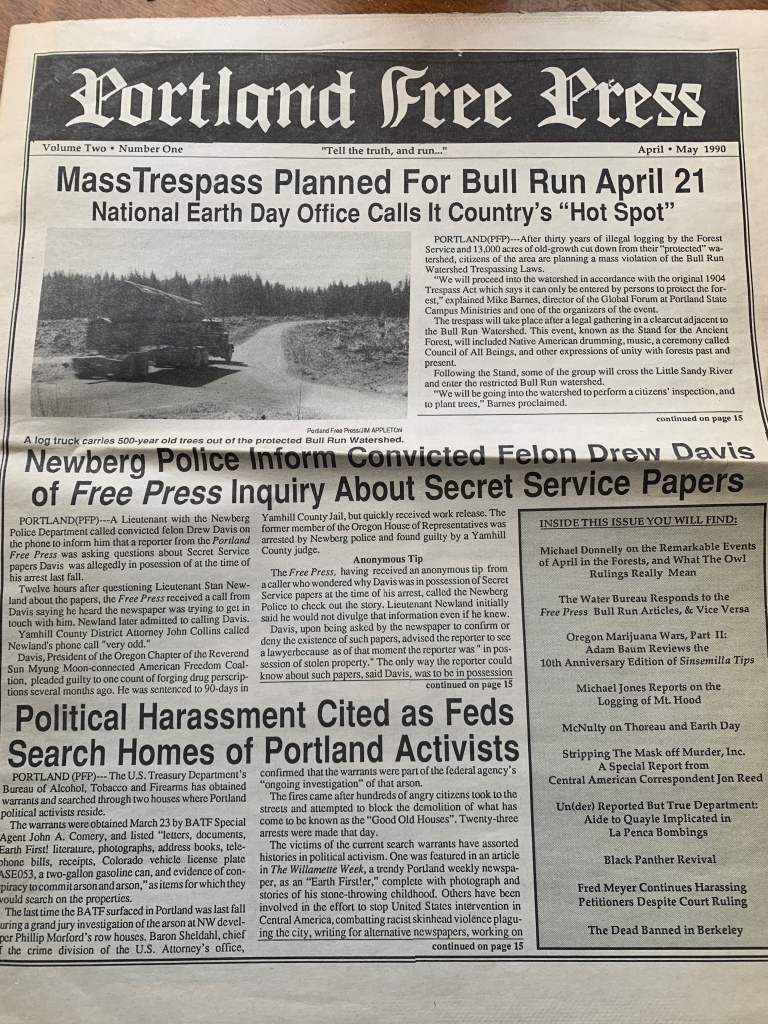
May 18, 1990–CHD, the Lesbian Community Project and SHARP represented by Donna Redwing, Scott Nakagawa, and Dave Lamb, respectively, hold a press conference denouncing police harrassment of anti-racists. CHD releases “Report on the Community Defence Project on Organized neo-fascists in Portland, Oregon.” In the early days CHD would sometimes use the term “fascism” as a general descriptor. The report was a collective effort and fourteen contributors are listed. It’s an important documentation of the rancid role of the PPB in protecting boneheads and a great snapshot of CHD beginning to do action-oriented research.
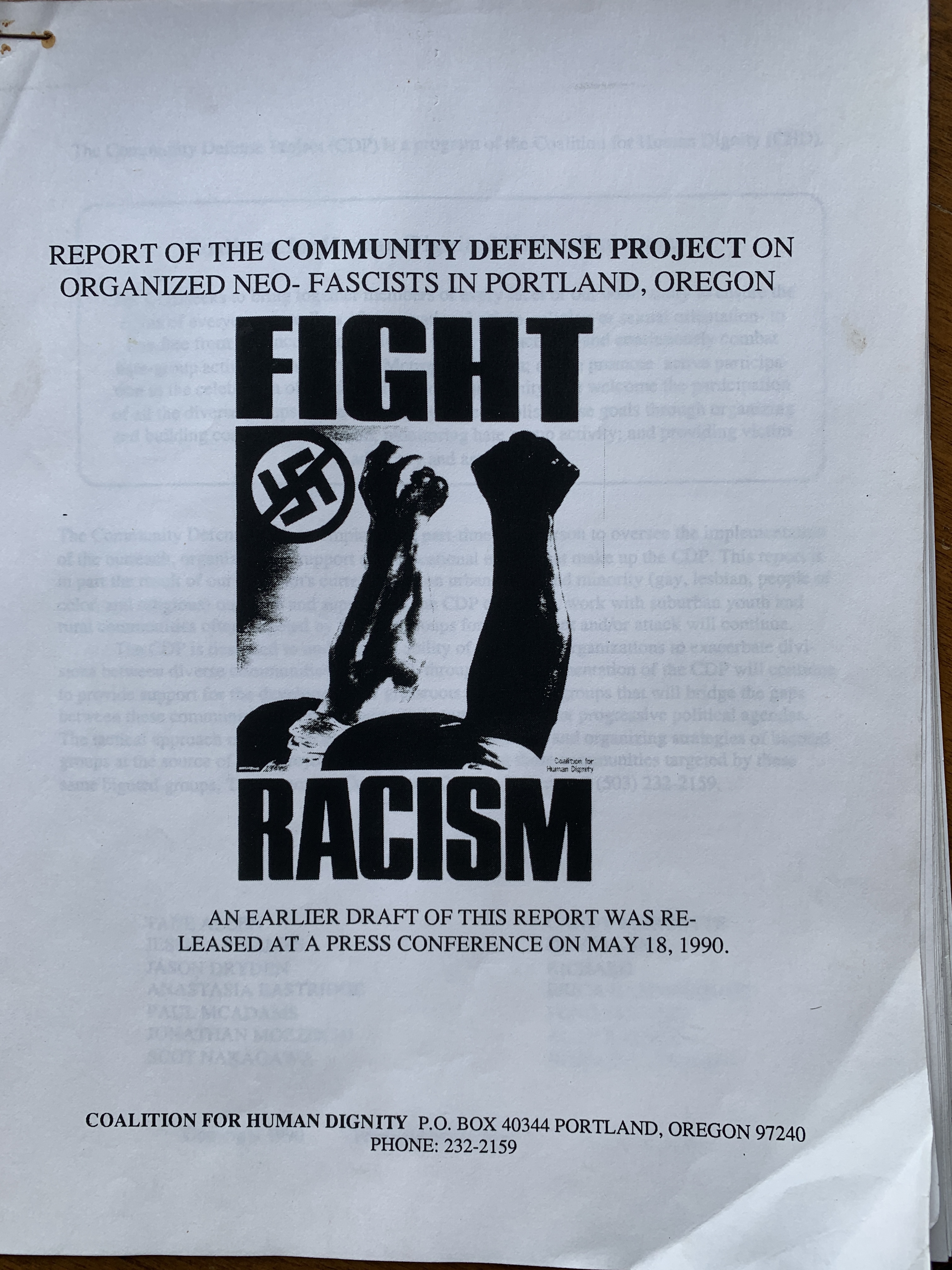
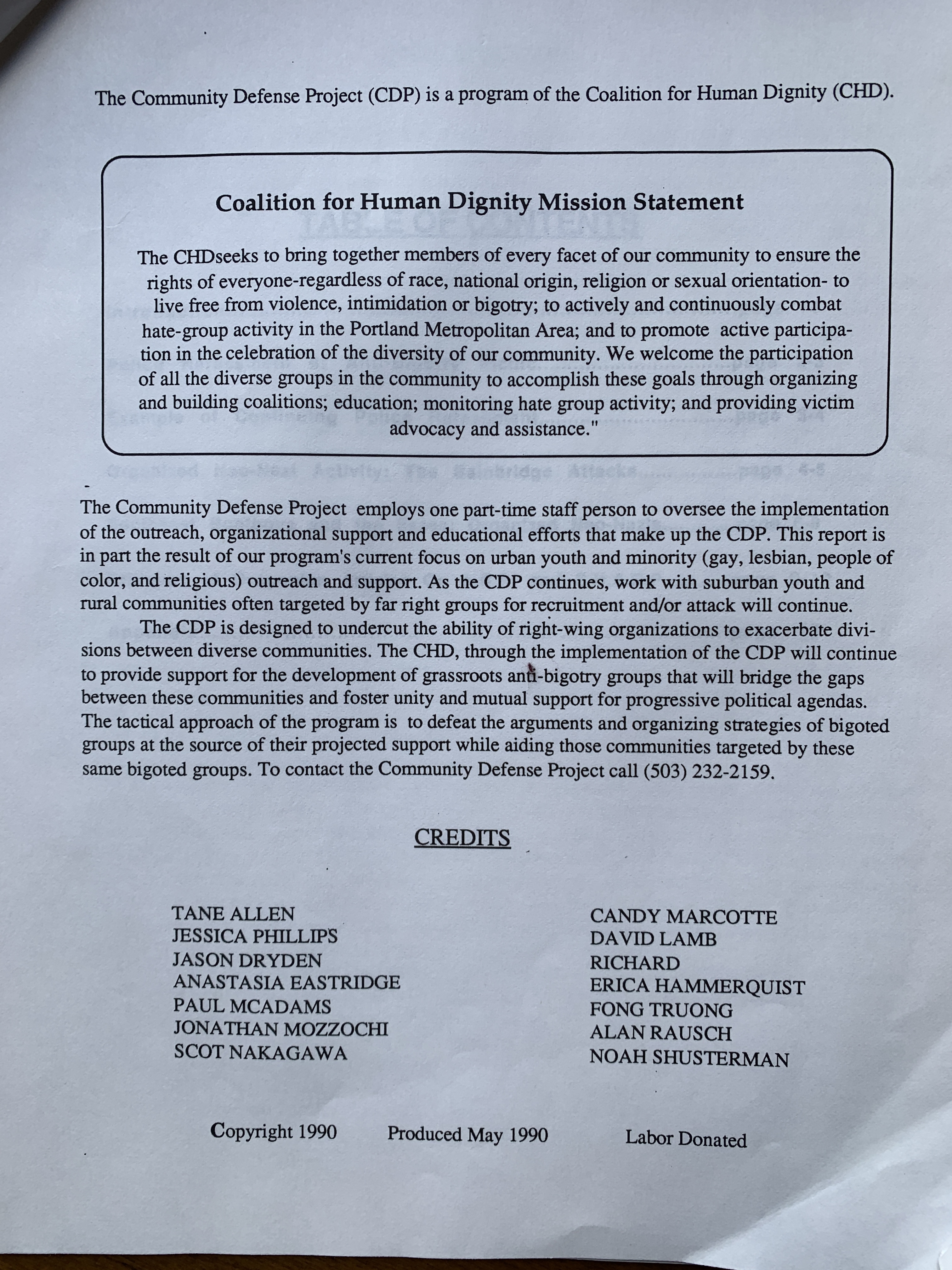
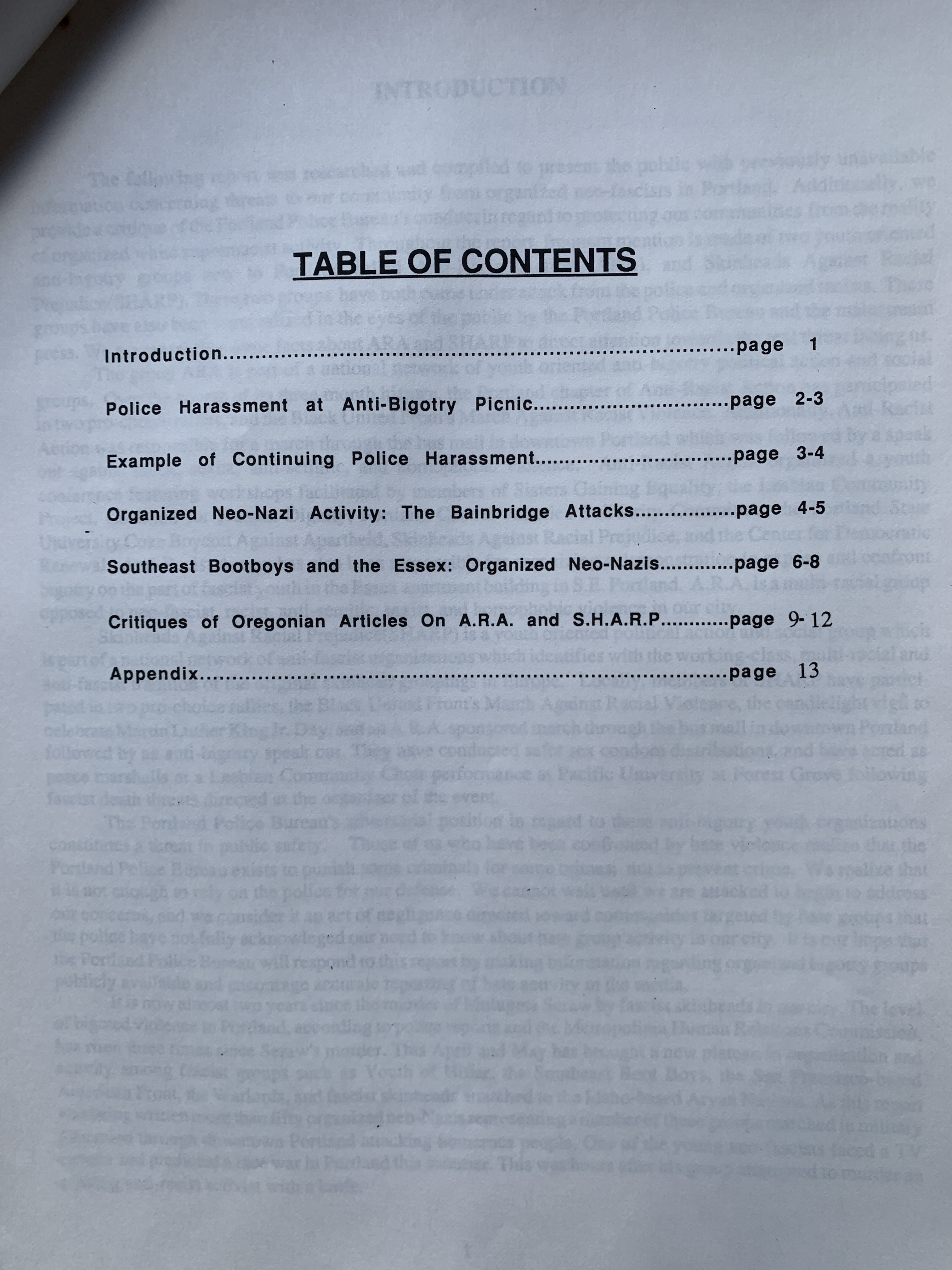
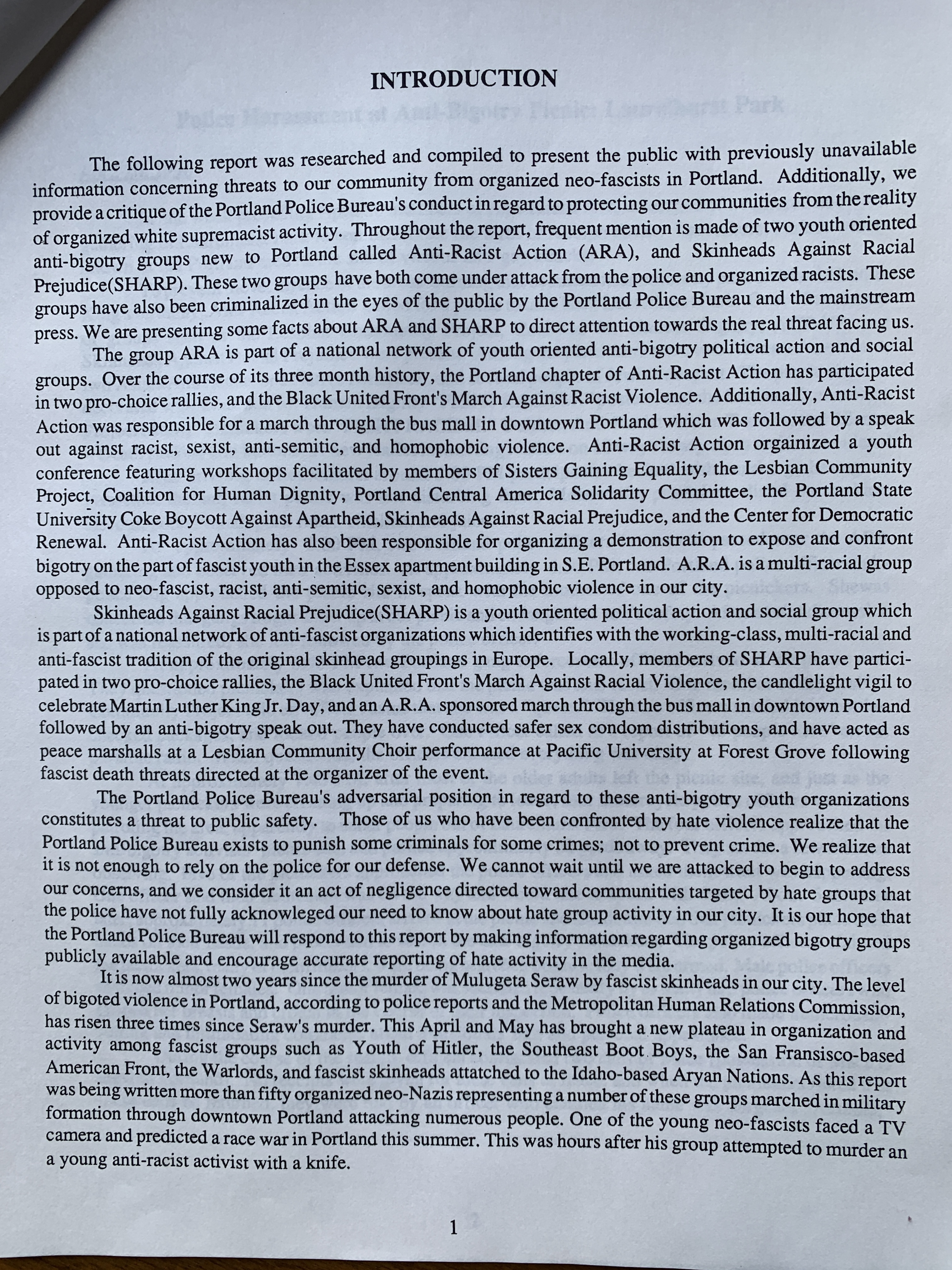

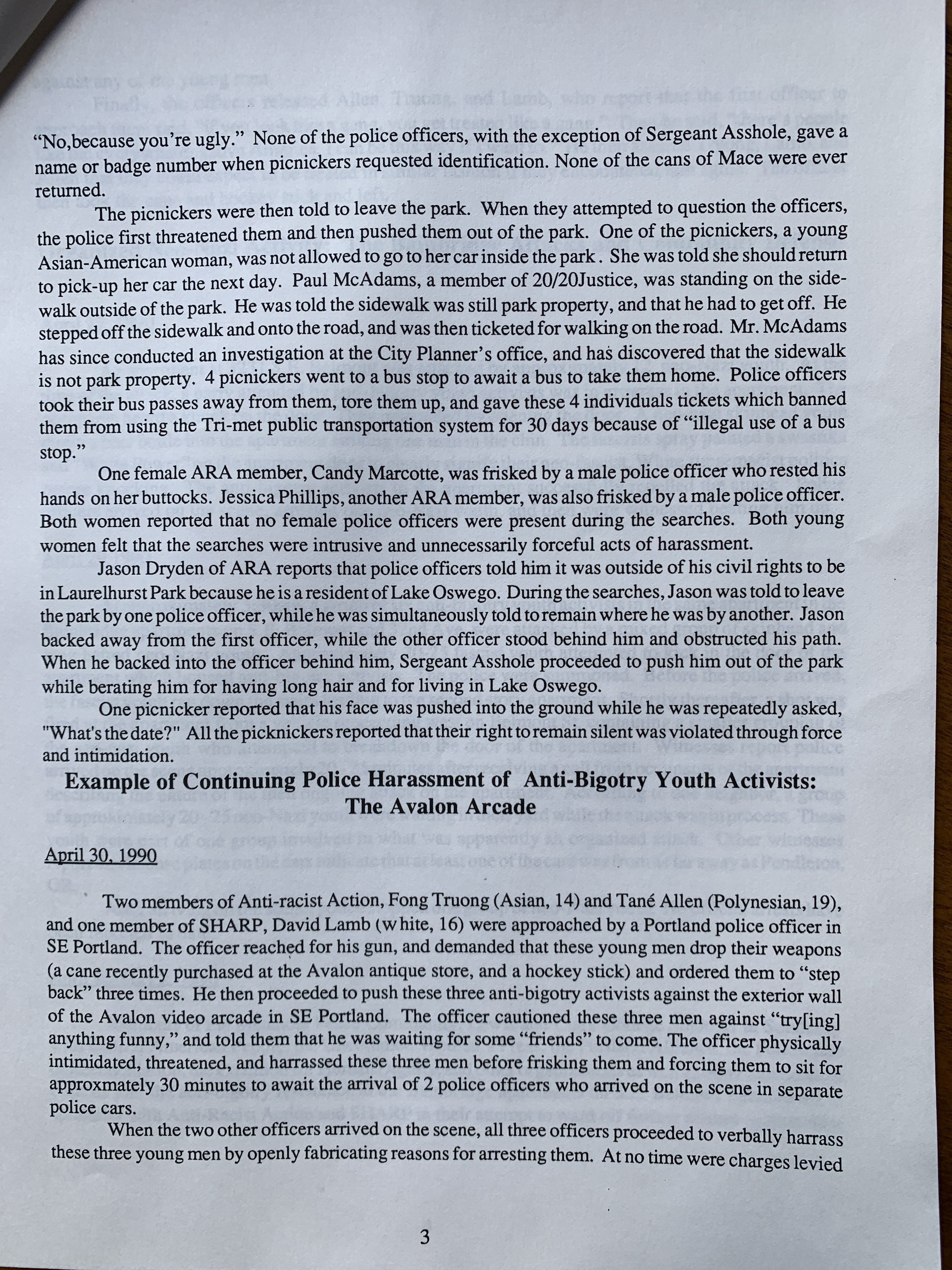
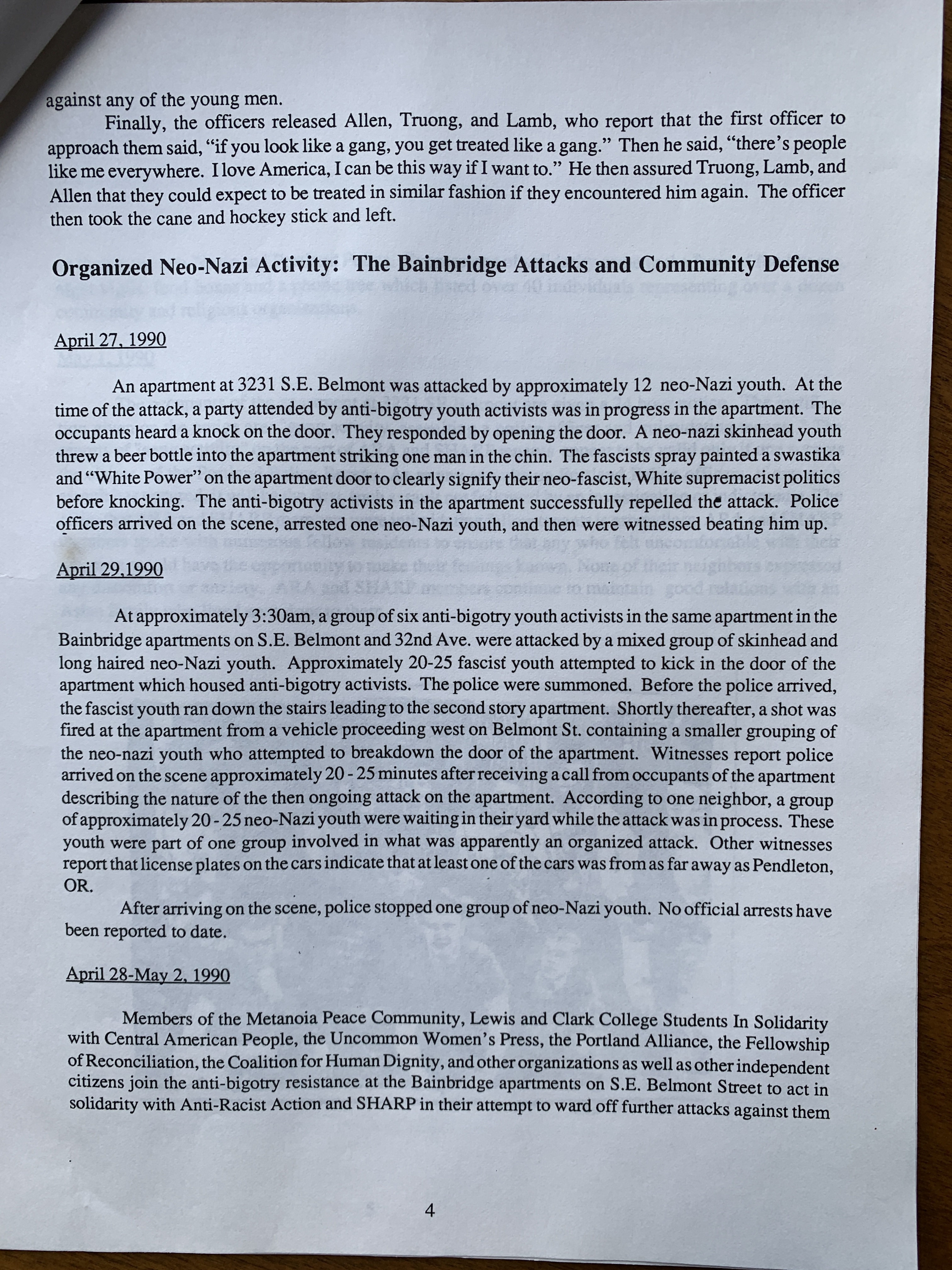
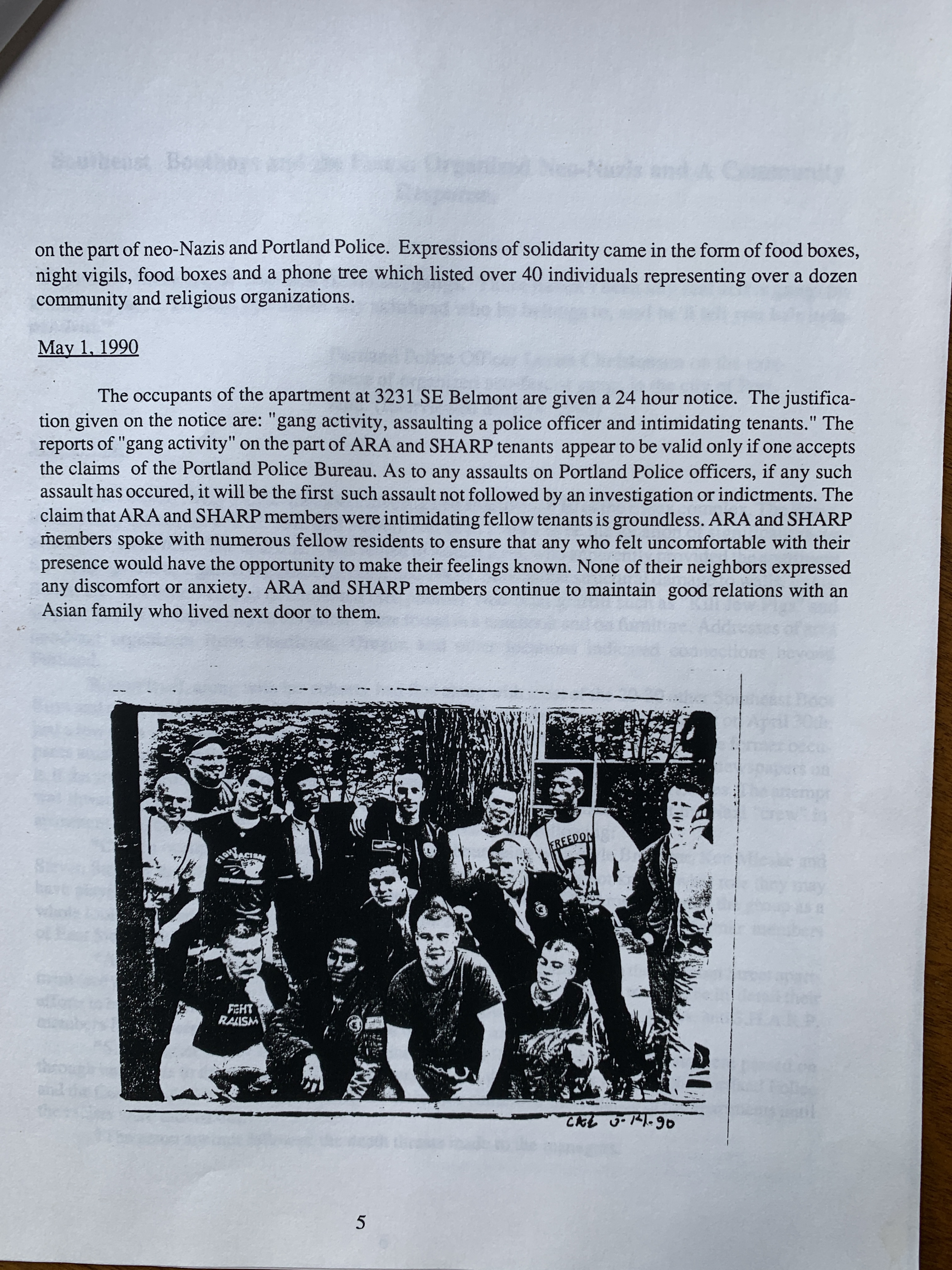
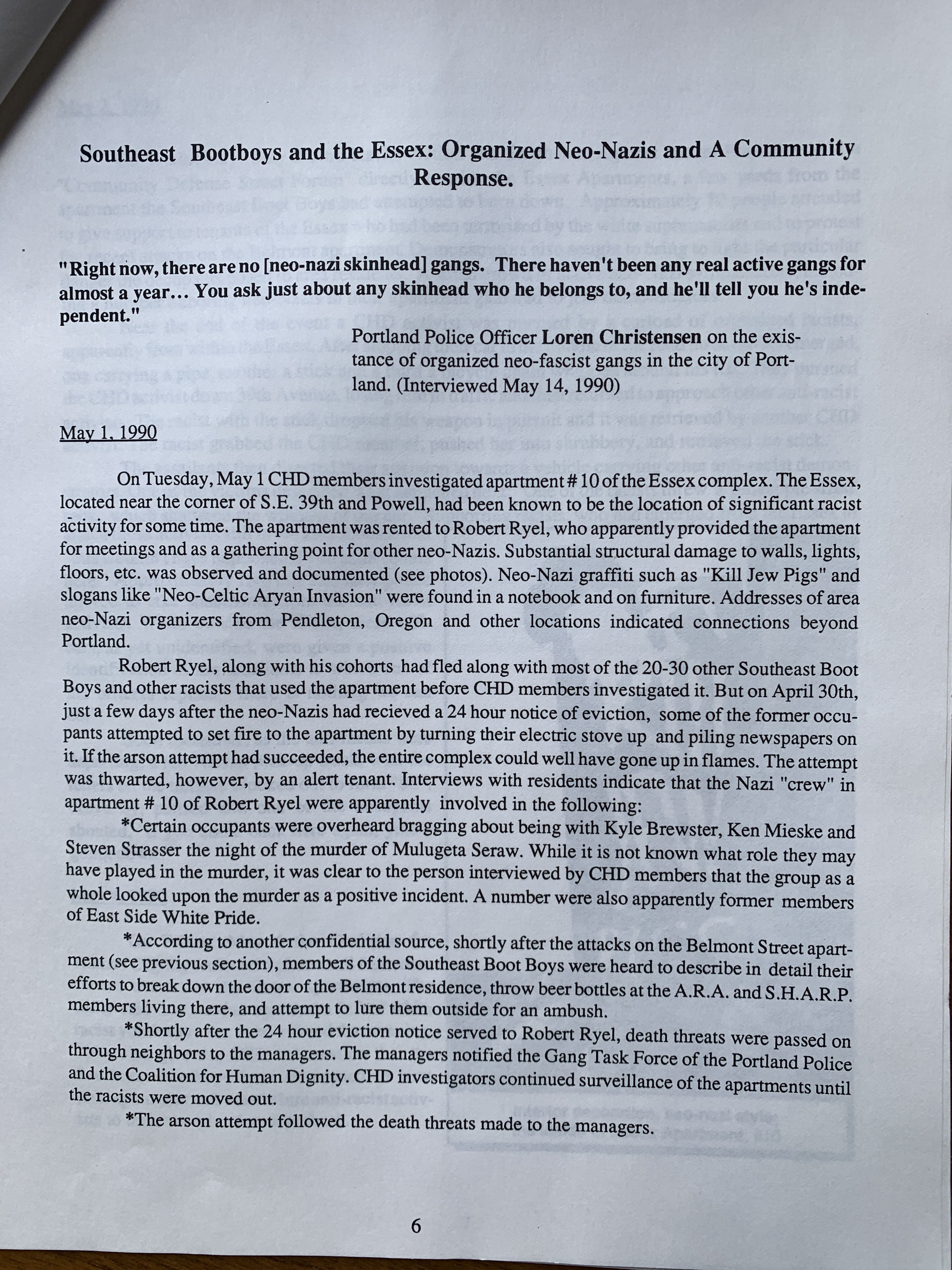
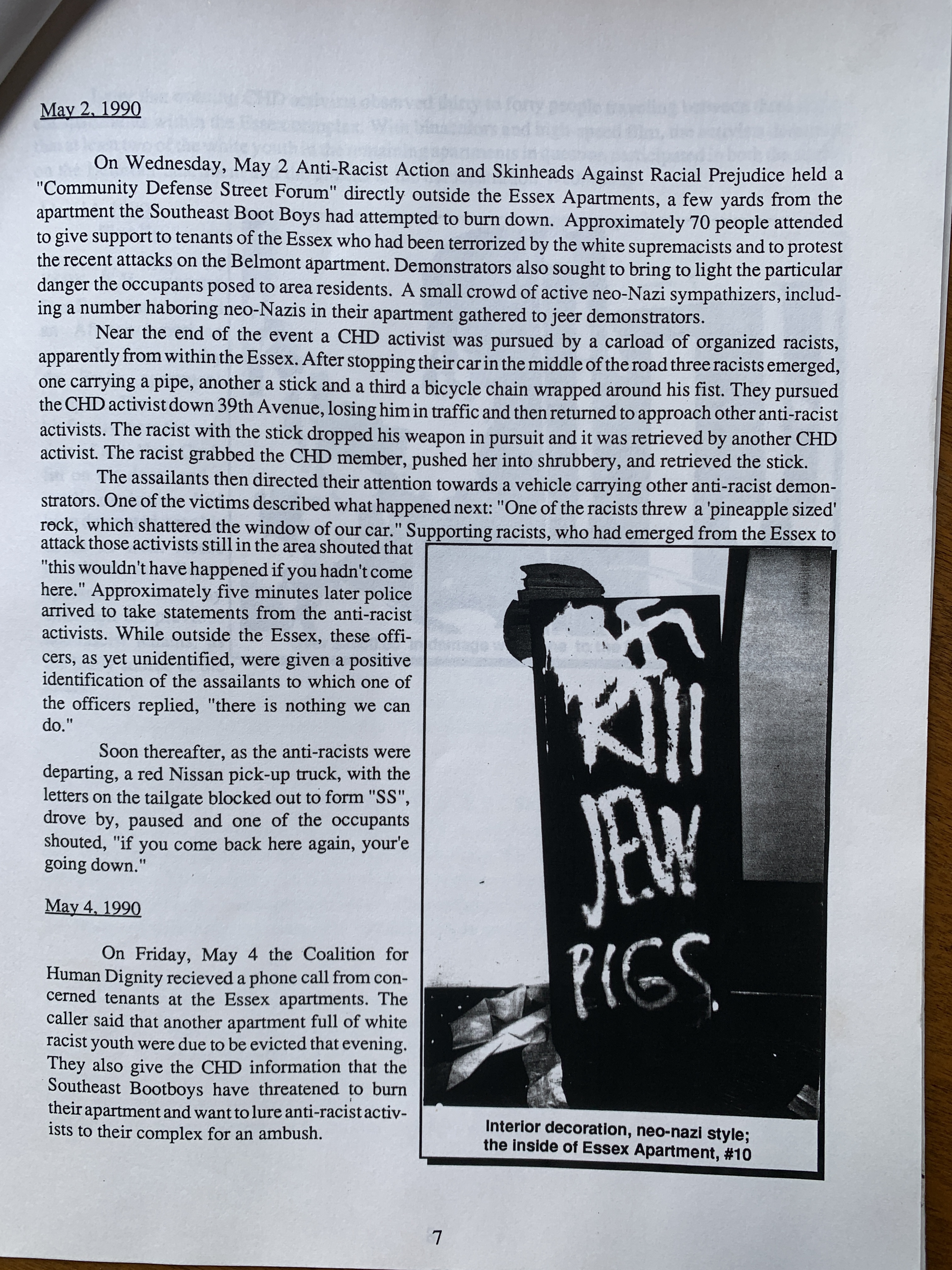
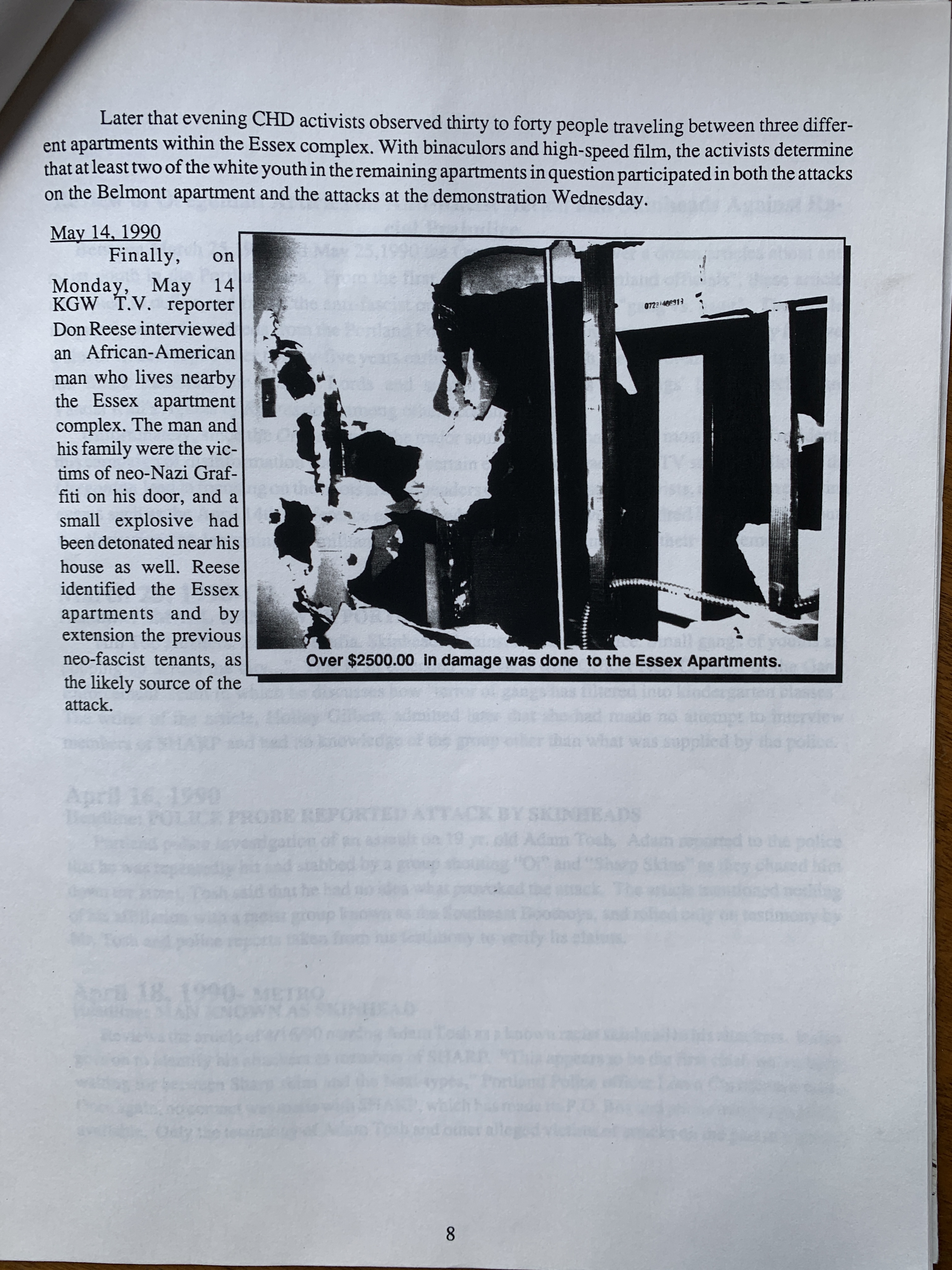
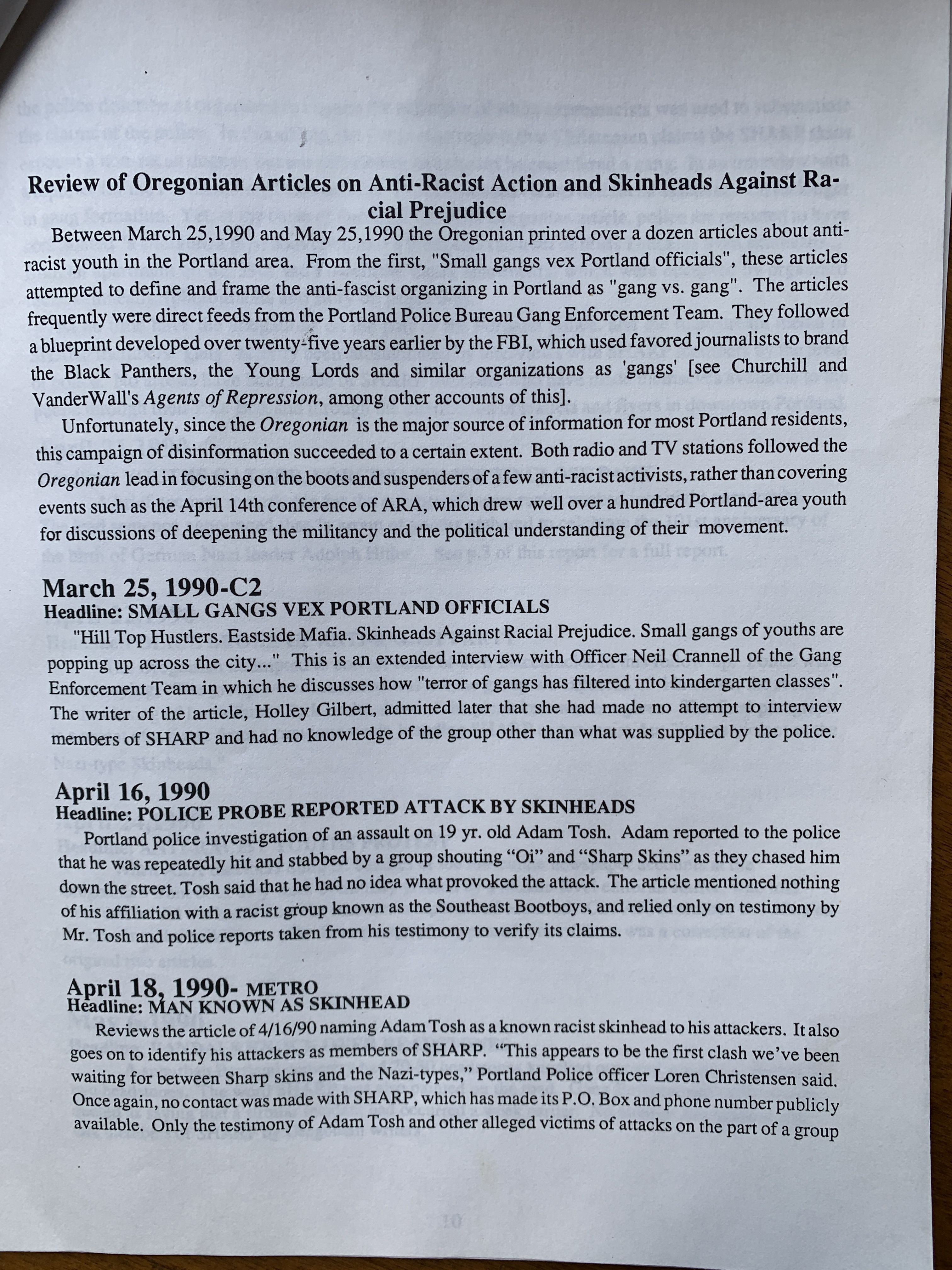
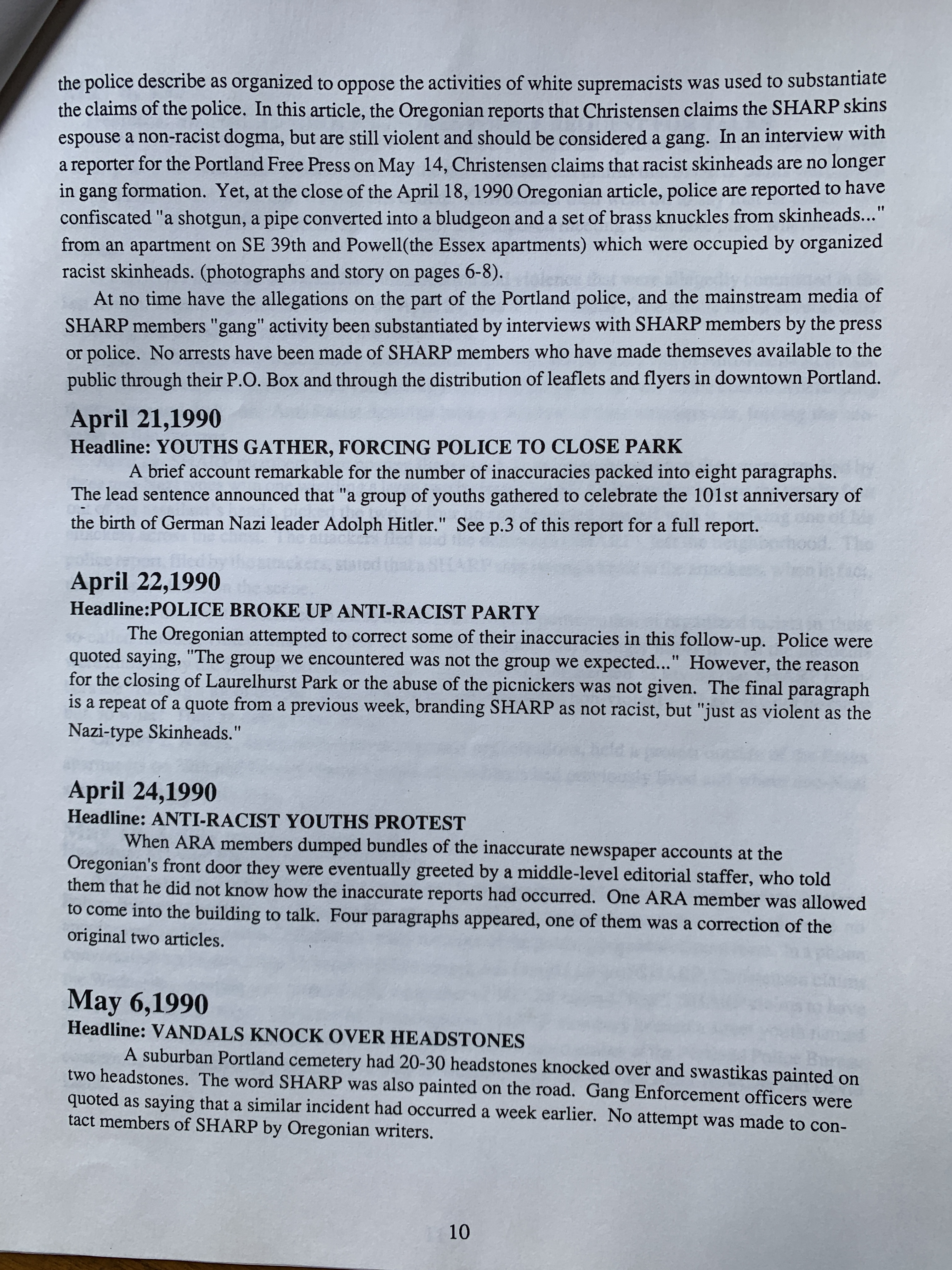
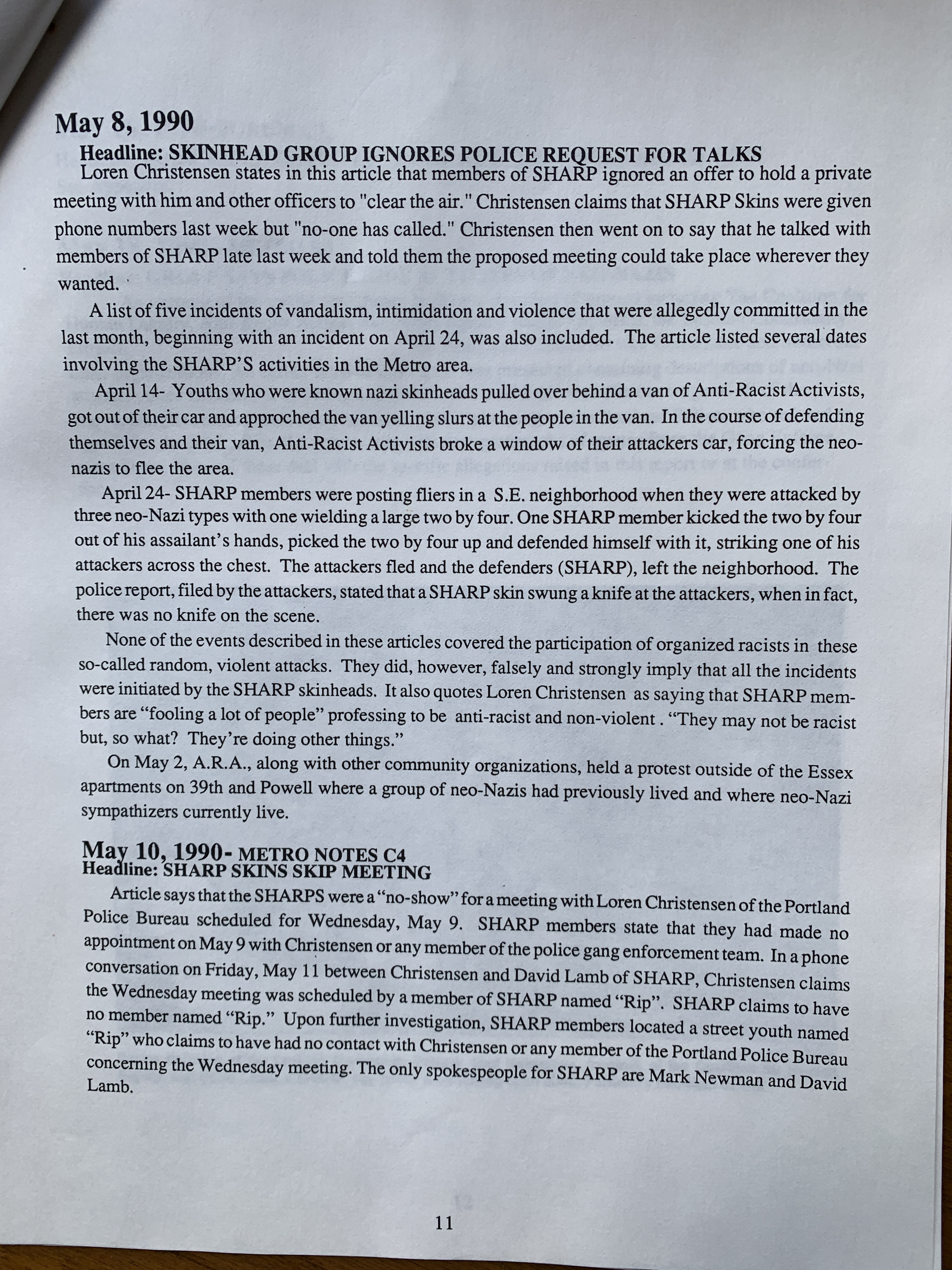
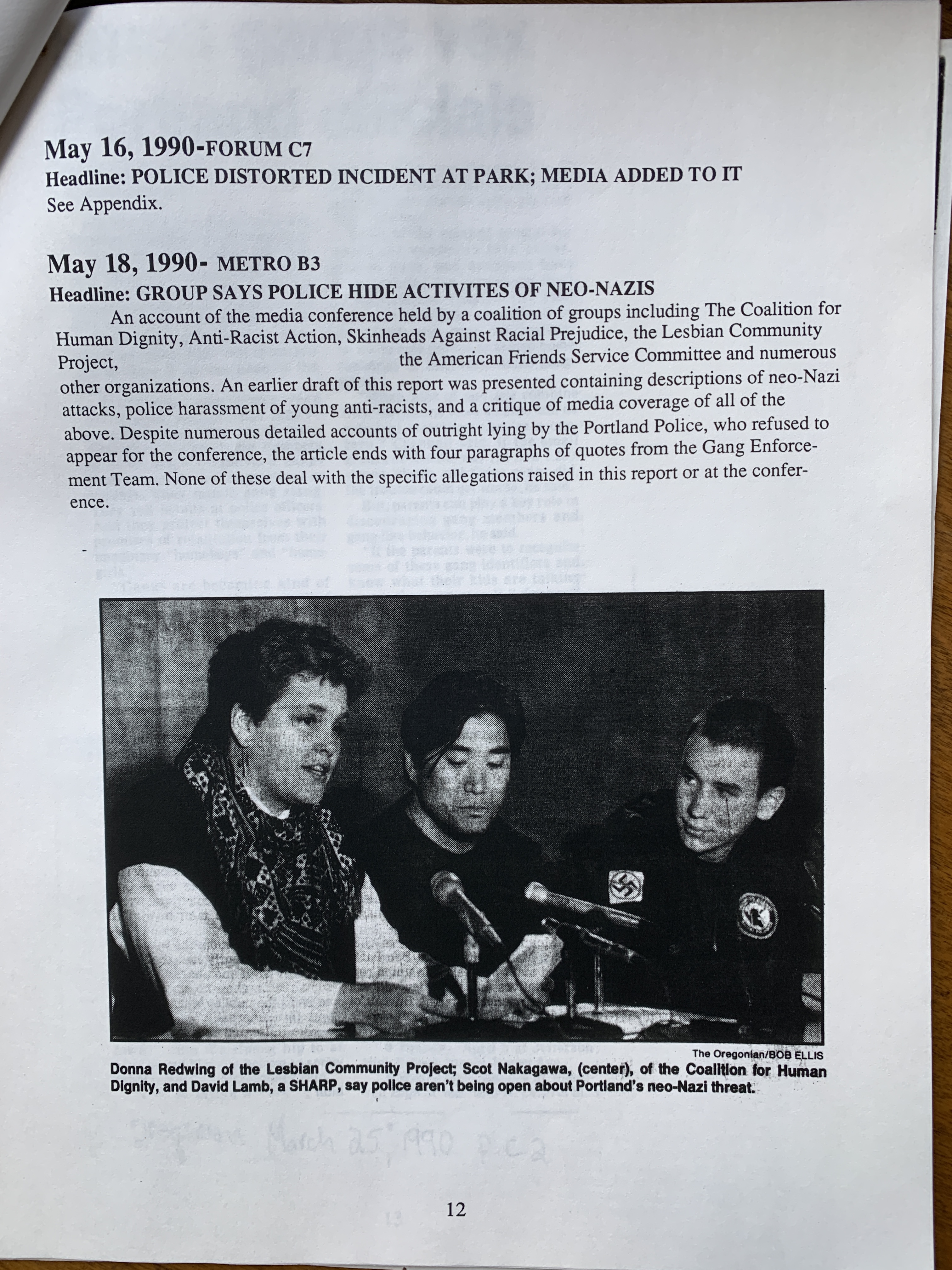
May 21, 1990—Little Beirut II
“The following May, President George H.W. Bush himself came to town to help raise funds for then-Republican gubernatorial candidate Dave Frohnmayer. Three hundred protesters greeted the well-heeled Republicans with eggs, fruit, spit and purportedly some explosive devices, along with burning American flags. The protest ended in a brawl as 75 police officers in riot gear descended on the crowd. Twenty-five were arrested.” I may be mistaken, but I think this was the protest that featured anti-racist skins, punks and other radicals, some of whom adopted Teenage mutant Ninja Turtle costumes to greet the pigs–those on the streets and those at the trough.
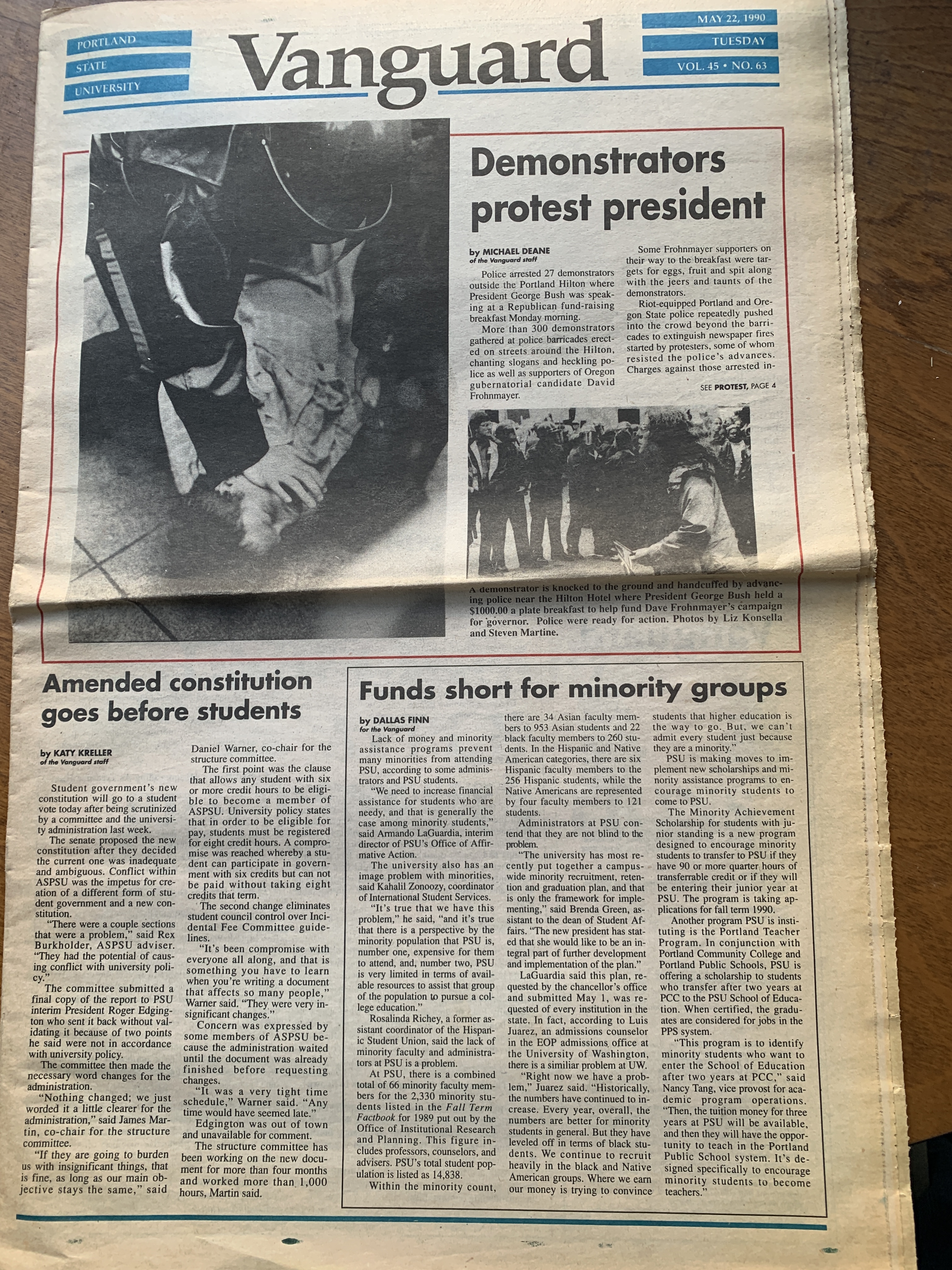
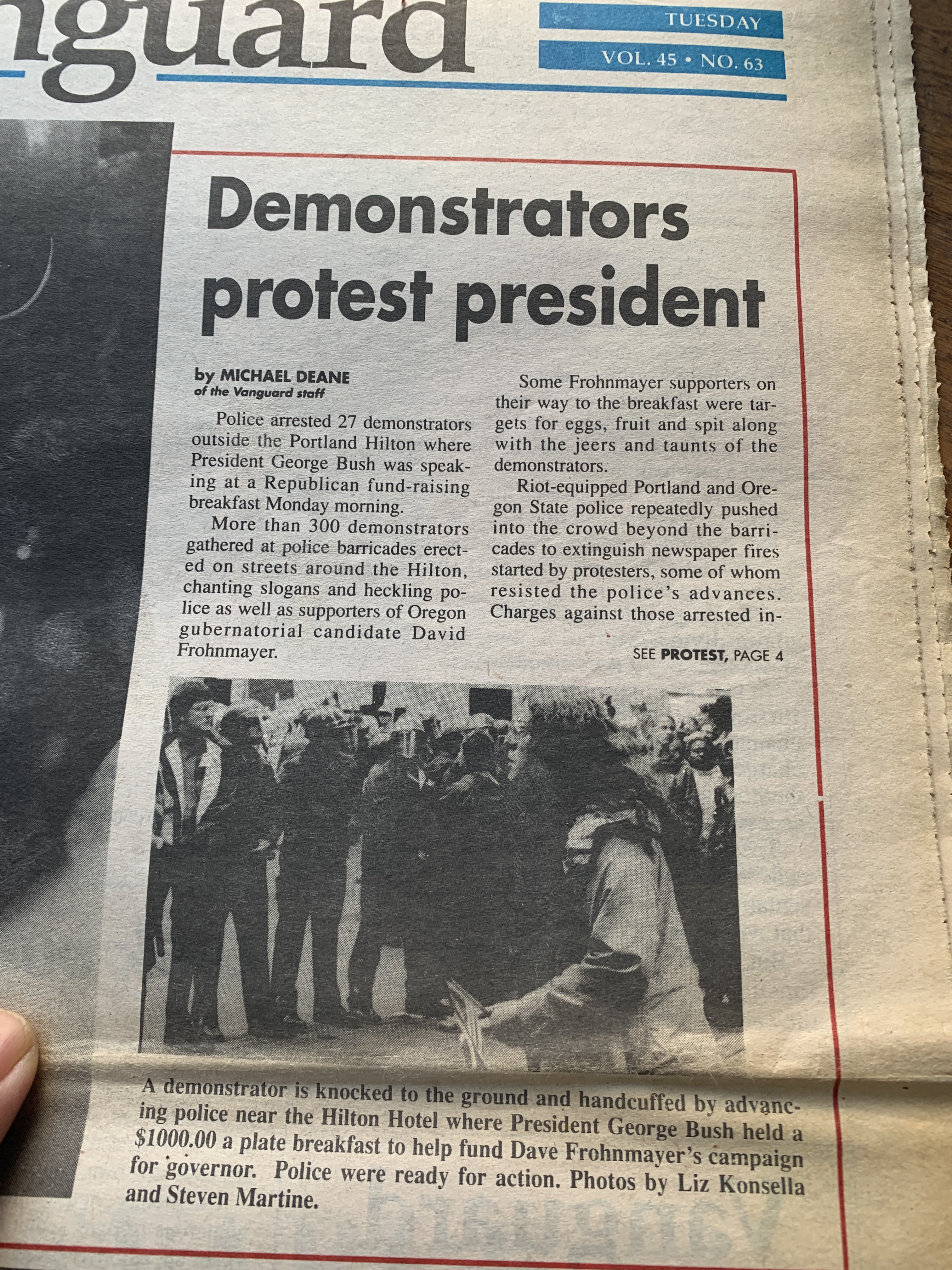
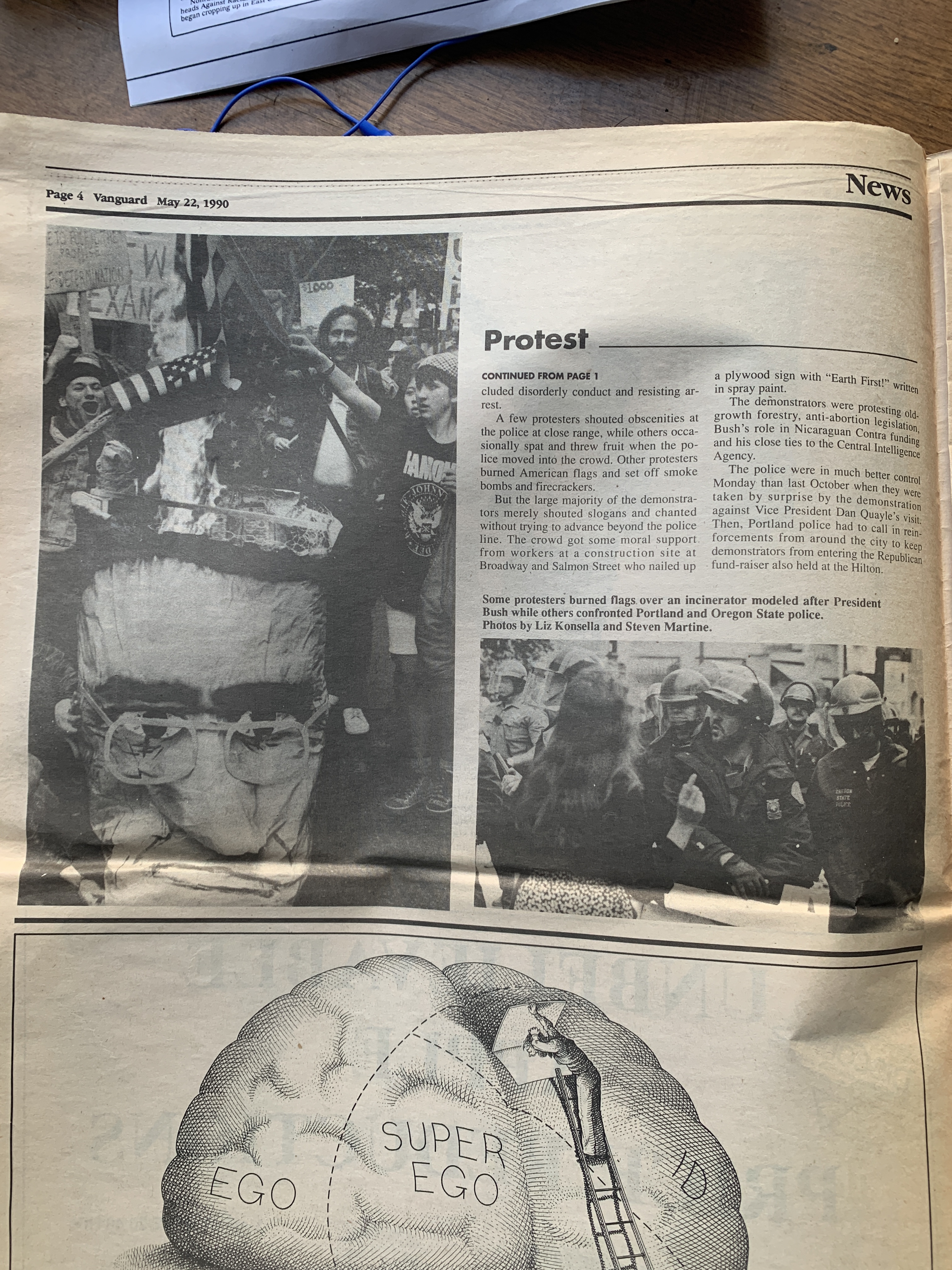
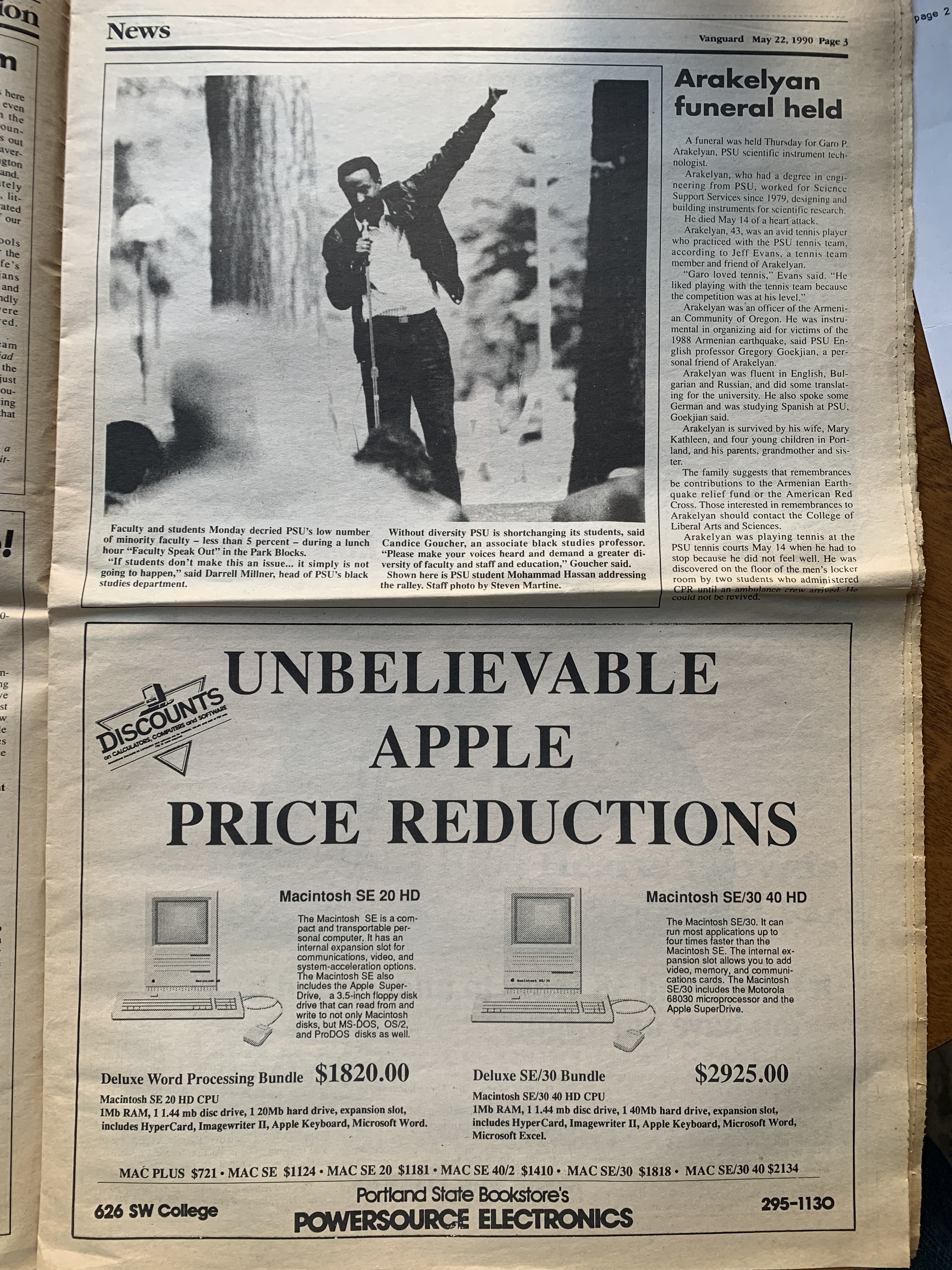
Mohammad Hassan (above) at PSU protesting less than five percent faculty of color at Portland State University. Check out those Apple prices!
May 24, 1990–Judi Bari and Darryl Cherney are victims of a car bomb in Oakland, California just prior to the start of Redwood Summer. Leonard Zeskind and I would later travel to Willits to meet with the two activists. We were invited to research any far-right/state involvement in the assassination attempt. We could never establish who did it, and neither could anyone else. Cointelpro? “Lord’s Avenger?” Still unanswered. RIP Judi.
June 1990–The irreverent “Class War” is being published.
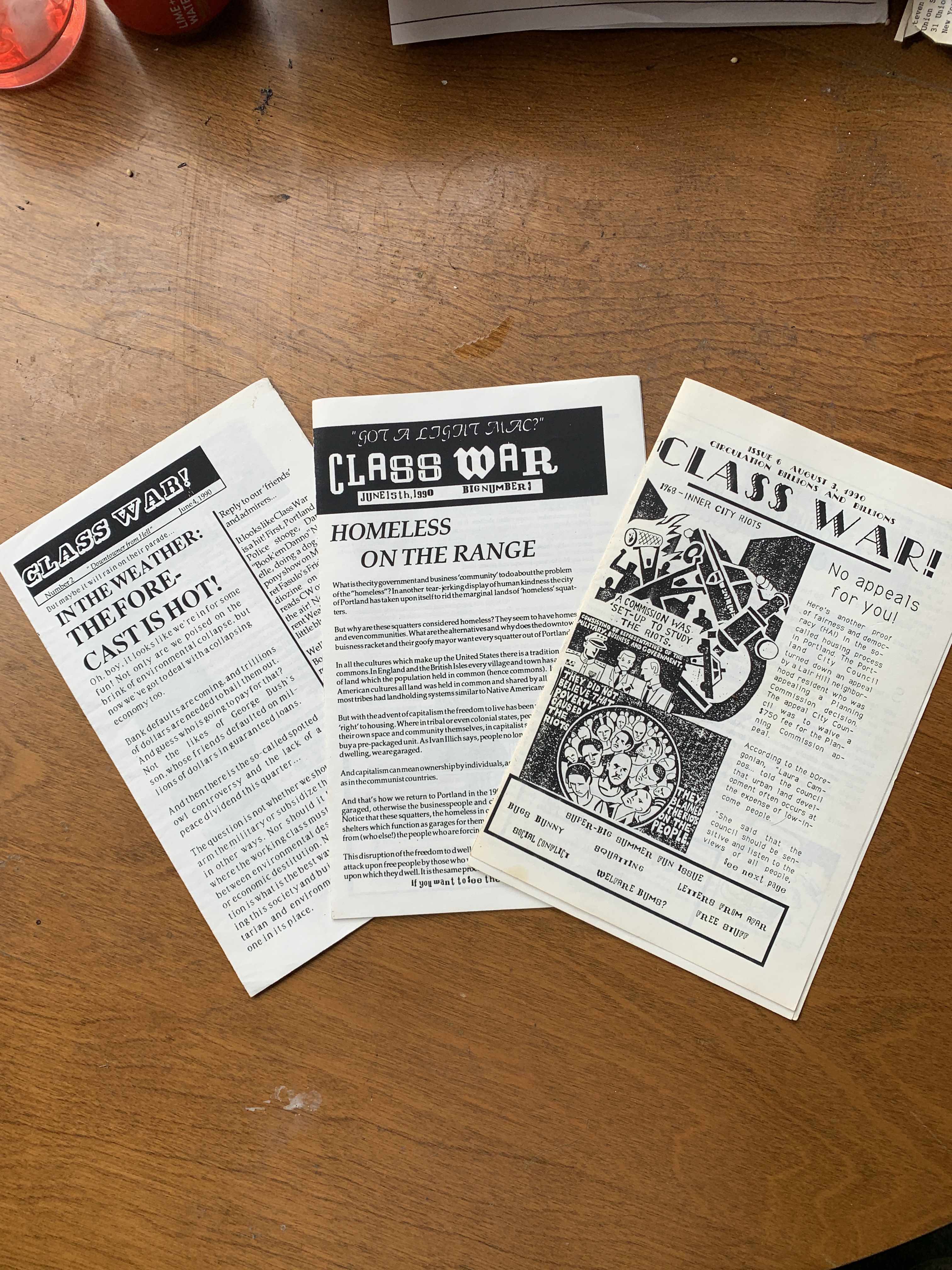
July 16, 1990. Elinor Langer’s “American Neo-Nazi Movement Today” article in The Nation appears.
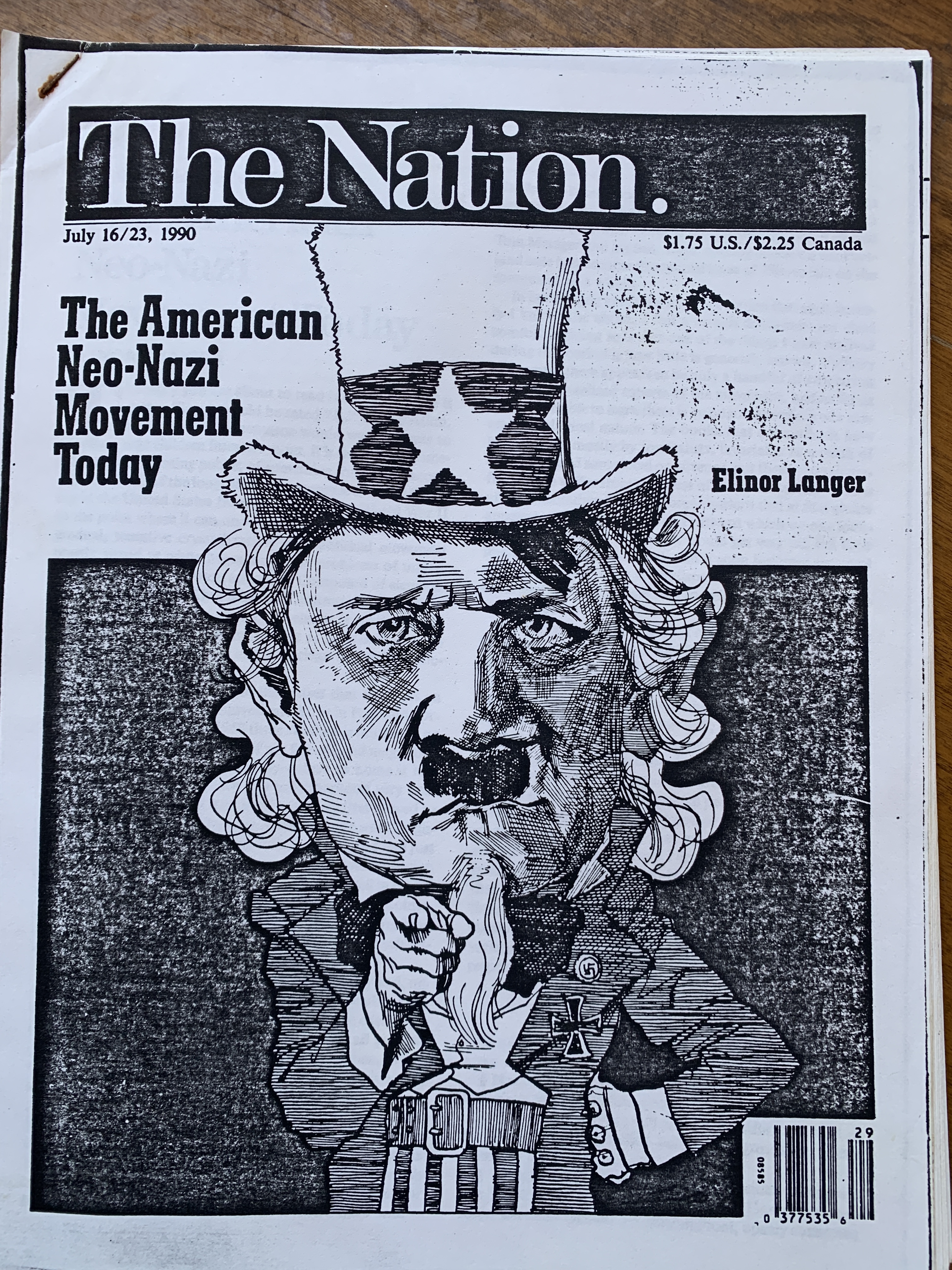
September, 1990–CHD releases “Organized White Supremacists in Oregon”
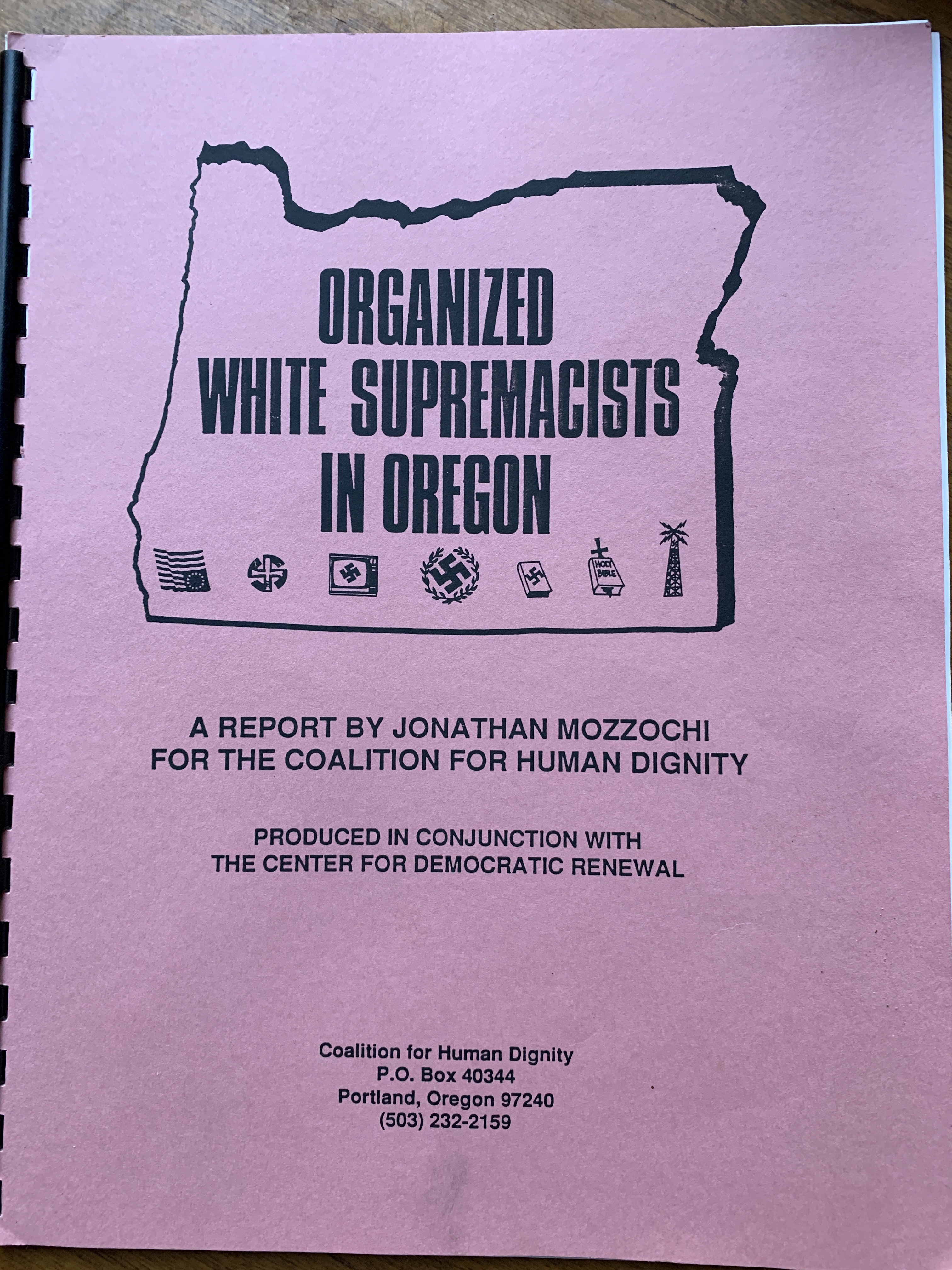
September 1990, Little Beirut III
“Quayle returned in September of 1990 to help raise funds for Oregon Republican candidates and to support an education bill. (This was two years before the American public found out the incumbent vice president couldn’t spell “potato.”) As if hearing his taunt from the year before, there were twice as many protesters outside the Hilton this time. A group of 24 Reed students, including Igor Vamos of the Yes Men fame, dubbed themselves the Guerrilla Theater of the Absurd. They put on their finest suits and ties, swallowed food coloring and ipecac to vomit up red, white and blue—their plan was thwarted because their stomach acid turned the blue food coloring green. This agitprop art display was dubbed the Reverse Peristalsis Painters.
Fifty-one were arrested at this protest, including art gallery and coffee shop owner Anne Hughes, who wound up winning a $25,000 settlement from the city due to her treatment at the hands of the Portland Police Bureau. This event led to Mayor Bud Clark writing a strongly worded letter to the police department.”–WW
I attended the first three Little Beiruts, but not the fourth in 1991 as I had just moved to The Shop and was otherwise occupied.
1990–Lenny Zeskind from the Center for Democratic Renewal and Gerry Gable from Searchlight Magazine in England are hosted at an event at Portland State University.
October, 1990–CHD publishes address of Bob Heick in Portland.
October 7, 1990–2500 people come out for the “March and Rally for Dignity and Diversity” on the day before the SPLC vs. Metzger civil suit begins. Jury came back October 22, 1988. John Trudell and Stew Albert speak, among others.
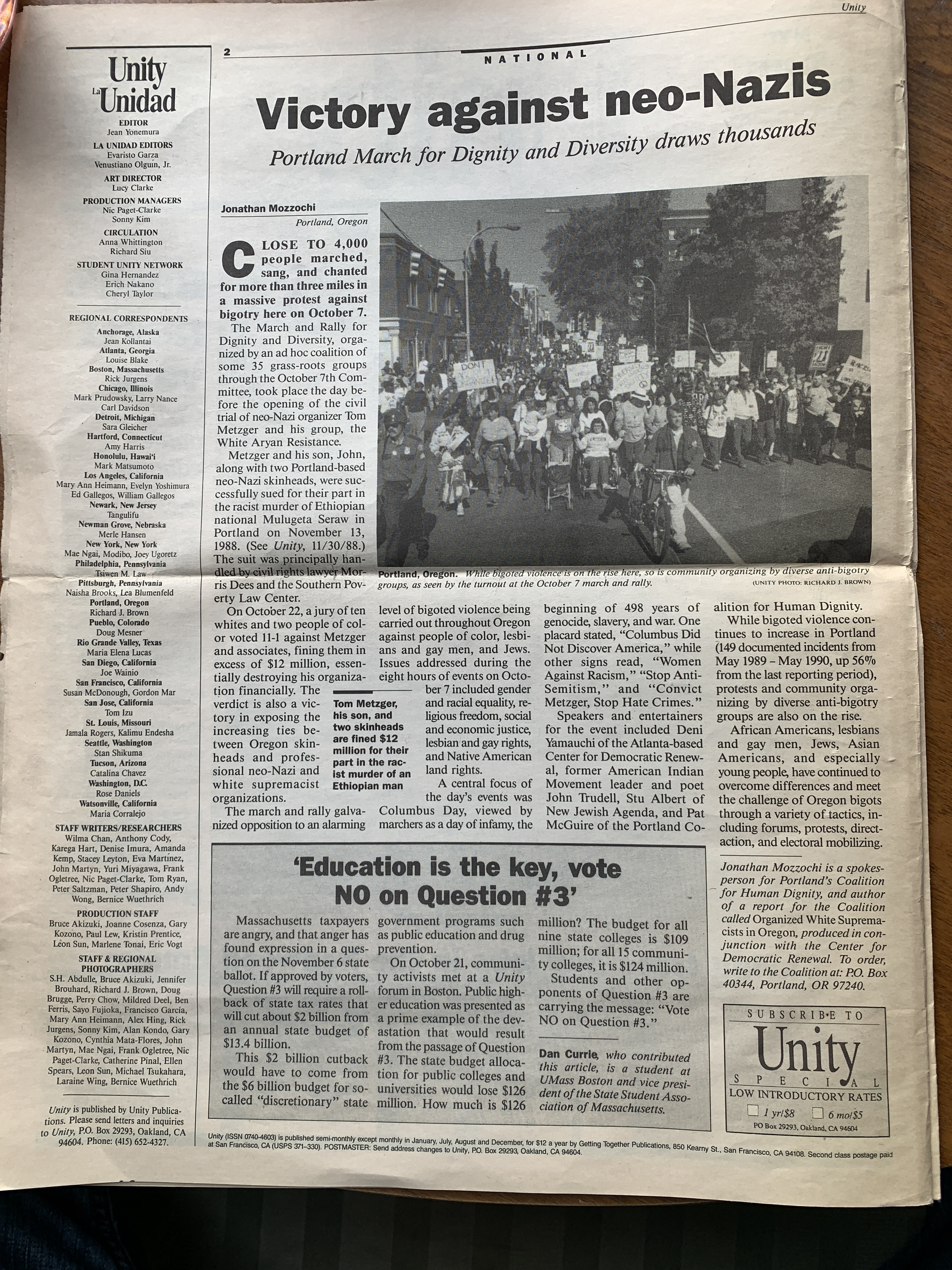
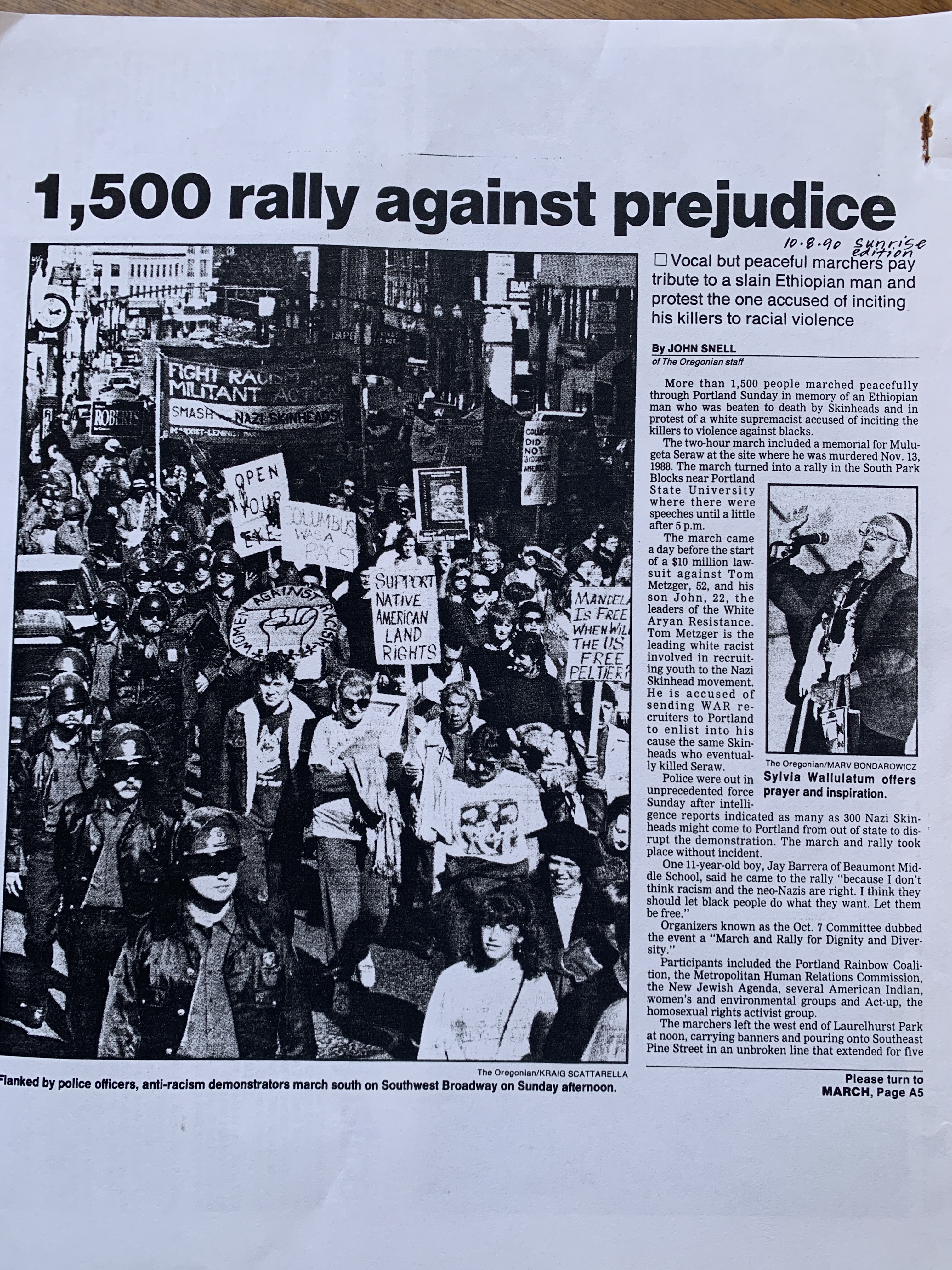
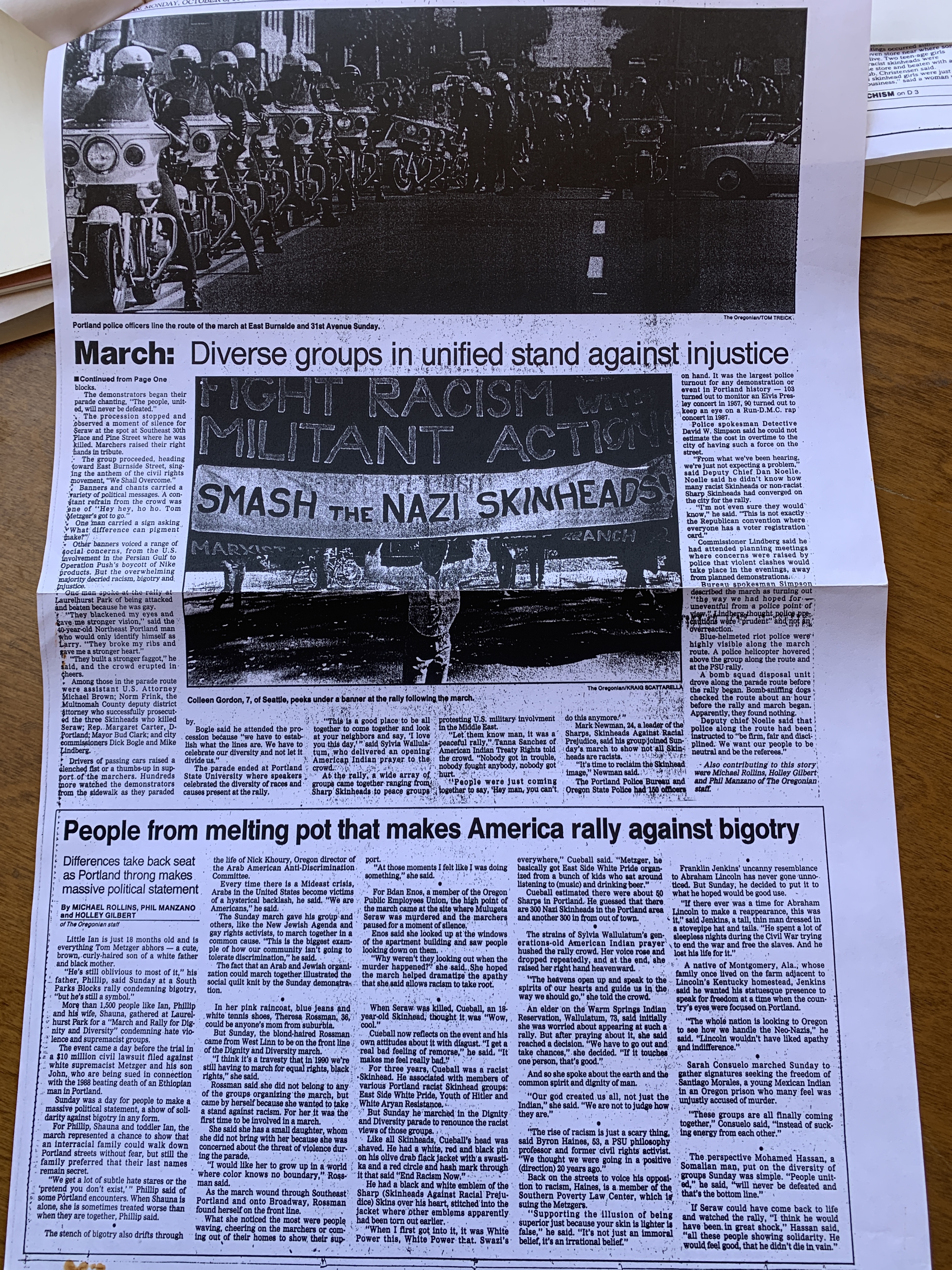
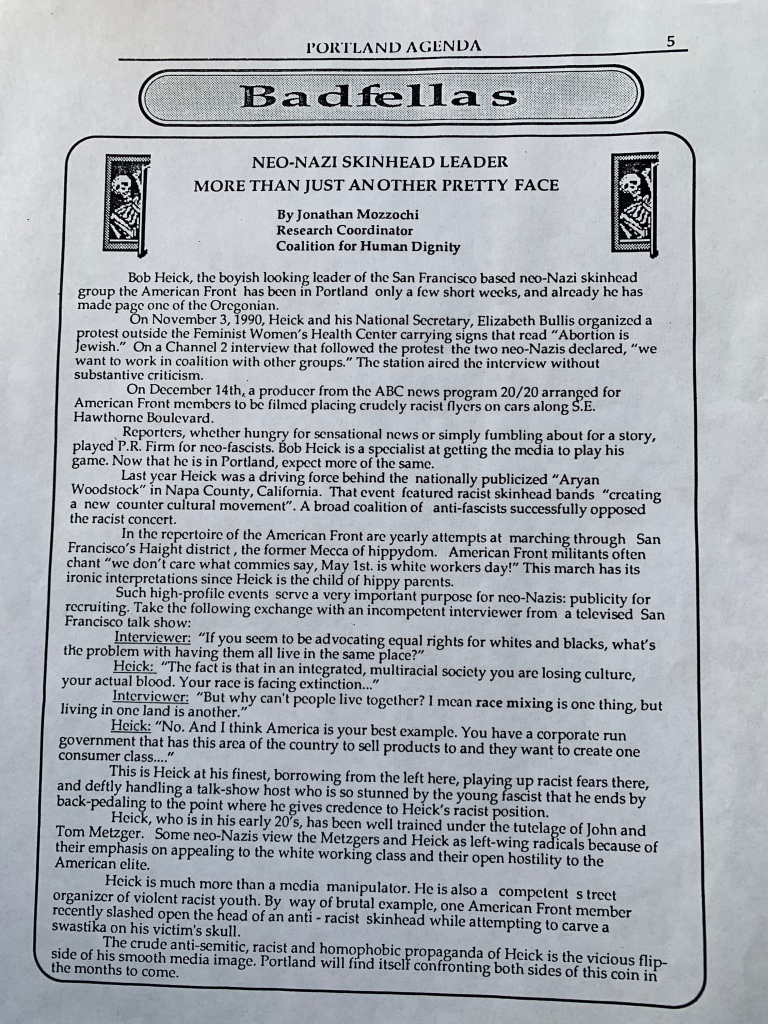
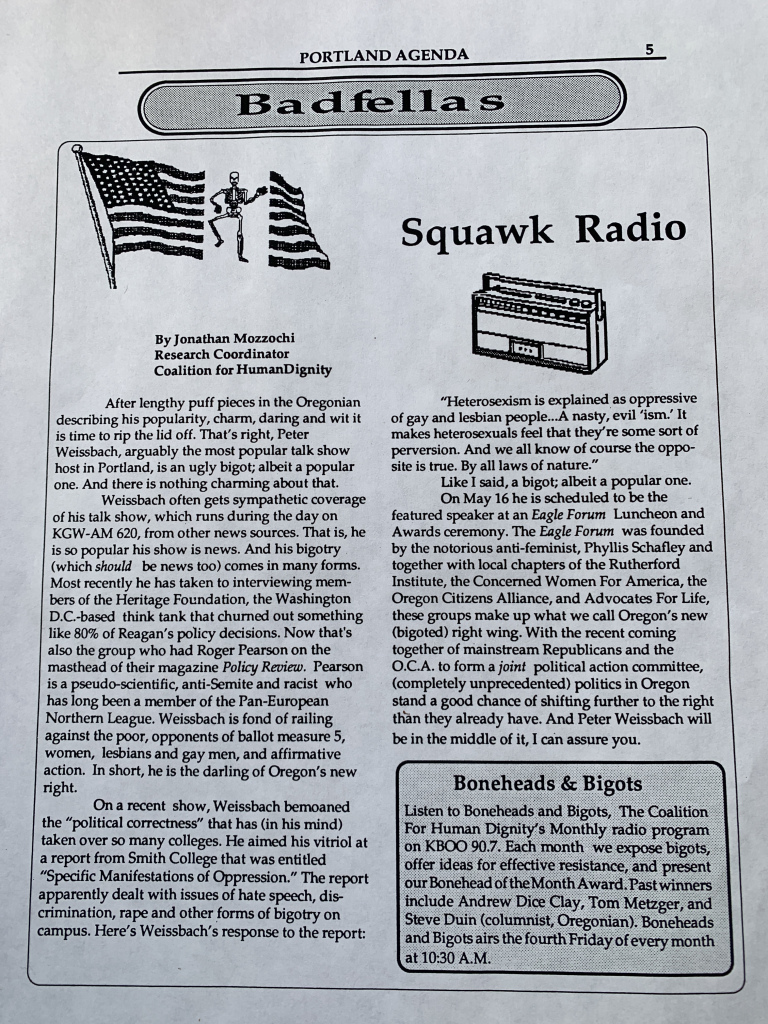
END
Posted in Memoir, Portland Anti-Fascist Archives Project
Tags
anti-fascism, anti-fascist Archives project, antifa, Arditi del popolo, coalition for human dignity, It Did Happen Here KBOO, Little Beirut, Portland Oregon, the Matrix, The Shop
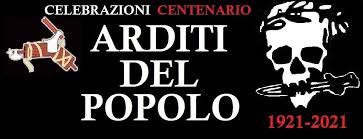
From “The Matrix” to “The Shop”.
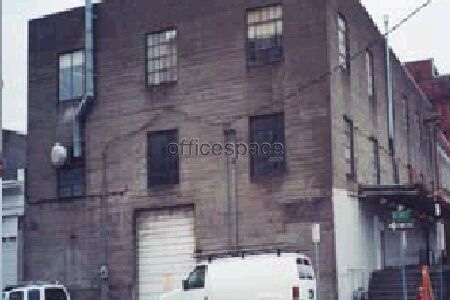
“The Matrix” collective at 333 SE 3rd Street in Portland, Oregon.
“Back in the late 1980s, in the embryonic days of the Coalition for Human Dignity, together with a small group of student radicals I cobbled together something called the Antifascist Archives Project. It amounted to little more than a poster featuring a bundle of sticks with the blade of an axe protruding from the top being broken in half. The symbol is that of the fasces, the Latin term from which fascism derives. We pulled our logo from the militant Italian anti-fascist movement of the 1920s, the Arditi Del Popolo. Together with our fanatic hearts and a pile of research files to inspire the breaking, we began ferreting out fascists wherever they might be, in whatever stage of development they had progressed, at whatever cost to ourselves. We operated from the second floor of a warehouse space located at 333 SE 3rd Street in Portland, Oregon known as “The Matrix.” From the beginning, my antifascism always involved no small amount of rebellion.
Below our second-story ramshackle office was a tortilla chip factory where (in my mind’s olfactory eye) I can still smell those fresh tortillas cooking. After being cut into chips, they would slowly make their way down a small conveyor belt where they would be bagged and often consumed, hot and fresh, by yours truly. My memories of this collective space are bound up with the smell of those tortilla chips and that of another: the fresh ink that emanated from the giant offset printing press which periodically disgorged finished broadsheets for distribution by wild-eyed radicals such as myself.”–—Back to Little Beirut.
“The Matrix” housed many radical political groups, but frequent armed attacks by neo-Nazis throughout 1990-91 had anti-fascists patrolling with rifles from the rooftop. The only entrance to our offices on the second floor was through a steel-reinforced door on a warehouse loading dock. This afforded us some protection. Regardless, our presence endangered activists not accustomed to facing down boneheads. We had to relocate.
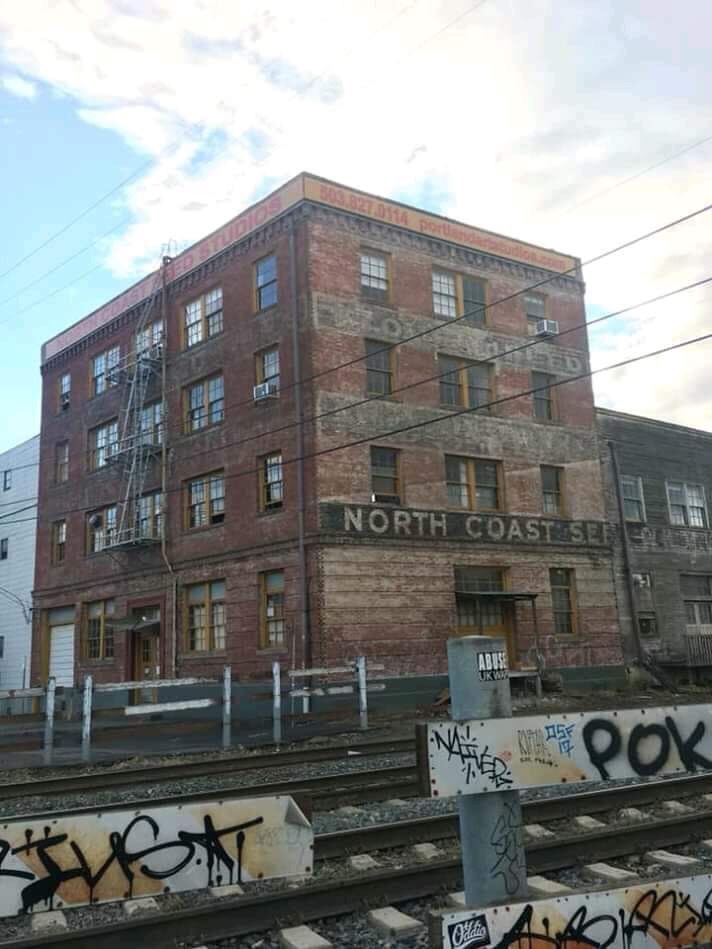
“In winter the rain-soaked Pacific Northwest wind finds its way through split bricks and cracked beams. It is fended off with wood stove and blankets, occasionally the warmth of a kindred spirit. From my office in this ramshackle warehouse, set next to a railroad crossing busy with jostling container cars and the occasional furtive hobo, surrounded by artists, counterculture types, and a few working-class intellectuals (some of whom work at Powell’s Books, a temple for what remains of the graphosphere) I engage in my phantom labor: interrogating the past so as to excavate the future.” —The Trumpen Proletariat Goes to Mars.
Comrades who have been following the “It Did Happen Here” Podcast and KBOO Radio show (https://kboo.fm/program/it-did-happen-here) know that there was a network of anti-racist groups that fought the far-right in the Pacific Northwest (especially Portland, Oregon) from 1988 into the early 2000s. I was a founding member and sometime staffer for the one of the groups profiled, the Coalition for Human Dignity (CHD). CHD was known for cutting-edge research and intelligence that targeted the far-right, together with grassroots community defense efforts. For about ten-years comrades and I waded through newspaper clippings, files, primary documents, databases, videotapes, books and cassette tapes with an eye toward operationalizing our findings. Put another way: Unlike most academics, who often craft elaborate postmortems on this or that element of the far-right, comrades with the Coalition for Human Dignity created our own “facts on the ground.” CHD activists didn’t collect data for posterity; we gathered intelligence to attack the far-right and fascists. In many ways, we were more effective at this than any of our contemporaries.
We also made mistakes, some of which will become apparent throughout these archival posts. That said, beware critics who either knowingly or naïvely wring their hands about this or that tactic wielded by comrades in the fight against the far-right. Too often they forget (if they ever knew) that the far-right and fascism are always present within the United States body politic; regardless of what stage of development such bigoted movements may be in, they must be fought using methodologies unique to those threats. Remember: fighting fascism means fighting fascists.
Today, the far-right and fascist threat is worse than at any time in my 54 years, so too the need to fight back. Trump’s ignominious departure from the White House should provide only cold comfort; the social base and political economy of fascism remain intact.
I offer this archival material so that we might compare and contrast methodologies for fighting the far-right and fascists and thereby improve our fighting capacity. Obviously, the information ecology during the 1980s-1990s was in many ways quite different from that of today — slower, less complex, more centralized, labor intensive, and analog, or pre-digital. I have long argued that the formation of “The Shop” as the intelligence wing of the Coalition for Human Dignity was necessary in order to obtain a comprehensive overview of various far-right formations then active throughout the Pacific Northwest. That overview could not be achieved without the labor-intensive work carried out by staffers and volunteers in the research wing of CHD. It was absolutely essential. In order to aid communities under attack by the far-right — in real-time — one had to operationalize research. One could not possibly coordinate efforts to fight the far-right and defend communities without the most up-to-date research and intelligence. Journalists couldn’t do it, cops were a part of it, politicians were afraid of it and academics were too busy with their post-mortems. At that time there was only one way to do it: “The Shop.”
Some of the archival material I will be posting here I’ve managed to preserve, some I’ve more recently dug up. I left the CHD around 1999 after having transferred the many filing cabinets, videos, databases, and a highly specialized library, to offices in Seattle. Sometime thereafter the group imploded but not before sending the CHD files to a kindred organization in Chicago called the Center for New Community, which also collapsed. Somewhere in these transitions the CHD files were lost or stolen; the activists who are responsible for this shocking neglect of basic movement security and respect for research deserve to be met with the harshest of criticism. You know who you are, and you should be held accountable. Anti-fascists with integrity should revisit this sordid chapter in our history, if for no other reason so as to prevent perhaps some of the same people from doing it again. And again. What happened to the files?
“The Shop” refers to the semi-secret office space maintained by CHD for about six years through a sub-lease from two professional photographers. Thanks to their generosity we were able to file our reports, stuff our filing cabinets, organize our databases, and destabilize and destroy organized bigots. The boneheads never found us, either.
CHD researchers set out to create a hybrid of library science and spycraft to fight the far-right menace. We had some limited success, for a time.
For all those older anti-fascists who have continued doing salt-of-the-earth work, I commend you and offer my sincere appreciation and support. Younger anti-fascists today operate with a sophistication, breadth and effectiveness we could only dream of. Groups like Rose City Antifa and the Pacific Northwest Anti-fascist Workers Collective continue the anti-fascist tradition. But they also face a far more dangerous menace. They need our unwavering support.
As I am no longer technically literate in any 21st-century sense, please excuse in advance what are sure to be many frustrating oversights and discombobulations. If you dig or ask me questions, I’ll do my best to clarify.
In Solidarity—Jonathan.
Allen’s Press Clipping Bureau (Established 1888!)
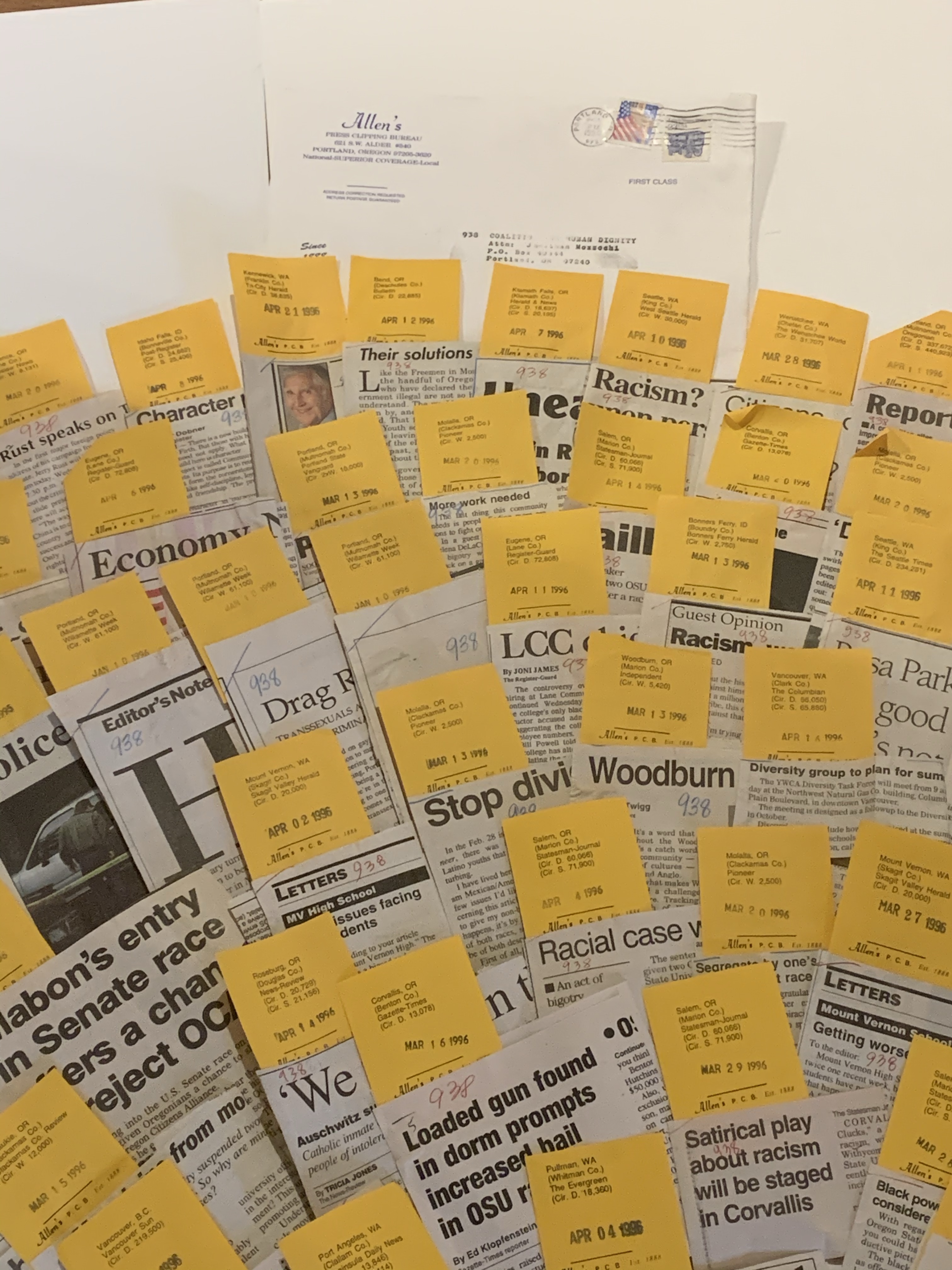
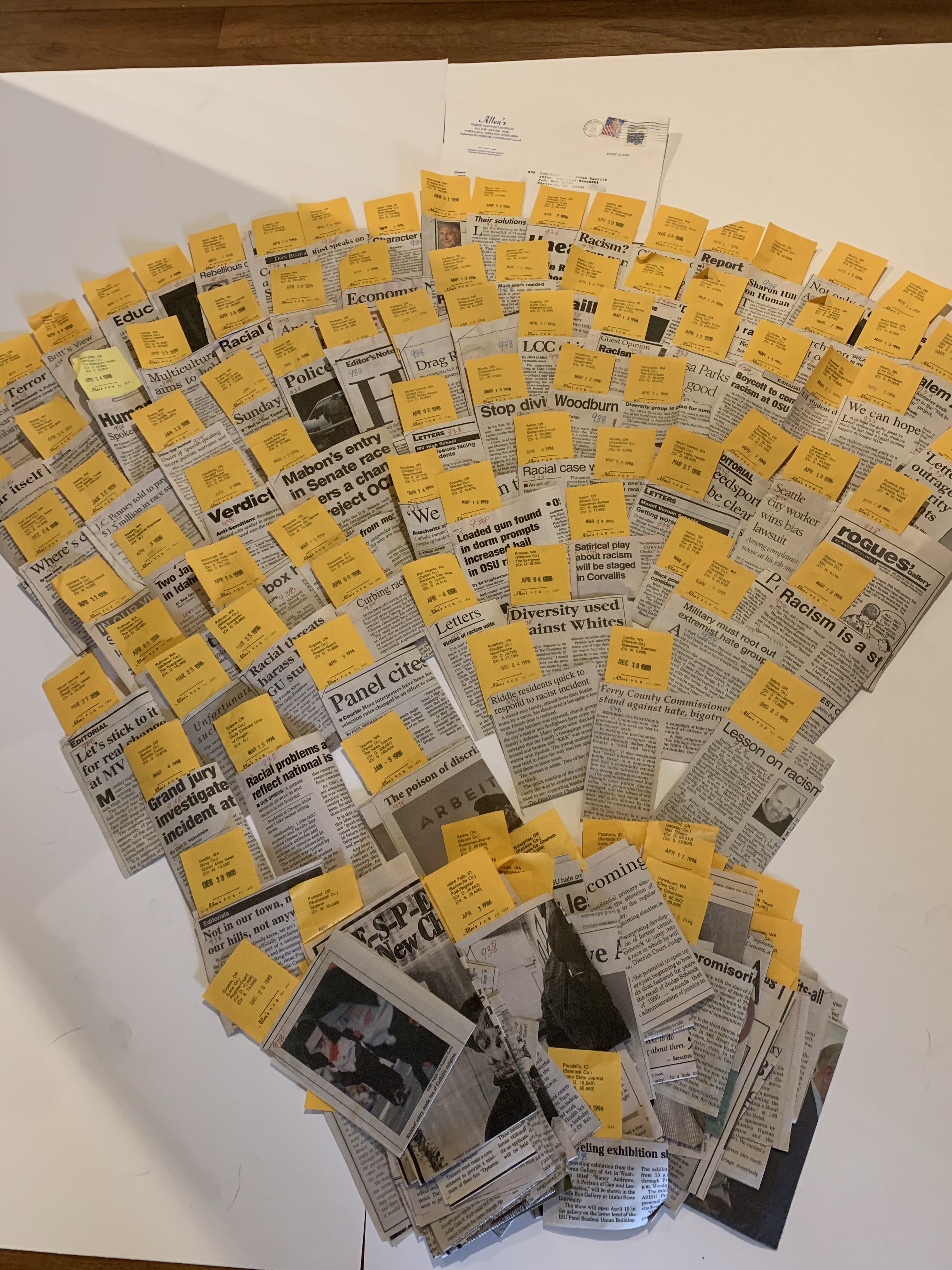
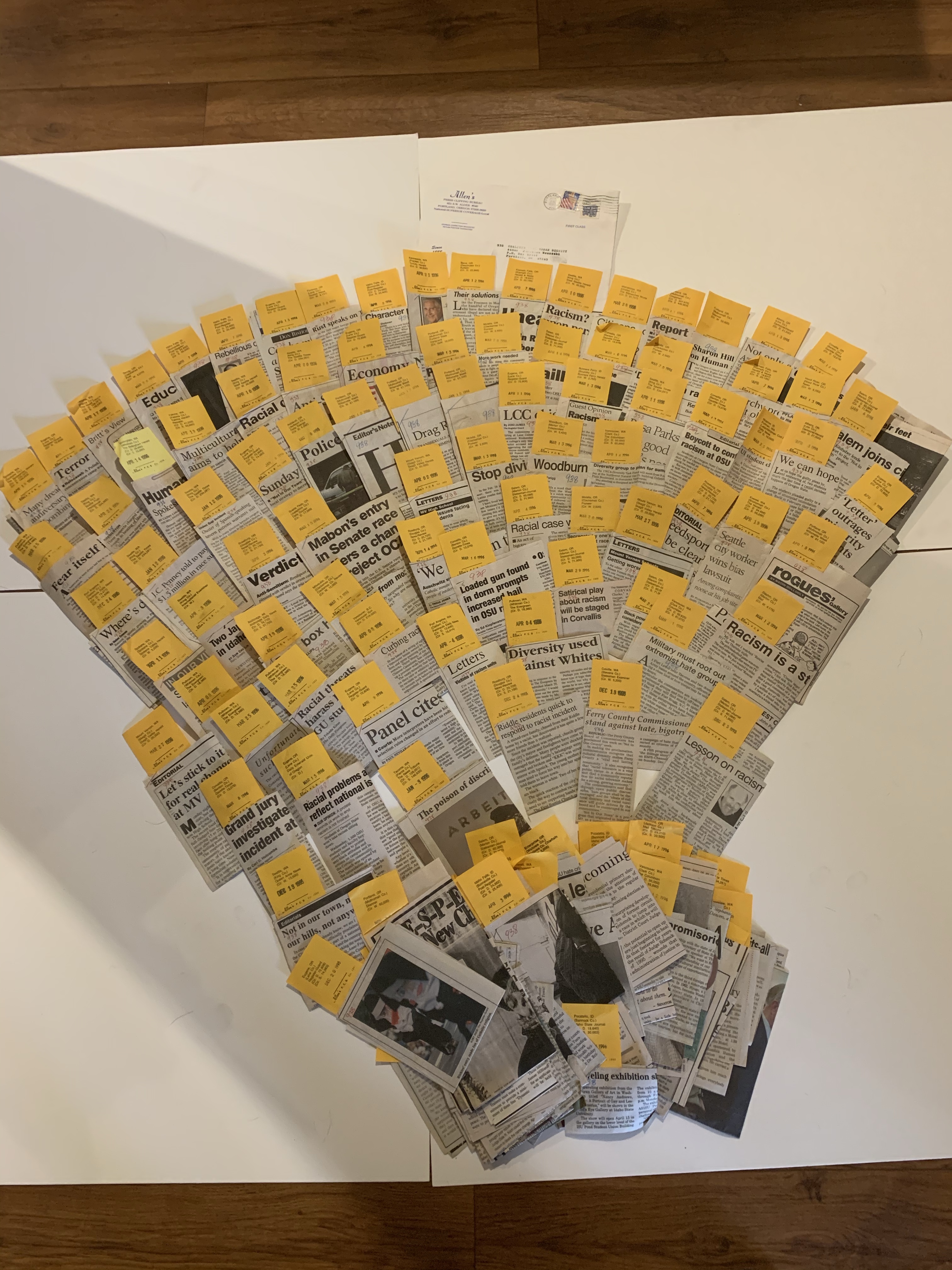
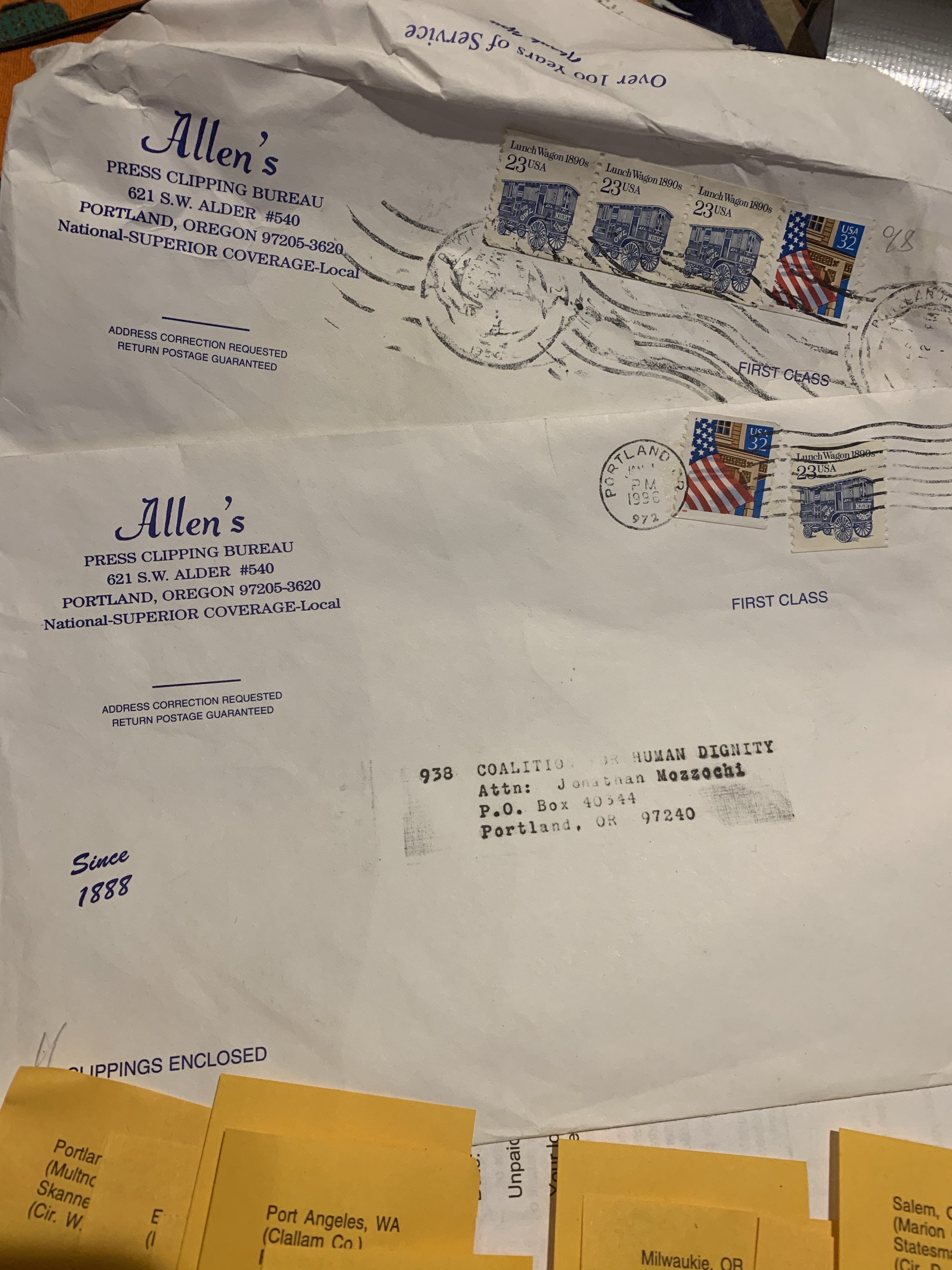
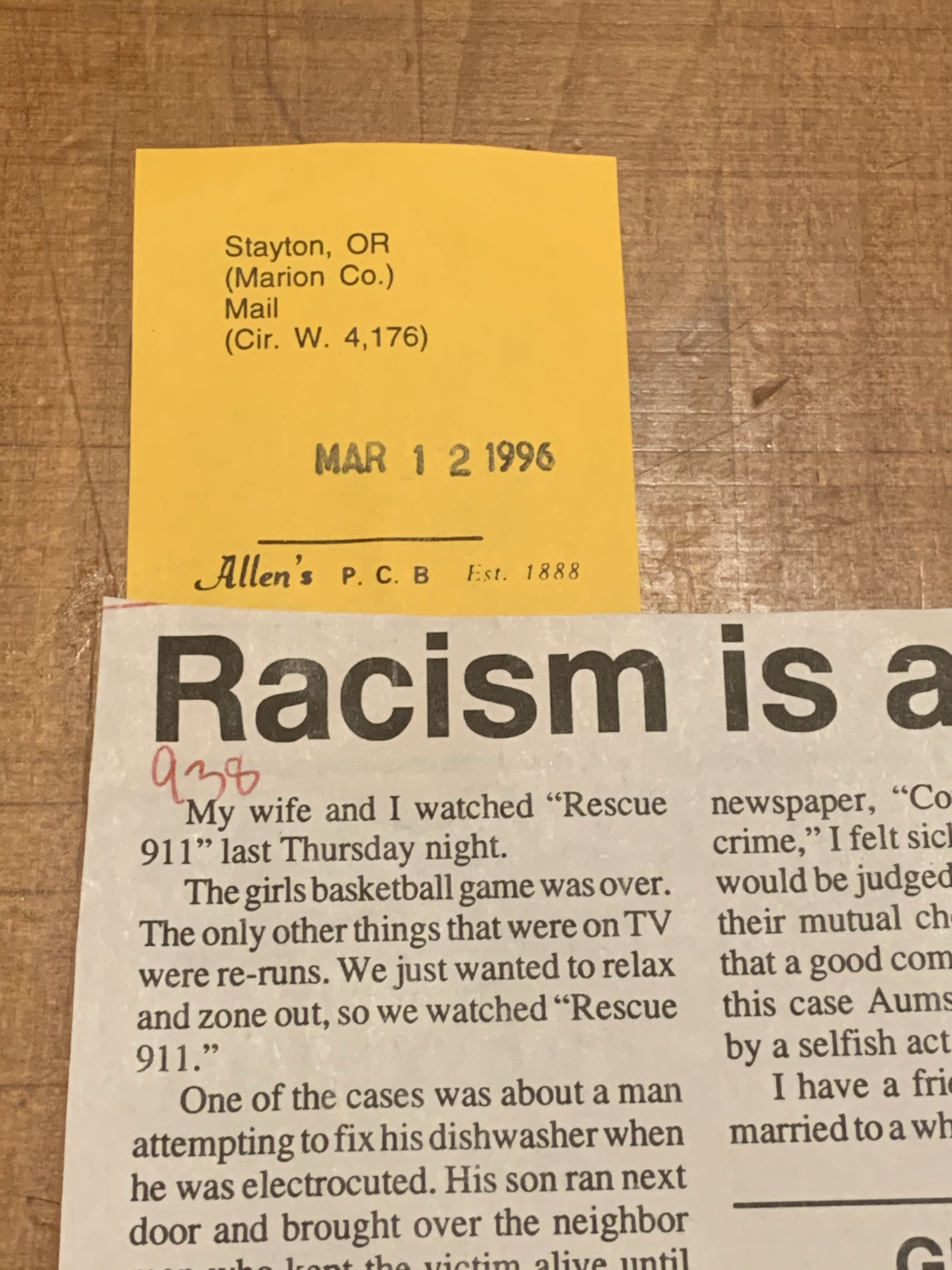
Allen’s Press Clipping Bureau was an important addition to CHD’s toolbox. Allen’s clipped articles from hundreds of newspapers across the Pacific Northwest according to keywords we provided like “racism”, “Measure 9”, and “white supremacist” then stuffed them into envelopes and mailed them to us. We would index these articles according to names, organizations and issues, then enter that information into databases that linked to the clippings, which were in turn photocopied and stored in wire-frame, legal size folders that hung inside Hon brand filing cabinets. Always Hon, always legal size (rather than letter) because there’s nothing like getting 8 1/2 x 14 size documents and trying to fit them in 8 1/2 x 11 folders—it just doesn’t work. This process was expensive and time consuming. Today, such information is generally available to anyone with a cell phone and a search engine. But not then. Did I mention it was expensive? Also, if you try Googling “David Irving 1992 Portland, Oregon” you won’t find much. Like so much of our work it was pre-internet, and has been buried. Let’s dig it up.
END
Blog of the Crowd Counting Consortium
Thoughts on life... by Donald B. Wilson
gehadsjourney.wordpress.com
Recipes showing step by step directions with pictures and a printable recipe card.
The Storyteller (Qissa-Go)
Chronicles of Everyday Life
educator, writer, photographer
"Find what you love and let it kill you." – Charles Bukowski
4 out of 5 dentists recommend this WordPress.com site
Historian. Organizer. Writer.
The Web log of Dr. Joseph Suglia